1. During a routine inspection, a technician discovered that
software that was installed on a computer was secretly collecting data
about websites that were visited by users of the computer. Which type of
threat is affecting this computer?
- DoS attack
- identity theft
- spyware
- zero-day attack
2. Which term refers to a network that provides secure access
to the corporate offices by suppliers, customers and collaborators?
- Internet
- intranet
- extranet
- extendednet
3. A large corporation has modified its network to allow
users to access network resources from their personal laptops and smart
phones. Which networking trend does this describe?
- cloud computing
- online collaboration
- bring your own device
- video conferencing
4. What is an ISP?
- It is a standards body that develops cabling and wiring standards for networking.
- It is a protocol that establishes how computers within a local network communicate.
- It is an organization that enables individuals and businesses to connect to the Internet.
- It is a networking device that combines the functionality of several different networking devices in one.
5. Match the requirements of a reliable network with the supporting network architecture. (Not all options are used.)
6. An employee at a branch office is creating a quote for a
customer. In order to do this, the employee needs to access confidential
pricing information from internal servers at the Head Office. What type
of network would the employee access?
- an intranet
- the Internet
- an extranet
- a local area network
7. Which statement describes the use of powerline networking technology?
- New “smart” electrical cabling is used to extend an existing home LAN.
- A home LAN is installed without the use of physical cabling.
- A device connects to an existing home LAN using an adapter and an existing electrical outlet.
- Wireless access points use powerline adapters to distribute data through the home LAN.
8. A networking technician is working on the wireless network
at a medical clinic. The technician accidentally sets up the wireless
network so that patients can see the medical records data of other
patients. Which of the four network characteristics has been violated in
this situation?
- fault tolerance
- scalability
- security
- Quality of Service (QoS)
- reliability
Explanation:
Network security includes protecting the confidentiality of data that is
on the network. In this case, because confidential data has been made
available to unauthorized users, the security characteristic of the
network has failed.
9. Match each characteristic to its corresponding Internet connectivity type. (Not all options are used.)
CCNA-1-v7-Modules-1-3-Basic Network Connectivity and Communications Exam Answers 09
Explanation: DSL is
an always-on, high bandwidth connection that runs over telephone lines.
Cable uses the same coaxial cable that carries television signals into
the home to provide Internet access. Dialup telephone is much slower
than either DSL or cable, but is the least expensive option for home
users because it can use any telephone line and a simple modem.
Satellite requires a clear line of sight and is affected by trees and
other obstructions. None of these typical home options use dedicated
leased lines such as T1/E1 and T3/E3.
10. What two criteria are used to help select a network medium from various network media? (Choose two.)
- the types of data that need to be prioritized
- the cost of the end devices utilized in the network
- the distance the selected medium can successfully carry a signal
- the number of intermediate devices installed in the network
- the environment where the selected medium is to be installed
11. What type of network traffic requires QoS?
- email
- on-line purchasing
- video conferencing
- wiki
12. A user is implementing security on a small office
network. Which two actions would provide the minimum security
requirements for this network? (Choose two.)
- implementing a firewall
- installing a wireless network
- installing antivirus software
- implementing an intrusion detection system
- adding a dedicated intrusion prevention device
Explanation:
Technically complex security measures such as intrusion prevention and
intrusion prevention systems are usually associated with business
networks rather than home networks. Installing antivirus software,
antimalware software, and implementing a firewall will usually be the
minimum requirements for home networks. Installing a home wireless
network will not improve network security, and will require further
security actions to be taken.
13. Passwords can be used to restrict access to all or parts
of the Cisco IOS. Select the modes and interfaces that can be protected
with passwords. (Choose three.)
- VTY interface
- console interface
- Ethernet interface
- boot IOS mode
- privileged EXEC mode
- router configuration mode
14. Which interface allows remote management of a Layer 2 switch?
- the AUX interface
- the console port interface
- the switch virtual interface
- the first Ethernet port interface
Explanation: In a Layer 2 switch, there is a switch virtual interface (SVI) that provides a means for remotely managing the device.
15. What function does pressing the Tab key have when entering a command in IOS?
- It aborts the current command and returns to configuration mode.
- It exits configuration mode and returns to user EXEC mode.
- It moves the cursor to the beginning of the next line.
- It completes the remainder of a partially typed word in a command.
Explanation: Pressing the Tab key after a command has been partially typed will cause the IOS to complete the rest of the command.
16. While trying to solve a network issue, a technician made
multiple changes to the current router configuration file. The changes
did not solve the problem and were not saved. What action can the
technician take to discard the changes and work with the file in NVRAM?
- Issue the reload command without saving the running configuration.
- Delete the vlan.dat file and reboot the device.
- Close and reopen the terminal emulation software.
- Issue the copy startup-config running-config command.
Explanation: The
technician does not want to make any mistakes trying to remove all the
changes that were done to the running configuration file. The solution
is to reboot the router without saving the running configuration. The
copy startup-config running-config command does not overwrite the
running configuration file with the configuration file stored in NVRAM,
but rather it just has an additive effect.
17. An administrator uses the Ctrl-Shift-6 key combination on
a switch after issuing the ping command. What is the purpose of using
these keystrokes?
- to restart the ping process
- to interrupt the ping process
- to exit to a different configuration mode
- to allow the user to complete the command
18. Refer to the exhibit. A network administrator is
configuring access control to switch SW1. If the administrator uses a
console connection to connect to the switch, which password is needed to
access user EXEC mode?
CCNA-1-v7-Modules-1-3-Basic Network Connectivity and Communications Exam Answers 14
- letmein
- secretin
- lineconin
- linevtyin
Explanation: Telnet
accesses a network device through the virtual interface configured with
the line VTY command. The password configured under this is required to
access the user EXEC mode. The password configured under the line
console 0 command is required to gain entry through the console port,
and the enable and enable secret passwords are used to allow entry into
the privileged EXEC mode.
19. A technician configures a switch with these commands:
SwitchA(config)# interface vlan 1
SwitchA(config-if)# ip address 192.168.1.1 255.255.255.0
SwitchA(config-if)# no shutdown
What is the technician configuring?
- Telnet access
- SVI
- password encryption
- physical switchport access
Explanation: For a
switch to have an IP address, a switch virtual interface must be
configured. This allows the switch to be managed remotely over the
network.
20. Which command or key combination allows a user to return to the previous level in the command hierarchy?
Explanation: End
and CTRL-Z return the user to the privileged EXEC mode. Ctrl-C ends a
command in process. The exit command returns the user to the previous
level.
21. What are two characteristics of RAM on a Cisco device? (Choose two.)
- RAM provides nonvolatile storage.
- The configuration that is actively running on the device is stored in RAM.
- The contents of RAM are lost during a power cycle.
- RAM is a component in Cisco switches but not in Cisco routers.
- RAM is able to store multiple versions of IOS and configuration files.
22. Which two host names follow the guidelines for naming conventions on Cisco IOS devices? (Choose two.)
- Branch2!
- RM-3-Switch-2A4
- Floor(15)
- HO Floor 17
- SwBranch799
Explanation: Some guidelines for naming conventions are that names should:
Start with a letter
Contain no spaces
End with a letter or digit
Use only letters, digits, and dashes
Be less than 64 characters in length
23. How is SSH different from Telnet?
- SSH makes connections over the network, whereas Telnet is for out-of-band access.
- SSH provides security to
remote sessions by encrypting messages and using user authentication.
Telnet is considered insecure and sends messages in plaintext.
- SSH requires the use of the PuTTY terminal emulation program. Tera
Term must be used to connect to devices through the use of Telnet.
- SSH must be configured over an active network connection, whereas
Telnet is used to connect to a device from a console connection.
Explanation: SSH is
the preferred protocol for connecting to a device operating system over
the network because it is much more secure than Telnet. Both SSH and
Telnet are used to connect to devices over the network, and so are both
used in-band. PuTTY and Terra Term can be used to make both SSH and
Telnet connections.
24. An administrator is configuring a switch console port
with a password. In what order will the administrator travel through the
IOS modes of operation in order to reach the mode in which the
configuration commands will be entered? (Not all options are used.)
CCNA-1-v7-Modules-1-3-Basic Network Connectivity and Communications Exam Answers 24
Explanation: The configuration mode that the administrator first encounters is user EXEC mode. After the enable command is entered, the next mode is privileged EXEC mode. From there, the configure terminal command is entered to move to global configuration mode. Finally, the administrator enters the line console 0 command to enter the mode in which the configuration will be entered.
25. What are three characteristics of an SVI? (Choose three.)
- It is designed as a security protocol to protect switch ports.
- It is not associated with any physical interface on a switch.
- It is a special interface that allows connectivity by different types of media.
- It is required to allow connectivity by any device at any location.
- It provides a means to remotely manage a switch.
- It is associated with VLAN1 by default.
Explanation:
Switches have one or more switch virtual interfaces (SVIs). SVIs are
created in software since there is no physical hardware associated with
them. Virtual interfaces provide a means to remotely manage a switch
over a network that is using IP. Each switch comes with one SVI
appearing in the default configuration “out-of-the-box.” The default SVI
interface is VLAN1.
26. What command is used to verify the condition of the
switch interfaces, including the status of the interfaces and a
configured IP address?
- ipconfig
- ping
- traceroute
- show ip interface brief
Explanation: The
show ip interface brief command is used to display a brief synopsis of
the condition of the device interfaces. The ipconfig command is used to
verify TCP/IP properties on a host. The ping command is used to verify
Layer 3 connectivity. The traceroute command is used to trace the
network path from source to destination.
27. Match the description with the associated IOS mode. (Not all options are used.)
28. Match the definitions to their respective CLI hot keys and shortcuts. (Not all options are used.)
29. In the show running-config command, which part of the syntax is represented by running-config?
- the command
- a keyword
- a variable
- a prompt
Explanation: The
first part of the syntax, show, is the command, and the second part of
the syntax, running-config, is the keyword. The keyword specifies what
should be displayed as the output of the show command.
30. After making configuration changes on a Cisco switch, a
network administrator issues a copy running-config startup-config
command. What is the result of issuing this command?
- The new configuration will be stored in flash memory.
- The new configuration will be loaded if the switch is restarted.
- The current IOS file will be replaced with the newly configured file.
- The configuration changes will be removed and the original configuration will be restored.
31. What command will prevent all unencrypted passwords from displaying in plain text in a configuration file?
- (config)# enable password secret
- (config)# enable secret Secret_Password
- (config-line)# password secret
- (config)# service password-encryption
- (config)# enable secret Encrypted_Password
32. A network administrator enters the service
password-encryption command into the configuration mode of a router.
What does this command accomplish?
- This command encrypts passwords as they are transmitted across serial WAN links.
- This command prevents someone from viewing the running configuration passwords.
- This command enables a strong encryption algorithm for the enable secret password command.
- This command automatically encrypts passwords in configuration files that are currently stored in NVRAM.
- This command provides an exclusive encrypted password for external service personnel who are required to do router maintenance.
Explanation: The
startup-config and running-config files display most passwords in
plaintext. Use the service password-encryption global config command to
encrypt all plaintext passwords in these files.
33. What method can be used by two computers to ensure that
packets are not dropped because too much data is being sent too quickly?
- encapsulation
- flow control
- access method
- response timeout
Explanation: In
order for two computers to be able to communicate effectively, there
must be a mechanism that allows both the source and destination to set
the timing of the transmission and receipt of data. Flow control allows
for this by ensuring that data is not sent too fast for it to be
received properly.
34. Which statement accurately describes a TCP/IP encapsulation process when a PC is sending data to the network?
- Data is sent from the internet layer to the network access layer.
- Packets are sent from the network access layer to the transport layer.
- Segments are sent from the transport layer to the internet layer.
- Frames are sent from the network access layer to the internet layer.
Explanation: When
the data is traveling from the PC to the network, the transport layer
sends segments to the internet layer. The internet layer sends packets
to the network access layer, which creates frames and then converts the
frames to bits. The bits are released to the network media.
35. What three application layer protocols are part of the TCP/IP protocol suite? (Choose three.)
Explanation: DNS,
DHCP, and FTP are all application layer protocols in the TCP/IP protocol
suite. ARP and PPP are network access layer protocols, and NAT is an
internet layer protocol in the TCP/IP protocol suite.
36. Match the description to the organization. (Not all options are used.)
37. Which name is assigned to the transport layer PDU?
- bits
- data
- frame
- packet
- segment
Explanation:
Application data is passed down the protocol stack on its way to be
transmitted across the network media. During the process, various
protocols add information to it at each level. At each stage of the
process, a PDU (protocol data unit) has a different name to reflect its
new functions. The PDUs are named according to the protocols of the
TCP/IP suite:
Data – The general term for the PDU used at the application layer.
Segment – transport layer PDU
Packet – network layer PDU
Frame – data link layer PDU
Bits – A physical layer PDU used when physically transmitting data over the medium
38. When IPv4 addressing is manually configured on a web
server, which property of the IPv4 configuration identifies the network
and host portion for an IPv4 address?
- DNS server address
- subnet mask
- default gateway
- DHCP server address
Explanation: There are several components that need to be entered when configuring IPv4 for an end device:
IPv4 address – uniquely identifies an end device on the network
Subnet mask – determines the network address portion and host portion for an IPv4 address
Default gateway – the IP address of the router interface used for communicating with hosts in another network
DNS server address – the IP address of the Domain Name System (DNS) server
DHCP server address (if DHCP is used) is not configured manually on end
devices. It will be provided by a DHCP server when an end device
requests an IP address.
39. What process involves placing one PDU inside of another PDU?
- encapsulation
- encoding
- segmentation
- flow control
Explanation: When a
message is placed inside of another message, this is known as
encapsulation. On networks, encapsulation takes place when one protocol
data unit is carried inside of the data field of the next lower protocol
data unit.
40. What layer is responsible for routing messages through an internetwork in the TCP/IP model?
- internet
- transport
- network access
- session
Explanation: The
TCP/IP model consists of four layers: application, transport, internet,
and network access. Of these four layers, it is the internet layer that
is responsible for routing messages. The session layer is not part of
the TCP/IP model but is rather part of the OSI model.
41. For the TCP/IP protocol suite, what is the correct order
of events when a Telnet message is being prepared to be sent over the
network?
CCNA-1-v7-Modules-1-3-Basic Network Connectivity and Communications Exam Answers 41
- file
- frame
- packet
- segment
Explanation: When
received at the physical layer of a host, the bits are formatted into a
frame at the data link layer. A packet is the PDU at the network layer. A
segment is the PDU at the transport layer. A file is a data structure
that may be used at the application layer.
43. Refer to the exhibit. ServerB is attempting to contact
HostA. Which two statements correctly identify the addressing that
ServerB will generate in the process? (Choose two.)
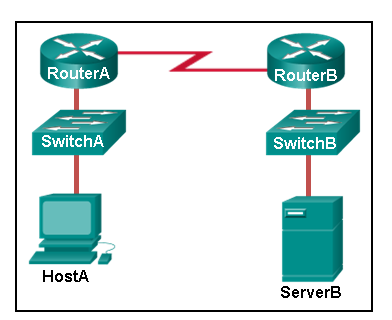
- ServerB will generate a packet with the destination IP address of RouterB.
- ServerB will generate a frame with the destination MAC address of SwitchB.
- ServerB will generate a packet with the destination IP address of RouterA.
- ServerB will generate a frame with the destination MAC address of RouterB.
- ServerB will generate a packet with the destination IP address of HostA.
- ServerB will generate a frame with the destination MAC address of RouterA.
44. Which method allows a computer to react accordingly when
it requests data from a server and the server takes too long to respond?
- encapsulation
- flow control
- access method
- response timeout
45. A web client is receiving a response for a web page from a
web server. From the perspective of the client, what is the correct
order of the protocol stack that is used to decode the received
transmission?
- Ethernet, IP, TCP, HTTP
- HTTP, TCP, IP, Ethernet
- Ethernet, TCP, IP, HTTP
- HTTP, Ethernet, IP, TCP
Explanation:
1. HTTP governs the way that a web server and client interact.
2. TCP manages individual conversations between web servers and clients.
3. IP is responsible for delivery across the best path to the destination.
4. Ethernet takes the packet from IP and formats it for transmission.
46. Which two OSI model layers have the same functionality as a single layer of the TCP/IP model? (Choose two.)
- data link
- network
- physical
- session
- transport
47. At which layer of the OSI model would a logical address be added during encapsulation?
- physical layer
- data link layer
- network layer
- transport layer
48. What is a characteristic of multicast messages?
- They are sent to a select group of hosts.
- They are sent to all hosts on a network.
- They must be acknowledged.
- They are sent to a single destination.
Explanation: Multicast is a one-to-many type of communication. Multicast messages are addressed to a specific multicast group.
49. Which statement is correct about network protocols?
- Network protocols define the type of hardware that is used and how it is mounted in racks.
- They define how messages are exchanged between the source and the destination.
- They all function in the network access layer of TCP/IP.
- They are only required for exchange of messages between devices on remote networks.
50. What is an advantage of network devices using open standard protocols?
- Network communications is confined to data transfers between devices from the same vendor.
- A client host and a server running different operating systems can successfully exchange data.
- Internet access can be controlled by a single ISP in each market.
- Competition and innovation are limited to specific types of products.
51. Which device performs the function of determining the path that messages should take through internetworks?
- a router
- a firewall
- a web server
- a DSL modem
Explanation: A
router is used to determine the path that the messages should take
through the network. A firewall is used to filter incoming and outgoing
traffic. A DSL modem is used to provide Internet connection for a home
or an organization.
52. Open the PT Activity. Perform the tasks in the activity instructions and then answer the question.
CCNA-1-v7-Modules-1-3-Basic Network Connectivity and Communications Exam Answers 52
- 192.168.5.10
- 192.168.10.5
- 192.168.10.1
- 192.168.5.0
Explanation: After
the enable command is issued, the show running-configuration command or
the show ip interfaces brief command will display the IP address of the
switch virtual interface (SVI).
53. Why would a Layer 2 switch need an IP address?
- to enable the switch to send broadcast frames to attached PCs
- to enable the switch to function as a default gateway
- to enable the switch to be managed remotely
- to enable the switch to receive frames from attached PCs
Explanation: A
switch, as a Layer 2 device, does not need an IP address to transmit
frames to attached devices. However, when a switch is accessed remotely
through the network, it must have a Layer 3 address. The IP address must
be applied to a virtual interface rather than to a physical interface.
Routers, not switches, function as default gateways.
54. Refer to the exhibit. An administrator is trying to
configure the switch but receives the error message that is displayed in
the exhibit. What is the problem?

CCNA-1-v7-Modules-1-3-Basic Network Connectivity and Communications Exam Answers 54
- The entire command, configure terminal, must be used.
- The administrator is already in global configuration mode.
- The administrator must first enter privileged EXEC mode before issuing the command.
- The administrator must connect via the console port to access global configuration mode.
Explanation: In
order to enter global configuration mode, the command configure
terminal, or a shortened version such as config t, must be entered from
privileged EXEC mode. In this scenario the administrator is in user EXEC
mode, as indicated by the > symbol after the hostname. The
administrator would need to use the enable command to move into
privileged EXEC mode before entering the configure terminal command.
55. What term describes a network owned by one organization
that provides safe and secure access to individuals who work for a
different organization?
- extranet
- cloud
- BYOD
- quality of service
56. What term describes storing personal files on servers
over the internet to provide access anywhere, anytime, and on any
device?
- cloud
- BYOD
- quality of service
- converged network
57. What term describes a network where one computer can be both client and server?
- peer-to-peer
- cloud
- BYOD
- quality of service
58. What term describes a type of network used by people who work from home or from a small remote office?
- SOHO network
- BYOD
- quality of service
- converged network
59. What term describes a computing model where server software runs on dedicated computers?
- client/server
- internet
- intranet
- extranet
60. What term describes a type of network used by people who work from home or from a small remote office?
- SOHO network
- internet
- intranet
- extranet
61. What term describes a technology that allows devices to connect to the LAN using an electrical outlet?
- powerline networking
- internet
- intranet
- extranet
62. What term describes a policy that allows network devices to manage the flow of data to give priority to voice and video?
- quality of service
- internet
- intranet
- extranet
63. What term describes a private collection of LANs and WANs that belongs to an organization?
- intranet
- internet
- extranet
- peer-to-peer
64. What term describes the ability to use personal devices across a business or campus network?
- BYOD
- internet
- intranet
- extranet
65. At which OSI layer is a source IP address added to a PDU during the encapsulation process?
- network layer
- data link layer
- transport layer
- application layer
66. At which OSI layer is a destination port number added to a PDU during the encapsulation process?
- transport layer
- data link layer
- network layer
- application layer
67. At which OSI layer is data added to a PDU during the encapsulation process?
- application layer
- data link layer
- network layer
- transport layer
68. At which OSI layer is a source IP address added to a PDU during the encapsulation process?
- network layer
- data link layer
- application layer
- presentation layer
69. At which OSI layer is data added to a PDU during the encapsulation process?
- application layer
- transport layer
- network layer
- presentation layer
70. At which OSI layer is a destination IP address added to a PDU during the encapsulation process?
- network layer
- application layer
- transport layer
- presentation layer
71. At which OSI layer is a source MAC address added to a PDU during the encapsulation process?
- data link layer
- application layer
- transport layer
- presentation layer
72. At which OSI layer is a source port number added to a PDU during the encapsulation process?
- transport layer
- application layer
- network layer
- presentation layer
73. At which OSI layer is a destination MAC address added to a PDU during the encapsulation process?
- data link layer
- transport layer
- application layer
- network layer
74. At which OSI layer is a source port number added to a PDU during the encapsulation process?
- transport layer
- network layer
- application layer
- data link layer
75. What is the purpose of the OSI physical layer?
- controlling access to media
- transmitting bits across the local media
- performing error detection on received frames
- exchanging frames between nodes over physical network media
76. Why are two strands of fiber used for a single fiber optic connection?
- The two strands allow the data to travel for longer distances without degrading.
- They prevent crosstalk from causing interference on the connection.
- They increase the speed at which the data can travel.
- They allow for full-duplex connectivity.
77. Which characteristic describes crosstalk?
- the distortion of the network signal from fluorescent lighting
- the distortion of the transmitted messages from signals carried in adjacent wires
- the weakening of the network signal over long cable lengths
- the loss of wireless signal over excessive distance from the access point
78. Which procedure is used to reduce the effect of crosstalk in copper cables?
- requiring proper grounding connections
- twisting opposing circuit wire pairs together
- wrapping the bundle of wires with metallic shielding
- designing a cable infrastructure to avoid crosstalk interference
- avoiding sharp bends during installation
79. Match the situation with the appropriate use of network media.
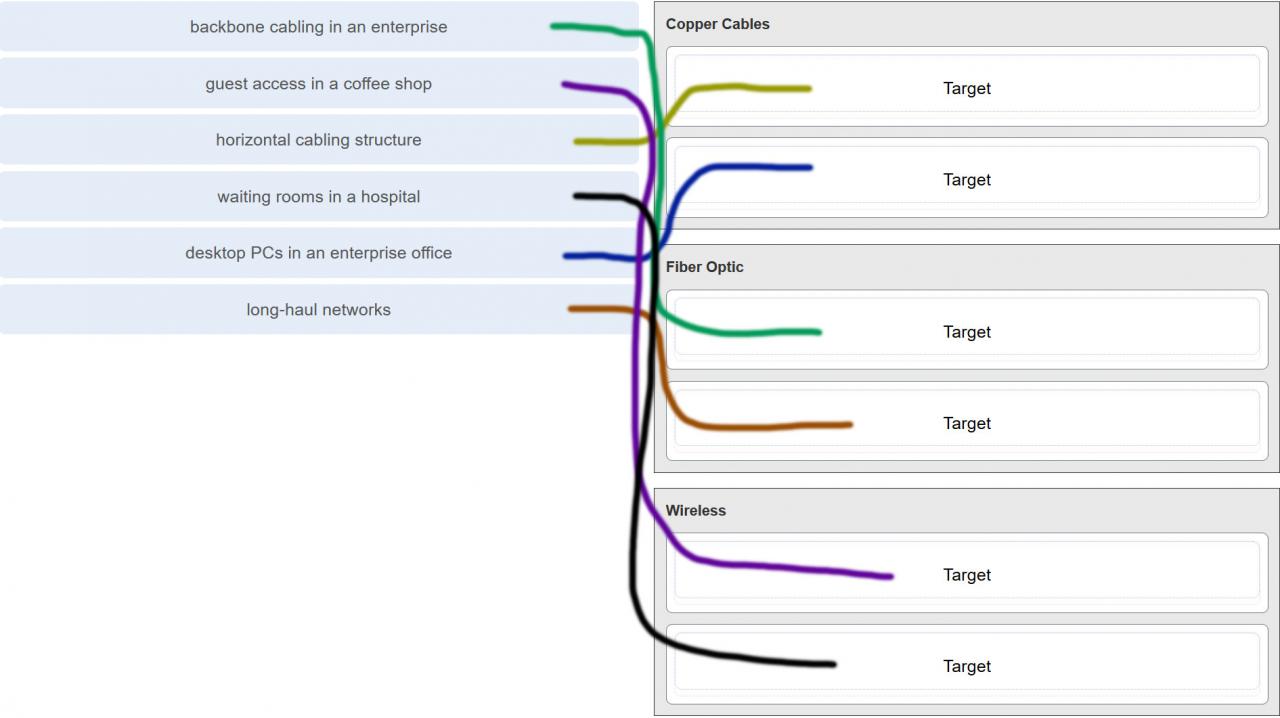 80. A network administrator is measuring the transfer of bits
across the company backbone for a mission critical financial
application. The administrator notices that the network throughput
appears lower than the bandwidth expected. Which three factors could
influence the differences in throughput? (Choose three.)
80. A network administrator is measuring the transfer of bits
across the company backbone for a mission critical financial
application. The administrator notices that the network throughput
appears lower than the bandwidth expected. Which three factors could
influence the differences in throughput? (Choose three.)
- the amount of traffic that is currently crossing the network
- the sophistication of the encapsulation method applied to the data
- the type of traffic that is crossing the network
- the latency that is created by the number of network devices that the data is crossing
- the bandwidth of the WAN connection to the Internet
- the reliability of the gigabit Ethernet infrastructure of the backbone
81. What are two characteristics of fiber-optic cable? (Choose two.)
- It is not affected by EMI or RFI.
- Each pair of cables is wrapped in metallic foil.
- It combines the technique of cancellation, shielding, and twisting to protect data.
- It typically contains 4 pairs of fiber-optic wires.
- It is more expensive than UTP cabling is.
82. What is a primary role of the Physical layer in transmitting data on the network?
- create the signals that represent the bits in each frame on to the media
- provide physical addressing to the devices
- determine the path packets take through the network
- control data access to the media
Explanation: The
OSI physical layer provides the means to transport the bits that make up
a frame across the network media. This layer accepts a complete frame
from the data link layer and encodes it as a series of signals that are
transmitted to the local media.
83. With the use of unshielded twisted-pair copper wire in a network, what causes crosstalk within the cable pairs?
- the magnetic field around the adjacent pairs of wire
- the use of braided wire to shield the adjacent wire pairs
- the reflection of the electrical wave back from the far end of the cable
- the collision caused by two nodes trying to use the media simultaneously
Explanation:
Crosstalk is a type of noise, or interference that occurs when signal
transmission on one wire interferes with another wire. When current
flows through a wire a magnetic field is produced. The produced magnetic
field will interface the signal carried in the adjacent wire.
84. Refer to the graphic. What type of cabling is shown?
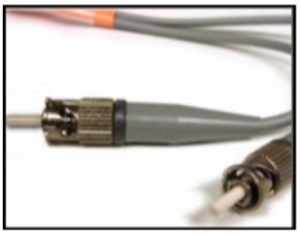
Explanation: Network cabling include different types of cables:
- UTP cable consists of four pairs of color-coded wires that have been
twisted together and then encased in a flexible plastic sheath.
- STP cable uses four pairs of wires, each wrapped in a foil shield, which are then wrapped in an overall metallic braid or foil.
- Coaxial cable uses a copper conductor and a layer of flexible plastic insulation surrounds the copper conductor.
- Fiber cable is a flexible, extremely thin, transparent strand of glass surrounded by plastic insulation.
85. In addition to the cable length, what two factors could
interfere with the communication carried over UTP cables? (Choose two.)
- crosstalk
- bandwidth
- size of the network
- signal modulation technique
- electromagnetic interference
Explanation: Copper
media is widely used in network communications. However, copper media
is limited by distance and signal interference. Data is transmitted on
copper cables as electrical pulses. The electrical pulses are
susceptible to interference from two sources:
- Electromagnetic interference (EMI) or radio frequency interference (RFI) – EMI and RFI signals can distort and corrupt the data signals being carried by copper media.
- Crosstalk – Crosstalk is a disturbance caused by
the electric or magnetic fields of a signal on one wire interfering with
the signal in an adjacent wire.
86. Refer to the graphic. What type of cabling is shown?
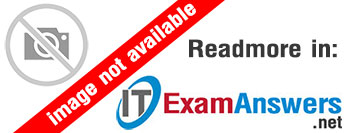 87. Which two devices commonly affect wireless networks? (Choose two.)
87. Which two devices commonly affect wireless networks? (Choose two.)
- Blu-ray players
- home theaters
- cordless phones
- microwaves
- incandescent light bulbs
- external hard drives
Explanation: Radio
Frequency Interference (RFI) is the interference that is caused by radio
transmitters and other devices that are transmitting in the same
frequency.
88. Which two statements describe the services provided by the data link layer? (Choose two.)
- It defines the end-to-end delivery addressing scheme.
- It maintains the path between the source and destination devices during the data transmission.
- It manages the access of frames to the network media.
- It provides reliable delivery through link establishment and flow control.
- It ensures that application data will be transmitted according to the prioritization.
- It packages various Layer 3 PDUs into a frame format that is compatible with the network interface.
Explanation: The
data link layer is divided into two sub layers, namely Logical Link
Control (LLC) and Media Access Control (MAC). LLC forms a frame from the
network layer PDU into a format that conforms to the requirements of
the network interface and media. A network layer PDU might be for IPv4
or IPv6. The MAC sub layer defines the media access processes performed
by the hardware. It manages the frame access to the network media
according to the physical signaling requirements (copper cable, fiber
optic, wireless, etc.)
89. What is the function of the CRC value that is found in the FCS field of a frame?
- to verify the integrity of the received frame
- to verify the physical address in the frame
- to verify the logical address in the frame
- to compute the checksum header for the data field in the frame
90. What is contained in the trailer of a data-link frame?
- logical address
- physical address
- data
- error detection
91. Which statement describes a characteristic of the frame header fields of the data link layer?
- They all include the flow control and logical connection fields.
- Ethernet frame header fields contain Layer 3 source and destination addresses.
- They vary depending on protocols.
- They include information on user applications.
Explanation: All
data link layer protocols encapsulate the Layer 3 PDU within the data
field of the frame. However, the structure of the frame and the fields
that are contained in the header vary according to the protocol.
Different data link layer protocols may use different fields, like
priority/quality of service, logical connection control, physical link
control, flow control, and congestion control.
92. A network team is comparing physical WAN topologies for
connecting remote sites to a headquarters building. Which topology
provides high availability and connects some, but not all, remote sites?
- mesh
- partial mesh
- hub and spoke
- point-to-point
Explanation:
Partial mesh topologies provide high availability by interconnecting
multiple remote sites, but do not require a connection between all
remote sites. A mesh topology requires point-to-point links with every
system being connected to every other system. A point-to-point topology
is where each device is connected to one other device. A hub and spoke
uses a central device in a star topology that connects to other
point-to-point devices.
93. Which two fields or features does Ethernet examine to
determine if a received frame is passed to the data link layer or
discarded by the NIC? (Choose two.)
- auto-MDIX
- CEF
- Frame Check Sequence
- minimum frame size
- source MAC address
94. Which media communication type does not require media arbitration in the data link layer?
- deterministic
- half-duplex
- full-duplex
- controlled access
Explanation:
Half-duplex communication occurs when both devices can both transmit and
receive on the medium but cannot do so simultaneously. Full-duplex
communication occurs when both devices can transmit and receive on the
medium at the same time and therefore does not require media
arbitration. Half-duplex communication is typically contention-based,
whereas controlled (deterministic) access is applied in technologies
where devices take turns to access the medium.
95. Which statement describes an extended star topology?
- End devices connect to a central intermediate device, which in turn connects to other central intermediate devices.
- End devices are connected together by a bus and each bus connects to a central intermediate device.
- Each end system is connected to its respective neighbor via an intermediate device.
- All end and intermediate devices are connected in a chain to each other.
Explanation: In an extended star topology, central intermediate devices interconnect other star topologies.
96. What is a characteristic of the LLC sublayer?
- It provides the logical addressing required that identifies the device.
- It provides delimitation of data according to the physical signaling requirements of the medium.
- It places information in the frame allowing multiple Layer 3 protocols to use the same network interface and media.
- It defines software processes that provide services to the physical layer.
97. What are three ways that media access control is used in networking? (Choose three.)
- Ethernet utilizes CSMA/CD.
- Media access control provides placement of data frames onto the media.
- Contention-based access is also known as deterministic.
- 802.11 utilizes CSMA/CD.
- Data link layer protocols define the rules for access to different media.
- Networks with controlled access have reduced performance due to data collisions.
98. During the encapsulation process, what occurs at the data link layer for a PC connected to an Ethernet network?
- An IP address is added.
- The logical address is added.
- The physical address is added.
- The process port number is added.
Explanation: The
Ethernet frame includes the source and destination physical address. The
trailer includes a CRC value in the Frame Check Sequence field to allow
the receiving device to determine if the frame has been changed (has
errors) during the transmission.
99. What three items are contained in an Ethernet header and trailer? (Choose three.)
- source IP address
- source MAC address
- destination IP address
- destination MAC address
- error-checking information
Explanation: Layer 2 headers contain the following:
- Frame start and stop indicator flags at the beginning and end of a frame
- Addressing – for Ethernet networks this part of the header contains source and destination MAC addresses
- Type field to indicate what Layer 3 protocol is being used
- Error detection to determine if the frame arrived without error
100. What type of communication rule would best describe CSMA/CD?
- access method
- flow control
- message encapsulation
- message encoding
Explanation:
Carrier sense multiple access collision detection (CSMA/CD) is the
access method used with Ethernet. The access method rule of
communication dictates how a network device is able to place a signal on
the carrier. CSMA/CD dictates those rules on an Ethernet network and
CSMA/CA dictates those rules on an 802.11 wireless LAN.
101. Which three basic parts are common to all frame types supported by the data link layer? (Choose three.)
- header
- type field
- MTU size
- data
- trailer
- CRC value
Explanation: The
data link protocol is responsible for NIC-to-NIC communications within
the same network. Although there are many different data link layer
protocols that describe data link layer frames, each frame type has
three basic parts:
102. Which statement is true about the CSMA/CD access method that is used in Ethernet?
- When a device hears a carrier signal and transmits, a collision cannot occur.
- A jamming signal causes only devices that caused the collision to execute a backoff algorithm.
- All network devices must listen before transmitting.
- Devices involved in a collision get priority to transmit after the backoff period.
103. What is the auto-MDIX feature on a switch?
- the automatic configuration of an interface for 10/100/1000 Mb/s operation
- the automatic configuration of an interface for a straight-through or a crossover Ethernet cable connection
- the automatic configuration of full-duplex operation over a single Ethernet copper or optical cable
- the ability to turn a switch interface on or off accordingly if an active connection is detected
Explanation: The
auto-MDIX enables a switch to use a crossover or a straight-through
Ethernet cable to connect to a device regardless of the device on the
other end of the connection.
104. Refer to the exhibit. What is the destination MAC
address of the Ethernet frame as it leaves the web server if the final
destination is PC1?
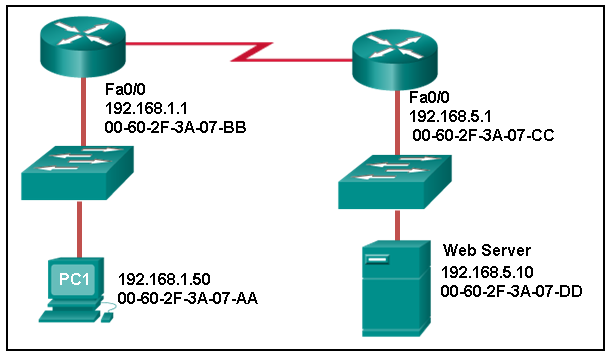
- 00-60-2F-3A-07-AA
- 00-60-2F-3A-07-BB
- 00-60-2F-3A-07-CC
- 00-60-2F-3A-07-DD
Explanation: The
destination MAC address is used for local delivery of Ethernet frames.
The MAC (Layer 2) address changes at each network segment along the
path. As the frame leaves the web server, it will be delivered by using
the MAC address of the default gateway.
105. A Layer 2 switch is used to switch incoming frames from a
1000BASE-T port to a port connected to a 100Base-T network. Which
method of memory buffering would work best for this task?
- port-based buffering
- level 1 cache buffering
- shared memory buffering
- fixed configuration buffering
106. What are two examples of the cut-through switching method? (Choose two.)
- store-and-forward switching
- fast-forward switching
- CRC switching
- fragment-free switching
- QOS switching
107. Which frame forwarding method receives the entire frame
and performs a CRC check to detect errors before forwarding the frame?
- cut-through switching
- store-and-forward switching
- fragment-free switching
- fast-forward switching
Explanation:
Fast-forward and fragment-free switching are variations of cut-through
switching, which begins to forward the frame before the entire frame is
received.
108. What is the purpose of the FCS field in a frame?
- to obtain the MAC address of the sending node
- to verify the logical address of the sending node
- to compute the CRC header for the data field
- to determine if errors occurred in the transmission and reception
Explanation: The
FCS field in a frame is used to detect any errors in the transmission
and receipt of a frame. This is done by comparing the CRC value within
the frame against a computed CRC value of the frame. If the two values
do not match, then the frame is discarded.
109. Which switching method has the lowest level of latency?
- cut-through
- store-and-forward
- fragment-free
- fast-forward
Explanation:
Fast-forward switching begins to forward a frame after reading the
destination MAC address, resulting in the lowest latency. Fragment-free
reads the first 64 bytes before forwarding. Store-and-forward has the
highest latency because it reads the entire frame before beginning to
forward it. Both fragment-free and fast-forward are types of cut-through
switching.
110. A network administrator is connecting two modern
switches using a straight-through cable. The switches are new and have
never been configured. Which three statements are correct about the
final result of the connection? (Choose three.)
- The link between the switches will work at the fastest speed that is supported by both switches.
- The link between switches will work as full-duplex.
- If both switches support different speeds, they will each work at their own fastest speed.
- The auto-MDIX feature will configure the interfaces eliminating the need for a crossover cable.
- The connection will not be possible unless the administrator changes the cable to a crossover cable.
- The duplex capability has to be manually configured because it cannot be negotiated.
Explanation: Modern
switches can negotiate to work in full-duplex mode if both switches are
capable. They will negotiate to work using the fastest possible speed
and the auto-MDIX feature is enabled by default, so a cable change is
not needed.
111. Which advantage does the store-and-forward switching method have compared with the cut-through switching method?
- collision detecting
- frame error checking
- faster frame forwarding
- frame forwarding using IPv4 Layer 3 and 4 information
Explanation: A
switch using the store-and-forward switching method performs an error
check on an incoming frame by comparing the FCS value against its own
FCS calculations after the entire frame is received. In comparison, a
switch using the cut-through switching method makes quick forwarding
decisions and starts the forwarding process without waiting for the
entire frame to be received. Thus a switch using cut-through switching
may send invalid frames to the network. The performance of
store-and-forward switching is slower compared to cut-through switching
performance. Collision detection is monitored by the sending device.
Store-and-forward switching does not use IPv4 Layer 3 and 4 information
for its forwarding decisions.
112. When the store-and-forward method of switching is in
use, what part of the Ethernet frame is used to perform an error check?
- CRC in the trailer
- source MAC address in the header
- destination MAC address in the header
- protocol type in the header
113. Which switching method uses the CRC value in a frame?
- cut-through
- fast-forward
- fragment-free
- store-and-forward
Explanation: When
the store-and-forward switching method is used, the switch receives the
complete frame before forwarding it on to the destination. The cyclic
redundancy check (CRC) part of the trailer is used to determine if the
frame has been modified during transit. In contrast, a cut-through
switch forwards the frame once the destination Layer 2 address is read.
Two types of cut-through switching methods are fast-forward and
fragment-free.
114. What are two actions performed by a Cisco switch? (Choose two.)
- building a routing table that is based on the first IP address in the frame header
- using the source MAC addresses of frames to build and maintain a MAC address table
- forwarding frames with unknown destination IP addresses to the default gateway
- utilizing the MAC address table to forward frames via the destination MAC address
- examining the destination MAC address to add new entries to the MAC address table
Explanation: Important actions that a switch performs are as follows:
- When a frame comes in, the switch examines the Layer 2 source address to build and maintain the Layer 2 MAC address table.
- It examines the Layer 2 destination address to determine how to
forward the frame. When the destination address is in the MAC address
table, then the frame is sent out a particular port. When the address is
unknown, the frame is sent to all ports that have devices connected to
that network.
115. Which two statements describe features or functions of
the logical link control sublayer in Ethernet standards? (Choose two.)
- Logical link control is implemented in software.
- Logical link control is specified in the IEEE 802.3 standard.
- The LLC sublayer adds a header and a trailer to the data.
- The data link layer uses LLC to communicate with the upper layers of the protocol suite.
- The LLC sublayer is responsible for the placement and retrieval of frames on and off the media.
Explanation:
Logical link control is implemented in software and enables the data
link layer to communicate with the upper layers of the protocol suite.
Logical link control is specified in the IEEE 802.2 standard. IEEE 802.3
is a suite of standards that define the different Ethernet types. The
MAC (Media Access Control) sublayer is responsible for the placement and
retrieval of frames on and off the media. The MAC sublayer is also
responsible for adding a header and a trailer to the network layer
protocol data unit (PDU).
116. What is the auto-MDIX feature?
- It enables a device to automatically configure an interface to use a straight-through or a crossover cable.
- It enables a device to automatically configure the duplex settings of a segment.
- It enables a device to automatically configure the speed of its interface.
- It enables a switch to dynamically select the forwarding method.
117. What is one advantage of using the cut-through switching method instead of the store-and-forward switching method?
- has a positive impact on bandwidth by dropping most of the invalid frames
- makes a fast forwarding decision based on the source MAC address of the frame
- has a lower latency appropriate for high-performance computing applications
- provides the flexibility to support any mix of Ethernet speeds
Explanation:
Cut-through switching provides lower latency switching for
high-performance computing (HPC) applications. Cut-through switching
allows more invalid frames to cross the network than store-and-forward
switching. The cut-through switching method can make a forwarding
decision as soon as it looks up the destination MAC address of the
frame.
118. Which is a multicast MAC address?
- FF-FF-FF-FF-FF-FF
- 5C-26-0A-4B-19-3E
- 01-00-5E-00-00-03
- 00-26-0F-4B-00-3E
119. Refer to the exhibit. What is wrong with the displayed termination?
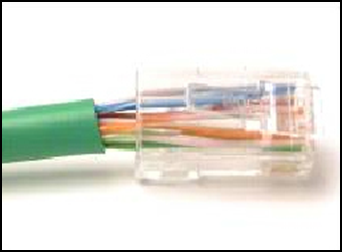
- The woven copper braid should not have been removed.
- The wrong type of connector is being used.
- The untwisted length of each wire is too long.
- The wires are too thick for the connector that is used.
Explanation: When a
cable to an RJ-45 connector is terminated, it is important to ensure
that the untwisted wires are not too long and that the flexible plastic
sheath surrounding the wires is crimped down and not the bare wires.
None of the colored wires should be visible from the bottom of the jack.
120. Refer to the exhibit. The PC is connected to the console
port of the switch. All the other connections are made through
FastEthernet links. Which types of UTP cables can be used to connect the
devices?

- 1 – rollover, 2 – crossover, 3 – straight-through
- 1 – rollover, 2 – straight-through, 3 – crossover
- 1 – crossover, 2 – straight-through, 3 – rollover
- 1 – crossover, 2 – rollover, 3 – straight-through
121. Open the PT Activity. Perform the tasks in the activity instructions and then answer the question.
Which port does Switch0 use to send frames to the host with the IPv4 address 10.1.1.5?
Explanation: Issuing the command ipconfig /all from
the PC0 command prompt displays the IPv4 address and MAC address. When
the IPv4 address 10.1.1.5 is pinged from PC0, the switch stores the
source MAC address (from PC0) along with the port to which PC0 is
connected. When the destination reply is received, the switch takes the
destination MAC address and compares to MAC addresses stored in the MAC
address table. Issuing the show mac-address-table on
the PC0 Terminal application displays two dynamic MAC address entries.
The MAC address and port entry that does not belong to PC0 must be the
MAC address and port of the destination with the IPv4 address 10.1.1.5.
122. What does the term “attenuation” mean in data communication?
- loss of signal strength as distance increases
- time for a signal to reach its destination
- leakage of signals from one cable pair to another
- strengthening of a signal by a networking device
Explanation: Data
is transmitted on copper cables as electrical pulses. A detector in the
network interface of a destination device must receive a signal that can
be successfully decoded to match the signal sent. However, the farther
the signal travels, the more it deteriorates. This is referred to as
signal attenuation.
123. What makes fiber preferable to copper cabling for interconnecting buildings? (Choose three.)
- greater distances per cable run
- lower installation cost
- limited susceptibility to EMI/RFI
- durable connections
- greater bandwidth potential
- easily terminated
Explanation:
Optical fiber cable transmits data over longer distances and at higher
bandwidths than any other networking media. Unlike copper wires,
fiber-optic cable can transmit signals with less attenuation and is
completely immune to EMI and RFI.
124. What OSI physical layer term describes the process by which one wave modifies another wave?
- modulation
- IEEE
- EIA/TIA
- air
125. What OSI physical layer term describes the capacity at which a medium can carry data?
- bandwidth
- IEEE
- EIA/TIA
- air
126. What OSI physical layer term describes the capacity at which a medium can carry data?
- bandwidth
- throughput
- latency
- goodput
127. What OSI physical layer term describes the measure of the transfer of bits across a medium over a given period of time?
- throughput
- bandwidth
- latency
- goodput
128. What OSI physical layer term describes the amount of time, including delays, for data to travel from one point to another?
- latency
- bandwidth
- throughput
- goodput
129. What OSI physical layer term describes the amount of time, including delays, for data to travel from one point to another?
- latency
- fiber-optic cable
- air
- copper cable
130. What OSI physical layer term describes the measure of usable data transferred over a given period of time?
- goodput
- fiber-optic cable
- air
- copper cable
131. What OSI physical layer term describes the physical medium which uses electrical pulses?
- copper cable
- fiber-optic cable
- air
- goodput
132. What OSI physical layer term describes the physical medium that uses the propagation of light?
- fiber-optic cable
- goodput
- latency
- throughput
133. What OSI physical layer term describes the physical medium for microwave transmissions?
- air
- goodput
- latency
- throughput
134. Which two functions are performed at the MAC sublayer of the OSI data link layer? (Choose two.)
- Implements a trailer to detect transmission errors.
- Controls the NIC responsible for sending and receiving data on the physical medium.
- Places information in the frame that identifies which network layer protocol is being used for the frame.
- Adds Layer 2 control information to network protocol data.
- Enables IPv4 and IPv6 to utilize the same network interface and media.
135. Which two functions are performed at the LLC sublayer of the OSI data link layer? (Choose two.)
- Enables IPv4 and IPv6 to utilize the same network interface and media.
- Places information in the frame that identifies which network layer protocol is being used for the frame.
- Integrates various physical technologies.
- Implements a process to delimit fields within a Layer 2 frame.
- Controls the NIC responsible for sending and receiving data on the physical medium.
136. Which two functions are performed at the MAC sublayer of the OSI data link layer? (Choose two.)
- Provides a mechanism to allow multiple devices to communicate over a shared medium.
- Controls the NIC responsible for sending and receiving data on the physical medium.
- Places information in the frame that identifies which network layer protocol is being used for the frame.
- Adds Layer 2 control information to network protocol data.
- Communicates between the networking software at the upper layers and the device hardware at the lower layers.
137. Which two functions are performed at the MAC sublayer of the OSI data link layer? (Choose two.)
- Controls the NIC responsible for sending and receiving data on the physical medium.
- Integrates various physical technologies.
- Communicates between the networking software at the upper layers and the device hardware at the lower layers.
- Adds Layer 2 control information to network protocol data.
- Places information in the frame that identifies which network layer protocol is being used for the frame.
138. Which two functions are performed at the LLC sublayer of the OSI data link layer? (Choose two.)
- Adds Layer 2 control information to network protocol data.
- Places information in the frame that identifies which network layer protocol is being used for the frame.
- Performs data encapsulation.
- Controls the NIC responsible for sending and receiving data on the physical medium.
- Integrates various physical technologies.
139. Which two functions are performed at the MAC sublayer of the OSI data link layer? (Choose two.)
- Provides synchronization between source and target nodes.
- Integrates various physical technologies.
- Communicates between the networking software at the upper layers and the device hardware at the lower layers.
- Adds Layer 2 control information to network protocol data.
- Enables IPv4 and IPv6 to utilize the same network interface and media.
140. Which two functions are performed at the LLC sublayer of the OSI data link layer? (Choose two.)
- Adds Layer 2 control information to network protocol data.
- Enables IPv4 and IPv6 to utilize the same network interface and media.
- Provides data link layer addressing.
- Implements a trailer to detect transmission errors.
- Provides synchronization between source and target nodes.
141. Which two functions are performed at the MAC sublayer of the OSI data link layer? (Choose two.)
- Implements a trailer to detect transmission errors.
- Provides synchronization between source and target nodes.
- Places information in the frame that identifies which network layer protocol is being used for the frame.
- Enables IPv4 and IPv6 to utilize the same network interface and media.
- Adds Layer 2 control information to network protocol data.
142. Which two functions are performed at the LLC sublayer of the OSI data link layer? (Choose two.)
- Enables IPv4 and IPv6 to utilize the same network interface and media.
- Adds Layer 2 control information to network protocol data.
- Integrates various physical technologies.
- Implements a trailer to detect transmission errors.
- Provides synchronization between source and target nodes.
143. Which two functions are performed at the MAC sublayer of the OSI data link layer? (Choose two.)
- Provides a mechanism to allow multiple devices to communicate over a shared medium.
- Controls the NIC responsible for sending and receiving data on the physical medium.
- Places information in the frame that identifies which network layer protocol is being used for the frame.
- Adds Layer 2 control information to network protocol data.
- Enables IPv4 and IPv6 to utilize the same network interface and media.
144. What action will occur if a switch receives a frame and does have the source MAC address in the MAC table?
- The switch refreshes the timer on that entry.
- The switch shares the MAC address table entry with any connected switches.
- The switch does not forward the frame.
- The switch sends the frame to a connected router because the destination MAC address is not local.
145. What action will occur if a switch receives a frame with the destination MAC address FF:FF:FF:FF:FF:FF?
- The switch forwards it out all ports except the ingress port.
- The switch shares the MAC address table entry with any connected switches.
- The switch does not forward the frame.
- The switch sends the frame to a connected router because the destination MAC address is not local.
146. What action will occur if a host receives a frame with a destination MAC address it does not recognize?
- The host will discard the frame.
- The host sends the frame to the switch to update the MAC address table.
- The host forwards the frame to the router.
- The host forwards the frame to all other hosts.
147. What action will occur if a switch receives a frame with the destination MAC address 01:00:5E:00:00:D9?
- The switch forwards it out all ports except the ingress port.
- The switch does not forward the frame.
- The switch sends the frame to a connected router because the destination MAC address is not local.
- The switch shares the MAC address table entry with any connected switches.
148. What action will occur if a host receives a frame with a destination MAC address of FF:FF:FF:FF:FF:FF?
- The host will process the frame.
- The host forwards the frame to the router.
- The host sends the frame to the switch to update the MAC address table.
- The host forwards the frame to all other hosts.
149. What action will occur if a switch receives a frame and does have the source MAC address in the MAC table?
- The switch refreshes the timer on that entry.
- The switch adds it to its MAC address table associated with the port number.
- The switch forwards the frame to the associated port.
- The switch sends the frame to a connected router because the destination MAC address is not local.
150. What action will occur if a host receives a frame with a destination MAC address of FF:FF:FF:FF:FF:FF?
- The host will process the frame.
- The host returns the frame to the switch.
- The host replies to the switch with its own IP address.
- The host forwards the frame to all other hosts.
151. What action will occur if a switch receives a frame and does have the source MAC address in the MAC table?
- The switch refreshes the timer on that entry.
- The switch shares the MAC address table entry with any connected switches.
- The switch does not forward the frame.
- The switch adds it to its MAC address table associated with the port number.
152. What action will occur if a host receives a frame with a destination MAC address it does not recognize?
- The host will discard the frame.
- The host replies to the switch with its own IP address.
- The host forwards the frame to all other hosts.
- The host returns the frame to the switch.
153. What action will occur if a switch receives a frame with the destination MAC address FF:FF:FF:FF:FF:FF?
- The switch forwards it out all ports except the ingress port.
- The switch refreshes the timer on that entry.
- The switch does not forward the frame.
- The switch sends the frame to a connected router because the destination MAC address is not local.
154. Which information is used by routers to forward a data packet toward its destination?
- source IP address
- destination IP address
- source data-link address
- destination data-link address
155. A computer has to send a packet to a destination host in the same LAN. How will the packet be sent?
- The packet will be sent to the default gateway first, and then,
depending on the response from the gateway, it may be sent to the
destination host.
- The packet will be sent directly to the destination host.
- The packet will first be sent to the default gateway, and then from
the default gateway it will be sent directly to the destination host.
- The packet will be sent only to the default gateway.
156. A router receives a packet from the Gigabit 0/0
interface and determines that the packet needs to be forwarded out the
Gigabit 0/1 interface. What will the router do next?
- route the packet out the Gigabit 0/1 interface
- create a new Layer 2 Ethernet frame to be sent to the destination
- look into the ARP cache to determine the destination IP address
- look into the routing table to determine if the destination network is in the routing table
157. Which IPv4 address can a host use to ping the loopback interface?
- 126.0.0.1
- 127.0.0.0
- 126.0.0.0
- 127.0.0.1
158. A computer can access devices on the same network but
cannot access devices on other networks. What is the probable cause of
this problem?
- The cable is not connected properly to the NIC.
- The computer has an invalid IP address.
- The computer has an incorrect subnet mask.
- The computer has an invalid default gateway address.
159. Which statement describes a feature of the IP protocol?
- IP encapsulation is modified based on network media.
- IP relies on Layer 2 protocols for transmission error control.
- MAC addresses are used during the IP packet encapsulation.
- IP relies on upper layer services to handle situations of missing or out-of-order packets.
Explanation: IP
protocol is a connection-less protocol, considered unreliable in terms
of end-to-end delivery. It does not provide error control in the cases
where receiving packets are out-of-order or in cases of missing packets.
It relies on upper layer services, such as TCP, to resolve these
issues.
160. Why is NAT not needed in IPv6?
- Because IPv6 has integrated security, there is no need to hide the IPv6 addresses of internal networks.
- Any host or user can get a public IPv6 network address because the number of available IPv6 addresses is extremely large.
- The problems that are induced by NAT applications are solved because
the IPv6 header improves packet handling by intermediate routers.
- The end-to-end connectivity problems that are caused by NAT are
solved because the number of routes increases with the number of nodes
that are connected to the Internet.
161. Which parameter does the router use to choose the path to the destination when there are multiple routes available?
- the lower metric value that is associated with the destination network
- the lower gateway IP address to get to the destination network
- the higher metric value that is associated with the destination network
- the higher gateway IP address to get to the destination network
162. What are two services provided by the OSI network layer? (Choose two.)
- performing error detection
- routing packets toward the destination
- encapsulating PDUs from the transport layer
- placement of frames on the media
- collision detection
Explanation: The OSI network layer provides several services to allow communication between devices:
- addressing
- encapsulation
- routing
- de-encapsulation
Error detection, placing frames on the media, and collision detection are all functions of the data ink layer.
163. Within a production network, what is the purpose of configuring a switch with a default gateway address?
- Hosts that are connected to the switch can use the switch default gateway address to forward packets to a remote destination.
- A switch must have a default gateway to be accessible by Telnet and SSH.
- The default gateway address is used to forward packets originating from the switch to remote networks.
- It provides a next-hop address for all traffic that flows through the switch.
Explanation: A
default gateway address allows a switch to forward packets that
originate on the switch to remote networks. A default gateway address on
a switch does not provide Layer 3 routing for PCs that are connected on
that switch. A switch can still be accessible from Telnet as long as
the source of the Telnet connection is on the local network.
164. What is a basic characteristic of the IP protocol?
- connectionless
- media dependent
- user data segmentation
- reliable end-to-end delivery
Explanation:
Internet Protocol (IP) is a network layer protocol that does not require
initial exchange of control information to establish an end-to-end
connection before packets are forwarded. Thus, IP is connectionless and
does not provide reliable end-to-end delivery by itself. IP is media
independent. User data segmentation is a service provided at the
transport layer.
165. Which field in the IPv4 header is used to prevent a packet from traversing a network endlessly?
- Time-to-Live
- Sequence Number
- Acknowledgment Number
- Differentiated Services
Explanation: The
value of the Time-to-Live (TTL) field in the IPv4 header is used to
limit the lifetime of a packet. The sending host sets the initial TTL
value; which is decreased by one each time the packet is processed by a
router. If the TTL field decrements to zero, the router discards the
packet and sends an Internet Control Message Protocol (ICMP) Time
Exceeded message to the source IP address. The Differentiated Services
(DS) field is used to determine the priority of each packet. Sequence
Number and Acknowledgment Number are two fields in the TCP header.
166. What is one advantage that the IPv6 simplified header offers over IPv4?
- smaller-sized header
- little requirement for processing checksums
- smaller-sized source and destination IP addresses
- efficient packet handling
Explanation: The IPv6 simplified header offers several advantages over IPv4:
- Better routing efficiency and efficient packet handling for performance and forwarding-rate scalability
- No requirement for processing checksums
- Simplified and more efficient extension header mechanisms (as opposed to the IPv4 Options field)
- A Flow Label field for per-flow processing with no need to open the transport inner packet to identify the various traffic flows
167. What IPv4 header field identifies the upper layer protocol carried in the packet?
- Protocol
- Identification
- Version
- Differentiated Services
Explanation: It is
the Protocol field in the IP header that identifies the upper-layer
protocol the packet is carrying. The Version field identifies the IP
version. The Differential Services field is used for setting packet
priority. The Identification field is used to reorder fragmented
packets.
168. Refer to the exhibit. Match the packets with their
destination IP address to the exiting interfaces on the router. (Not all
targets are used.)
Explanation:
Packets with a destination of 172.17.6.15 are forwarded through Fa0/0.
Packets with a destination of 172.17.10.5 are forwarded through Fa1/1.
Packets with a destination of 172.17.12.10 are forwarded through Fa1/0.
Packets with a destination of 172.17.14.8 are forwarded through Fa0/1.
Because network 172.17.8.0 has no entry in the routing table, it will
take the gateway of last resort, which means that packets with a
destination of 172.17.8.20 are forwarded through Serial0/0/0. Because a
gateway of last resort exists, no packets will be dropped.
169. What information does the loopback test provide?
- The TCP/IP stack on the device is working correctly.
- The device has end-to-end connectivity.
- DHCP is working correctly.
- The Ethernet cable is working correctly.
- The device has the correct IP address on the network.
170. What routing table entry has a next hop address associated with a destination network?
- directly-connected routes
- local routes
- remote routes
- C and L source routes
171. How do hosts ensure that their packets are directed to the correct network destination?
- They have to keep their own
local routing table that contains a route to the loopback interface, a
local network route, and a remote default route.
- They always direct their packets to the default gateway, which will be responsible for the packet delivery.
- They search in their own local routing table for a route to the
network destination address and pass this information to the default
gateway.
- They send a query packet to the default gateway asking for the best route.
172. When transporting data from real-time applications, such
as streaming audio and video, which field in the IPv6 header can be
used to inform the routers and switches to maintain the same path for
the packets in the same conversation?
- Next Header
- Flow Label
- Traffic Class
- Differentiated Services
Explanation: The
Flow Label in IPv6 header is a 20-bit field that provides a special
service for real-time applications. This field can be used to inform
routers and switches to maintain the same path for the packet flow so
that packets will not be reordered.
173. What statement describes the function of the Address Resolution Protocol?
- ARP is used to discover the IP address of any host on a different network.
- ARP is used to discover the IP address of any host on the local network.
- ARP is used to discover the MAC address of any host on a different network.
- ARP is used to discover the MAC address of any host on the local network.
174. Under which two circumstances will a switch flood a
frame out of every port except the port that the frame was received on?
(Choose two.)
- The frame has the broadcast address as the destination address.
- The destination address is unknown to the switch.
- The source address in the frame header is the broadcast address.
- The source address in the frame is a multicast address.
- The destination address in the frame is a known unicast address.
Explanation: A
switch will flood a frame out of every port, except the one that the
frame was received from, under two circumstances. Either the frame has
the broadcast address as the destination address, or the destination
address is unknown to the switch.
175. Which statement describes the treatment of ARP requests on the local link?
- They must be forwarded by all routers on the local network.
- They are received and processed by every device on the local network.
- They are dropped by all switches on the local network.
- They are received and processed only by the target device.
Explanation: One of
the negative issues with ARP requests is that they are sent as a
broadcast. This means all devices on the local link must receive and
process the request.
176. Which destination address is used in an ARP request frame?
- 0.0.0.0
- 255.255.255.255
- FFFF.FFFF.FFFF
- AAAA.AAAA.AAAA
- the physical address of the destination host
Explanation: The
purpose of an ARP request is to find the MAC address of the destination
host on an Ethernet LAN. The ARP process sends a Layer 2 broadcast to
all devices on the Ethernet LAN. The frame contains the IP address of
the destination and the broadcast MAC address, FFFF.FFFF.FFFF. The host
with the IP address that matches the IP address in the ARP request will
reply with a unicast frame that includes the MAC address of the host.
Thus the original sending host will obtain the destination IP and MAC
address pair to continue the encapsulation process for data
transmission.
177. A network technician issues the arp -d * command on a PC
after the router that is connected to the LAN is reconfigured. What is
the result after this command is issued?
- The ARP cache is cleared.
- The current content of the ARP cache is displayed.
- The detailed information of the ARP cache is displayed.
- The ARP cache is synchronized with the router interface.
Explanation: Issuing the arp –d *
command on a PC will clear the ARP cache content. This is helpful when a
network technician wants to ensure the cache is populated with updated
information.
178. Refer to the exhibit. The exhibit shows a small switched
network and the contents of the MAC address table of the switch. PC1
has sent a frame addressed to PC3. What will the switch do with the
frame?
- The switch will discard the frame.
- The switch will forward the frame only to port 2.
- The switch will forward the frame to all ports except port 4.
- The switch will forward the frame to all ports.
- The switch will forward the frame only to ports 1 and 3.
Explanation: The
MAC address of PC3 is not present in the MAC table of the switch.
Because the switch does not know where to send the frame that is
addressed to PC3, it will forward the frame to all the switch ports,
except for port 4, which is the incoming port.
179. Which two types of IPv6 messages are used in place of ARP for address resolution?
- anycast
- broadcast
- echo reply
- echo request
- neighbor solicitation
- neighbor advertisement
Explanation: IPv6
does not use ARP. Instead, ICMPv6 neighbor discovery is used by sending
neighbor solicitation and neighbor advertisement messages.
180. What is the aim of an ARP spoofing attack?
- to flood the network with ARP reply broadcasts
- to fill switch MAC address tables with bogus addresses
- to associate IP addresses to the wrong MAC address
- to overwhelm network hosts with ARP requests
181. Refer to the exhibit. PC1 attempts to connect to
File_server1 and sends an ARP request to obtain a destination MAC
address. Which MAC address will PC1 receive in the ARP reply?
- the MAC address of S1
- the MAC address of the G0/0 interface on R1
- the MAC address of the G0/0 interface on R2
- the MAC address of S2
- the MAC address of File_server1
182. Where are IPv4 address to Layer 2 Ethernet address mappings maintained on a host computer?
- neighbor table
- ARP cache
- routing table
- MAC address table
183. What important information is examined in the Ethernet
frame header by a Layer 2 device in order to forward the data onward?
- source MAC address
- source IP address
- destination MAC address
- Ethernet type
- destination IP address
Explanation: The
Layer 2 device, such as a switch, uses the destination MAC address to
determine which path (interface or port) should be used to send the data
onward to the destination device.
184. Match the commands to the correct actions. (Not all options are used.)
185. A new network administrator has been asked to enter a
banner message on a Cisco device. What is the fastest way a network
administrator could test whether the banner is properly configured?
- Reboot the device.
- Enter CTRL-Z at the privileged mode prompt.
- Exit global configuration mode.
- Power cycle the device.
- Exit privileged EXEC mode and press Enter.
Explanation: While at the privileged mode prompt such as Router#, type exit,press Enter, and the banner message appears. Power cycling a network device that has had the banner motd command issued will also display the banner message, but this is not a quick way to test the configuration.
186. A network administrator requires access to manage
routers and switches locally and remotely. Match the description to the
access method. (Not all options are used.)
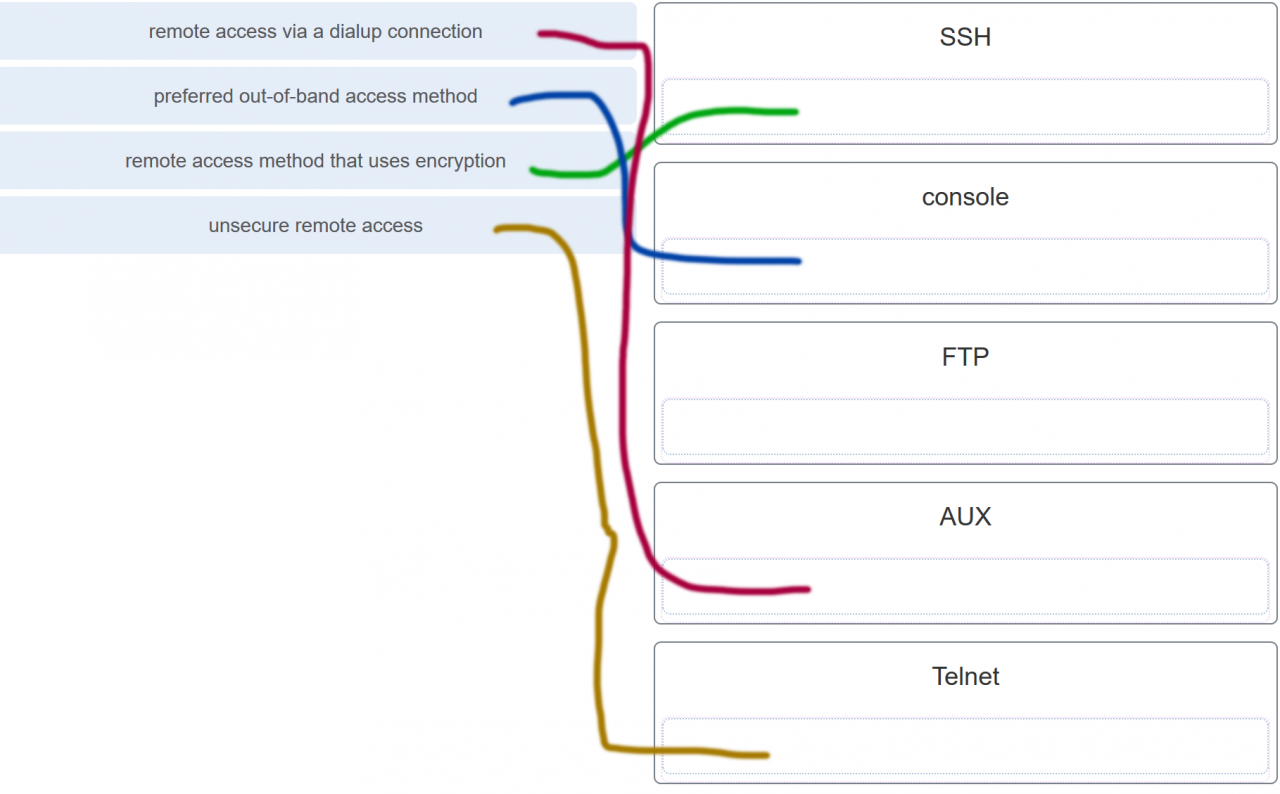
Explanation: Both
the console and AUX ports can be used to directly connect to a Cisco
network device for management purposes. However, it is more common to
use the console port. The AUX port is more often used for remote access
via a dial up connection. SSH and Telnet are both remote access methods
that depend on an active network connection. SSH uses a stronger
password authentication than Telnet uses and also uses encryption on
transmitted data.
187. Match the phases to the functions during the boot up process of a Cisco router. (Not all options are used.)
Explanation: There are three major phases to the bootup process of a Cisco router:
- Perform the POST and load the bootstrap program.
- Locate and load the Cisco IOS software.
- Locate and load the startup configuration file
If a startup configuration file cannot be located, the router will enter setup mode by displaying the setup mode prompt.
188. Match the command with the device mode at which the command is entered. (Not all options are used.)
Explanation: The enable command is entered in R1> mode. The login command is entered in R1(config-line)# mode. The copy running-config startup-config command is entered in R1# mode. The ip address 192.168.4.4 255.255.255.0 command is entered in R1(config-if)# mode. The service password-encryption command is entered in global configuration mode.
189. What are two functions of NVRAM? (Choose two.)
- to store the routing table
- to retain contents when power is removed
- to store the startup configuration file
- to contain the running configuration file
- to store the ARP table
Explanation: NVRAM is permanent memory storage, so the startup configuration file is preserved even if the router loses power.
190. A router boots and enters setup mode. What is the reason for this?
- The IOS image is corrupt.
- Cisco IOS is missing from flash memory.
- The configuration file is missing from NVRAM.
- The POST process has detected hardware failure.
191. The global configuration command ip default-gateway
172.16.100.1 is applied to a switch. What is the effect of this command?
- The switch will have a management interface with the address 172.16.100.1.
- The switch can be remotely managed from a host on another network.
- The switch can communicate with other hosts on the 172.16.100.0 network.
- The switch is limited to sending and receiving frames to and from the gateway 172.16.100.1.
Explanation: A
default gateway address is typically configured on all devices to allow
them to communicate beyond just their local network.In a switch this is
achieved using the command ip default-gateway <ip address>.
192. What happens when the transport input ssh command is entered on the switch vty lines?
- The SSH client on the switch is enabled.
- Communication between the switch and remote users is encrypted.
- The switch requires a username/password combination for remote access.
- The switch requires remote connections via a proprietary client software.
Explanation: The transport input ssh command when entered on the switch vty (virtual terminal lines) will encrypt all inbound controlled telnet connections.
193. Refer to the exhibit. A user PC has successfully
transmitted packets to www.cisco.com. Which IP address does the user PC
target in order to forward its data off the local network?
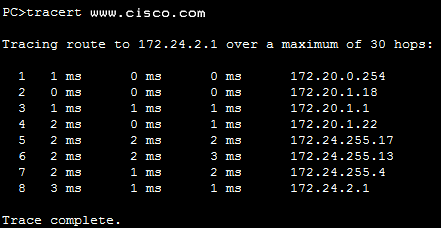
- 172.24.255.17
- 172.24.1.22
- 172.20.0.254
- 172.24.255.4
- 172.20.1.18
194. Match the configuration mode with the command that is available in that mode. (Not all options are used.)
Explanation: The enable command is entered at the R1> prompt. The login command is entered at the R1(config-line)# prompt. The copy running-config startup-config command is entered at the R1# prompt. The interface fastethernet 0/0 command is entered at the R1(config)# prompt.
195. Which three commands are used to set up secure access to
a router through a connection to the console interface? (Choose three.)
- interface fastethernet 0/0
- line vty 0 4
- line console 0
- enable secret cisco
- login
- password cisco
Explanation: The three commands needed to password protect the console port are as follows:
- line console 0
- password cisco
- login
The
interface fastethernet 0/0 command is commonly
used to access the configuration mode used to apply specific parameters
such as the IP address to the Fa0/0 port. The
line vty 0 4
command is used to access the configuration mode for Telnet. The0and 4
parameters specify ports 0 through 4, or a maximum of five simultaneous
Telnet connections. The
enable secret command is used to apply a password used on the router to access the privileged mode.
196. Refer to the exhibit. Consider the IP address
configuration shown from PC1. What is a description of the default
gateway address?
- It is the IP address of the Router1 interface that connects the company to the Internet.
- It is the IP address of the Router1 interface that connects the PC1 LAN to Router1.
- It is the IP address of Switch1 that connects PC1 to other devices on the same LAN.
- It is the IP address of the ISP network device located in the cloud.
197. Which two functions are primary functions of a router? (Choose two.)
- packet forwarding
- microsegmentation
- domain name resolution
- path selection
- flow control
Explanation: A
router accepts a packet and accesses its routing table to determine the
appropriate exit interface based on the destination address. The router
then forwards the packet out of that interface.
198. What is the effect of using the Router# copy running-config startup-config command on a router?
- The contents of ROM will change.
- The contents of RAM will change.
- The contents of NVRAM will change.
- The contents of flash will change.
Explanation: The command copy running-config startup-config
copies the running-configuration file from RAM into NVRAM and saves it
as the startup-configuration file. Since NVRAM is none-volatile memory
it will be able to retain the configuration details when the router is
powered off.
199. What will happen if the default gateway address is incorrectly configured on a host?
- The host cannot communicate with other hosts in the local network.
- The switch will not forward packets initiated by the host.
- The host will have to use ARP to determine the correct address of the default gateway.
- The host cannot communicate with hosts in other networks.
- A ping from the host to 127.0.0.1 would not be successful.
Explanation: When a
host needs to send a message to another host located on the same
network, it can forward the message directly. However, when a host needs
to send a message to a remote network, it must use the router, also
known as the default gateway. This is because the data link frame
address of the remote destination host cannot be used directly. Instead,
the IP packet has to be sent to the router (default gateway) and the
router will forward the packet toward its destination. Therefore, if the
default gateway is incorrectly configured, the host can communicate
with other hosts on the same network, but not with hosts on remote
networks.
200. What are two potential network problems that can result from ARP operation? (Choose two.)
- Manually configuring static ARP associations could facilitate ARP poisoning or MAC address spoofing.
- On large networks with low bandwidth, multiple ARP broadcasts could cause data communication delays.
- Network attackers could
manipulate MAC address and IP address mappings in ARP messages with the
intent of intercepting network traffic.
- Large numbers of ARP request broadcasts could cause the host MAC
address table to overflow and prevent the host from communicating on the
network.
- Multiple ARP replies result in the switch MAC address table
containing entries that match the MAC addresses of hosts that are
connected to the relevant switch port.
Explanation: Large
numbers of ARP broadcast messages could cause momentary data
communications delays. Network attackers could manipulate MAC address
and IP address mappings in ARP messages with the intent to intercept
network traffic. ARP requests and replies cause entries to be made into
the ARP table, not the MAC address table. ARP table overflows are very
unlikely. Manually configuring static ARP associations is a way to
prevent, not facilitate, ARP poisoning and MAC address spoofing.
Multiple ARP replies resulting in the switch MAC address table
containing entries that match the MAC addresses of connected nodes and
are associated with the relevant switch port are required for normal
switch frame forwarding operations. It is not an ARP caused network
problem.
201. Open the PT activity. Perform the tasks in the activity instructions and then answer the question.
Which interfaces in each router are active and operational?
- R1: G0/0 and S0/0/0
R2: G0/0 and S0/0/0
- R1: G0/1 and S0/0/1
R2: G0/0 and S0/0/1
- R1: G0/0 and S0/0/0
R2: G0/1 and S0/0/0
- R1: G0/0 and S0/0/1
R2: G0/1 and S0/0/1
Explanation: The command to use for this activity is show ip interface brief
in each router. The active and operational interfaces are represented
by the value “up” in the “Status” and “Protocol” columns. The interfaces
in R1 with these characteristics are G0/0 and S0/0/0. In R2 they are
G0/1 and S0/0/0.
202. Which term describes a field in the IPv4 packet header used to identify the next level protocol?
- protocol
- destination IPv4 address
- source IPv4 address
- TTL
203. Which term describes a field in the IPv4 packet header
that contains an 8-bit binary value used to determine the priority of
each packet?
- differentiated services
- destination IPv4 address
- source IPv4 address
- protocol
204. Which term describes a field in the IPv4 packet header
that contains a 32-bit binary value associated with an interface on the
sending device?
- source IPv4 address
- destination IPv4 address
- protocol
- TTL
205. Which term describes a field in the IPv4 packet header used to detect corruption in the IPv4 header?
- header checksum
- source IPv4 address
- protocol
- TTL
206.
RTR1(config)# interface gi0/1
RTR1(config-if)# description Connects to the Marketing LAN
RTR1(config-if)# ip address 10.27.15.17 255.255.255.0
RTR1(config-if)# no shutdown
RTR1(config-if)# interface gi0/0
RTR1(config-if)# description Connects to the Payroll LAN
RTR1(config-if)# ip address 10.27.14.148 255.255.255.0
RTR1(config-if)# no shutdown
RTR1(config-if)# interface s0/0/0
RTR1(config-if)# description Connects to the ISP
RTR1(config-if)# ip address 10.14.15.254 255.255.255.0
RTR1(config-if)# no shutdown
RTR1(config-if)# interface s0/0/1
RTR1(config-if)# description Connects to the Head Office WAN
RTR1(config-if)# ip address 203.0.113.39 255.255.255.0
RTR1(config-if)# no shutdown
RTR1(config-if)# end
Refer to the exhibit. A network administrator is connecting a
new host to the Payroll LAN. The host needs to communicate with remote
networks. What IP address would be configured as the default gateway on
the new host?
- 10.27.14.148
- 10.27.14.1
- 10.14.15.254
- 203.0.113.39
- 10.27.15.17
207. Which term describes a field in the IPv4 packet header that contains a unicast, multicast, or broadcast address?
- destination IPv4 address
- protocol
- TTL
- header checksum
208. Which term describes a field in the IPv4 packet header used to limit the lifetime of a packet?
- TTL
- source IPv4 address
- protocol
- header checksum
209. Which term describes a field in the IPv4 packet header that contains a 4-bit binary value set to 0100?
- version
- source IPv4 address
- protocol
- TTL
210. Which term describes a field in the IPv4 packet header used to identify the next level protocol?
- protocol
- version
- differentiated services
- header checksum
211. Which term describes a field in the IPv4 packet header that contains a 4-bit binary value set to 0100?
- version
- differentiated services
- header checksum
- TTL
212. What property of ARP causes cached IP-to-MAC mappings to remain in memory longer?
- Entries in an ARP table are time-stamped and are purged after the timeout expires.
- A static IP-to-MAC address entry can be entered manually into an ARP table.
- The type field 0x806 appears in the header of the Ethernet frame.
- The port-to-MAC address table on a switch has the same entries as the ARP table on the switch.
213. What property of ARP allows MAC addresses of frequently used servers to be fixed in the ARP table?
- A static IP-to-MAC address entry can be entered manually into an ARP table.
- Entries in an ARP table are time-stamped and are purged after the timeout expires.
- The type field 0x806 appears in the header of the Ethernet frame.
- The port-to-MAC address table on a switch has the same entries as the ARP table on the switch.
214. What property of ARP allows MAC addresses of frequently used servers to be fixed in the ARP table?
- A static IP-to-MAC address entry can be entered manually into an ARP table.
- The destination MAC address FF-FF-FF-FF-FF-FF appears in the header of the Ethernet frame.
- The source MAC address appears in the header of the Ethernet frame.
- The port-to-MAC address table on a switch has the same entries as the ARP table on the switch.
215. What property of ARP allows hosts on a LAN to send traffic to remote networks?
- Local hosts learn the MAC address of the default gateway.
- The destination MAC address FF-FF-FF-FF-FF-FF appears in the header of the Ethernet frame.
- The source MAC address appears in the header of the Ethernet frame.
- The port-to-MAC address table on a switch has the same entries as the ARP table on the switch.
216.
Floor(config)# interface gi0/1
Floor(config-if)# description Connects to the Registrar LAN
Floor(config-if)# ip address 192.168.235.234 255.255.255.0
Floor(config-if)# no shutdown
Floor(config-if)# interface gi0/0
Floor(config-if)# description Connects to the Manager LAN
Floor(config-if)# ip address 192.168.234.114 255.255.255.0
Floor(config-if)# no shutdown
Floor(config-if)# interface s0/0/0
Floor(config-if)# description Connects to the ISP
Floor(config-if)# ip address 10.234.235.254 255.255.255.0
Floor(config-if)# no shutdown
Floor(config-if)# interface s0/0/1
Floor(config-if)# description Connects to the Head Office WAN
Floor(config-if)# ip address 203.0.113.3 255.255.255.0
Floor(config-if)# no shutdown
Floor(config-if)# end
Refer to the exhibit. A network administrator is connecting a
new host to the Registrar LAN. The host needs to communicate with
remote networks. What IP address would be configured as the default
gateway on the new host?
- 192.168.235.234
- 192.168.235.1
- 10.234.235.254
- 203.0.113.3
- 192.168.234.114
217. What property of ARP forces all Ethernet NICs to process an ARP request?
- The destination MAC address FF-FF-FF-FF-FF-FF appears in the header of the Ethernet frame.
- The source MAC address appears in the header of the Ethernet frame.
- The type field 0x806 appears in the header of the Ethernet frame.
- ARP replies are broadcast on the network when a host receives an ARP request.
218. What property of ARP causes a reply only to the source sending an ARP request?
- The source MAC address appears in the header of the Ethernet frame.
- The destination MAC address FF-FF-FF-FF-FF-FF appears in the header of the Ethernet frame.
- The type field 0x806 appears in the header of the Ethernet frame.
- ARP replies are broadcast on the network when a host receives an ARP request.
219. What property of ARP causes the request to be flooded
out all ports of a switch except for the port receiving the ARP request?
- The destination MAC address FF-FF-FF-FF-FF-FF appears in the header of the Ethernet frame.
- The type field 0x806 appears in the header of the Ethernet frame.
- Entries in an ARP table are time-stamped and are purged after the timeout expires.
- ARP replies are broadcast on the network when a host receives an ARP request.
220. What property of ARP causes the NICs receiving an ARP
request to pass the data portion of the Ethernet frame to the ARP
process?
- The type field 0x806 appears in the header of the Ethernet frame.
- The destination MAC address FF-FF-FF-FF-FF-FF appears in the header of the Ethernet frame.
- Entries in an ARP table are time-stamped and are purged after the timeout expires.
- ARP replies are broadcast on the network when a host receives an ARP request.
221. What property of ARP causes the NICs receiving an ARP
request to pass the data portion of the Ethernet frame to the ARP
process?
- The type field 0x806 appears in the header of the Ethernet frame.
- The destination MAC address FF-FF-FF-FF-FF-FF appears in the header of the Ethernet frame.
- Entries in an ARP table are time-stamped and are purged after the timeout expires.
- The port-to-MAC address table on a switch has the same entries as the ARP table on the switch.
222.
Main(config)# interface gi0/1
Main(config-if)# description Connects to the Service LAN
Main(config-if)# ip address 172.29.157.156 255.255.255.0
Main(config-if)# no shutdown
Main(config-if)# interface gi0/0
Main(config-if)# description Connects to the Engineering LAN
Main(config-if)# ip address 172.29.156.36 255.255.255.0
Main(config-if)# no shutdown
Main(config-if)# interface s0/0/0
Main(config-if)# description Connects to the ISP
Main(config-if)# ip address 10.156.157.254 255.255.255.0
Main(config-if)# no shutdown
Main(config-if)# interface s0/0/1
Main(config-if)# description Connects to the Head Office WAN
Main(config-if)# ip address 198.51.100.177 255.255.255.0
Main(config-if)# no shutdown
Main(config-if)# end
Refer to the exhibit. A network administrator is connecting a
new host to the Service LAN. The host needs to communicate with remote
networks. What IP address would be configured as the default gateway on
the new host?
- 172.29.157.156
- 172.29.157.1
- 10.156.157.254
- 198.51.100.177
- 172.29.156.36
223.
BldgA(config)# interface gi0/1
BldgA(config-if)# description Connects to the Medical LAN
BldgA(config-if)# ip address 192.168.191.189 255.255.255.0
BldgA(config-if)# no shutdown
BldgA(config-if)# interface gi0/0
BldgA(config-if)# description Connects to the Client LAN
BldgA(config-if)# ip address 192.168.190.70 255.255.255.0
BldgA(config-if)# no shutdown
BldgA(config-if)# interface s0/0/0
BldgA(config-if)# description Connects to the ISP
BldgA(config-if)# ip address 10.190.191.254 255.255.255.0
BldgA(config-if)# no shutdown
BldgA(config-if)# interface s0/0/1
BldgA(config-if)# description Connects to the Head Office WAN
BldgA(config-if)# ip address 198.51.100.213 255.255.255.0
BldgA(config-if)# no shutdown
BldgA(config-if)# end
Refer to the exhibit. A network administrator is connecting a
new host to the Medical LAN. The host needs to communicate with remote
networks. What IP address would be configured as the default gateway on
the new host?
- 192.168.191.189
- 192.168.191.1
- 10.190.191.254
- 198.51.100.213
- 192.168.190.70
224.
Floor(config)# interface gi0/1
Floor(config-if)# description Connects to the Registrar LAN
Floor(config-if)# ip address 192.168.225.223 255.255.255.0
Floor(config-if)# no shutdown
Floor(config-if)# interface gi0/0
Floor(config-if)# description Connects to the Manager LAN
Floor(config-if)# ip address 192.168.224.103 255.255.255.0
Floor(config-if)# no shutdown
Floor(config-if)# interface s0/0/0
Floor(config-if)# description Connects to the ISP
Floor(config-if)# ip address 10.224.225.254 255.255.255.0
Floor(config-if)# no shutdown
Floor(config-if)# interface s0/0/1
Floor(config-if)# description Connects to the Head Office WAN
Floor(config-if)# ip address 203.0.113.246 255.255.255.0
Floor(config-if)# no shutdown
Floor(config-if)# end
Refer to the exhibit. A network administrator is connecting a
new host to the Registrar LAN. The host needs to communicate with
remote networks. What IP address would be configured as the default
gateway on the new host?
- 192.168.225.223
- 192.168.225.1
- 10.224.225.254
- 203.0.113.246
- 192.168.224.103
225.
Floor(config)# interface gi0/1
Floor(config-if)# description Connects to the Registrar LAN
Floor(config-if)# ip address 10.118.63.65 255.255.255.0
Floor(config-if)# no shutdown
Floor(config-if)# interface gi0/0
Floor(config-if)# description Connects to the Manager LAN
Floor(config-if)# ip address 10.118.62.196 255.255.255.0
Floor(config-if)# no shutdown
Floor(config-if)# interface s0/0/0
Floor(config-if)# description Connects to the ISP
Floor(config-if)# ip address 10.62.63.254 255.255.255.0
Floor(config-if)# no shutdown
Floor(config-if)# interface s0/0/1
Floor(config-if)# description Connects to the Head Office WAN
Floor(config-if)# ip address 209.165.200.87 255.255.255.0
Floor(config-if)# no shutdown
Floor(config-if)# end
Refer to the exhibit. A network administrator is connecting a
new host to the Manager LAN. The host needs to communicate with remote
networks. What IP address would be configured as the default gateway on
the new host?
- 10.118.62.196
- 10.118.62.1
- 10.62.63.254
- 209.165.200.87
- 10.118.63.65
226.
HQ(config)# interface gi0/1
HQ(config-if)# description Connects to the Branch LAN
HQ(config-if)# ip address 172.19.99.99 255.255.255.0
HQ(config-if)# no shutdown
HQ(config-if)# interface gi0/0
HQ(config-if)# description Connects to the Store LAN
HQ(config-if)# ip address 172.19.98.230 255.255.255.0
HQ(config-if)# no shutdown
HQ(config-if)# interface s0/0/0
HQ(config-if)# description Connects to the ISP
HQ(config-if)# ip address 10.98.99.254 255.255.255.0
HQ(config-if)# no shutdown
HQ(config-if)# interface s0/0/1
HQ(config-if)# description Connects to the Head Office WAN
HQ(config-if)# ip address 209.165.200.120 255.255.255.0
HQ(config-if)# no shutdown
HQ(config-if)# end
Refer to the exhibit. A network administrator is connecting a
new host to the Store LAN. The host needs to communicate with remote
networks. What IP address would be configured as the default gateway on
the new host?
- 172.19.98.230
- 172.19.98.1
- 10.98.99.254
- 209.165.200.120
- 172.19.99.99
227.
HQ(config)# interface gi0/1
HQ(config-if)# description Connects to the Branch LAN
HQ(config-if)# ip address 172.20.133.132 255.255.255.0
HQ(config-if)# no shutdown
HQ(config-if)# interface gi0/0
HQ(config-if)# description Connects to the Store LAN
HQ(config-if)# ip address 172.20.132.13 255.255.255.0
HQ(config-if)# no shutdown
HQ(config-if)# interface s0/0/0
HQ(config-if)# description Connects to the ISP
HQ(config-if)# ip address 10.132.133.254 255.255.255.0
HQ(config-if)# no shutdown
HQ(config-if)# interface s0/0/1
HQ(config-if)# description Connects to the Head Office WAN
HQ(config-if)# ip address 198.51.100.156 255.255.255.0
HQ(config-if)# no shutdown
HQ(config-if)# end
Refer to the exhibit. A network administrator is connecting a
new host to the Store LAN. The host needs to communicate with remote
networks. What IP address would be configured as the default gateway on
the new host?
- 172.20.132.13
- 172.20.132.1
- 10.132.133.254
- 198.51.100.156
- 172.20.133.132
228.
Main(config)# interface gi0/1
Main(config-if)# description Connects to the Service LAN
Main(config-if)# ip address 192.168.167.166 255.255.255.0
Main(config-if)# no shutdown
Main(config-if)# interface gi0/0
Main(config-if)# description Connects to the Engineering LAN
Main(config-if)# ip address 192.168.166.46 255.255.255.0
Main(config-if)# no shutdown
Main(config-if)# interface s0/0/0
Main(config-if)# description Connects to the ISP
Main(config-if)# ip address 10.166.167.254 255.255.255.0
Main(config-if)# no shutdown
Main(config-if)# interface s0/0/1
Main(config-if)# description Connects to the Head Office WAN
Main(config-if)# ip address 198.51.100.189 255.255.255.0
Main(config-if)# no shutdown
Main(config-if)# end
Refer to the exhibit. A network administrator is connecting a
new host to the Service LAN. The host needs to communicate with remote
networks. What IP address would be configured as the default gateway on
the new host?
- 192.168.167.166
- 192.168.167.1
- 10.166.167.254
- 198.51.100.189
- 192.168.166.46
229.
BldgA(config)# interface gi0/1
BldgA(config-if)# description Connects to the Medical LAN
BldgA(config-if)# ip address 192.168.201.200 255.255.255.0
BldgA(config-if)# no shutdown
BldgA(config-if)# interface gi0/0
BldgA(config-if)# description Connects to the Client LAN
BldgA(config-if)# ip address 192.168.200.80 255.255.255.0
BldgA(config-if)# no shutdown
BldgA(config-if)# interface s0/0/0
BldgA(config-if)# description Connects to the ISP
BldgA(config-if)# ip address 10.200.201.254 255.255.255.0
BldgA(config-if)# no shutdown
BldgA(config-if)# interface s0/0/1
BldgA(config-if)# description Connects to the Head Office WAN
BldgA(config-if)# ip address 203.0.113.222 255.255.255.0
BldgA(config-if)# no shutdown
BldgA(config-if)# end
Refer to the exhibit. A network administrator is connecting a
new host to the Medical LAN. The host needs to communicate with remote
networks. What IP address would be configured as the default gateway on
the new host?
- 192.168.201.200
- 192.168.201.1
- 10.200.201.254
- 203.0.113.222
- 192.168.200.80
230. Open the PT activity. Perform the tasks in the activity instructions and then answer the question.
Which interfaces in each router are active and operational?
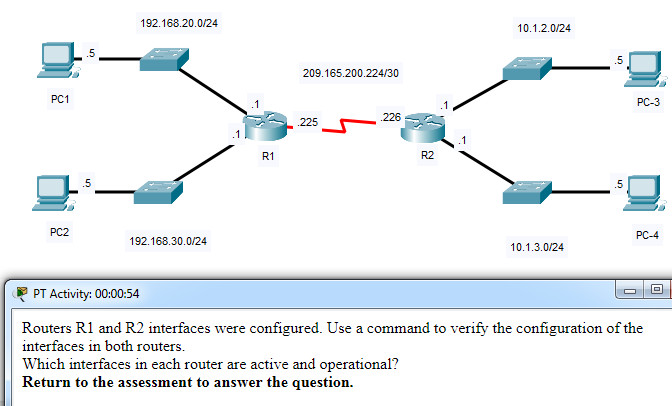
CCNA 1 v7 Modules 8 – 10 Communicating Between Networks Exam
R1: G0/0 and S0/0/1
R2: G0/1 and S0/0/1
R1: G0/1 and S0/0/1
R2: G0/0 and S0/0/1
R1: G0/0 and S0/0/0
R2: G0/1 and S0/0/0
R1: G0/0 and S0/0/0
R2: G0/0 and S0/0/0
231. What is the prefix length notation for the subnet mask 255.255.255.224?
Explanation: The
binary format for 255.255.255.224 is
11111111.11111111.11111111.11100000. The prefix length is the number of
consecutive 1s in the subnet mask. Therefore, the prefix length is /27.
232. How many valid host addresses are available on an IPv4 subnet that is configured with a /26 mask?
233. Which subnet mask would be used if 5 host bits are available?
- 255.255.255.0
- 255.255.255.128
- 255.255.255.224
- 255.255.255.240
234. A network administrator subnets the 192.168.10.0/24
network into subnets with /26 masks. How many equal-sized subnets are
created?
235. Match the subnetwork to a host address that would be included within the subnetwork. (Not all options are used.)
236. An administrator wants to create four subnetworks from
the network address 192.168.1.0/24. What is the network address and
subnet mask of the second useable subnet?
- subnetwork 192.168.1.64
subnet mask 255.255.255.192
- subnetwork 192.168.1.32
subnet mask 255.255.255.240
- subnetwork 192.168.1.64
subnet mask 255.255.255.240
- subnetwork 192.168.1.128
subnet mask 255.255.255.192
- subnetwork 192.168.1.8
subnet mask 255.255.255.224
237. How many bits must be borrowed from the host portion of an address to accommodate a router with five connected networks?
Explanation: Each
network that is directly connected to an interface on a router requires
its own subnet. The formula 2n, where n is the number of bits borrowed,
is used to calculate the available number of subnets when borrowing a
specific number of bits.
238. How many host addresses are available on the 192.168.10.128/26 network?
Explanation: A /26
prefix gives 6 host bits, which provides a total of 64 addresses,
because 26 = 64. Subtracting the network and broadcast addresses leaves
62 usable host addresses.
239. How many host addresses are available on the network 172.16.128.0 with a subnet mask of 255.255.252.0?
- 510
- 512
- 1022
- 1024
- 2046
- 2048
Explanation: A mask
of 255.255.252.0 is equal to a prefix of /22. A /22 prefix provides 22
bits for the network portion and leaves 10 bits for the host portion.
The 10 bits in the host portion will provide 1022 usable IP addresses
(210 – 2 = 1022).
240. Match each IPv4 address to the appropriate address category. (Not all options are used.)
241. What three blocks of addresses are defined by RFC 1918 for private network use? (Choose three.)
- 10.0.0.0/8
- 172.16.0.0/12
- 192.168.0.0/16
- 100.64.0.0/14
- 169.254.0.0/16
- 239.0.0.0/8
Explanation: RFC
1918, Address Allocation for Private Internets, defines three blocks of
IPv4 address for private networks that should not be routable on the
public Internet.
- 10.0.0.0/8
- 172.16.0.0/12
- 192.168.0.0/16
242. Refer to the exhibit. An administrator must send a
message to everyone on the router A network. What is the broadcast
address for network 172.16.16.0/22?
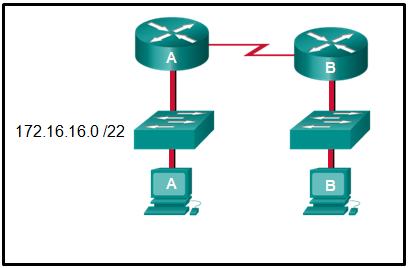
- 172.16.16.255
- 172.16.20.255
- 172.16.19.255
- 172.16.23.255
- 172.16.255.255
Explanation: The
172.16.16.0/22 network has 22 bits in the network portion and 10 bits in
the host portion. Converting the network address to binary yields a
subnet mask of 255.255.252.0. The range of addresses in this network
will end with the last address available before 172.16.20.0. Valid host
addresses for this network range from 172.16.16.1-172.16.19.254, making
172.16.19.255 the broadcast address.
243. A site administrator has been told that a particular
network at the site must accommodate 126 hosts. Which subnet mask would
be used that contains the required number of host bits?
- 255.255.255.0
- 255.255.255.128
- 255.255.255.224
- 255.255.255.240
Explanation: The
subnet mask of 255.255.255.0 has 8 host bits. The mask of
255.255.255.128 results in 7 host bits. The mask of 255.255.255.224 has 5
host bits. Finally, 255.255.255.240 represents 4 host bits.
244. Refer to the exhibit. Considering the addresses already
used and having to remain within the 10.16.10.0/24 network range, which
subnet address could be assigned to the network containing 25 hosts?
- 10.16.10.160/26
- 10.16.10.128/28
- 10.16.10.64/27
- 10.16.10.224/26
- 10.16.10.240/27
- 10.16.10.240/28
Explanation:
Addresses 10.16.10.0 through 10.16.10.63 are taken for the leftmost
network. Addresses 10.16.10.192 through 10.16.10.207 are used by the
center network.The address space from 208-255 assumes a /28 mask, which
does not allow enough host bits to accommodate 25 host addresses.The
address ranges that are available include 10.16.10.64/26
and10.16.10.128/26. To accommodate 25 hosts, 5 host bits are needed, so a
/27 mask is necessary. Four possible /27 subnets could be created from
the available addresses between 10.16.10.64 and 10.16.10.191:
10.16.10.64/27
10.16.10.96/27
10.16.10.128/27
10.16.10.160/27
245. What is the usable number of host IP addresses on a network that has a /26 mask?
Explanation: A /26
mask is the same as 255.255.255.192. The mask leaves 6 host bits. With 6
host bits, 64 IP addresses are possible. One address represents the
subnet number and one address represents the broadcast address, which
means that 62 addresses can then be used to assign to network devices.
246. Which address prefix range is reserved for IPv4 multicast?
- 240.0.0.0 – 254.255.255.255
- 224.0.0.0 – 239.255.255.255
- 169.254.0.0 – 169.254.255.255
- 127.0.0.0 – 127.255.255.255
247. Refer to the exhibit. Match the network with the correct
IP address and prefix that will satisfy the usable host addressing
requirements for each network.
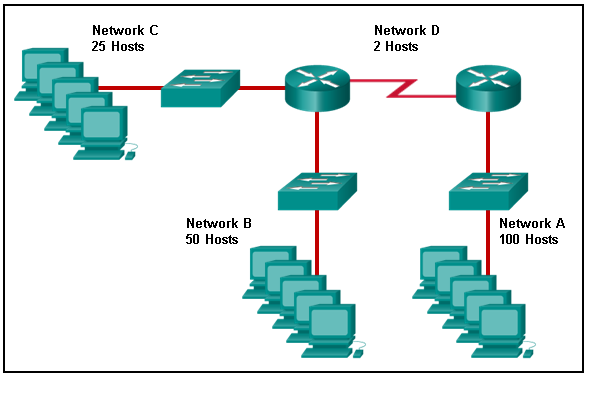
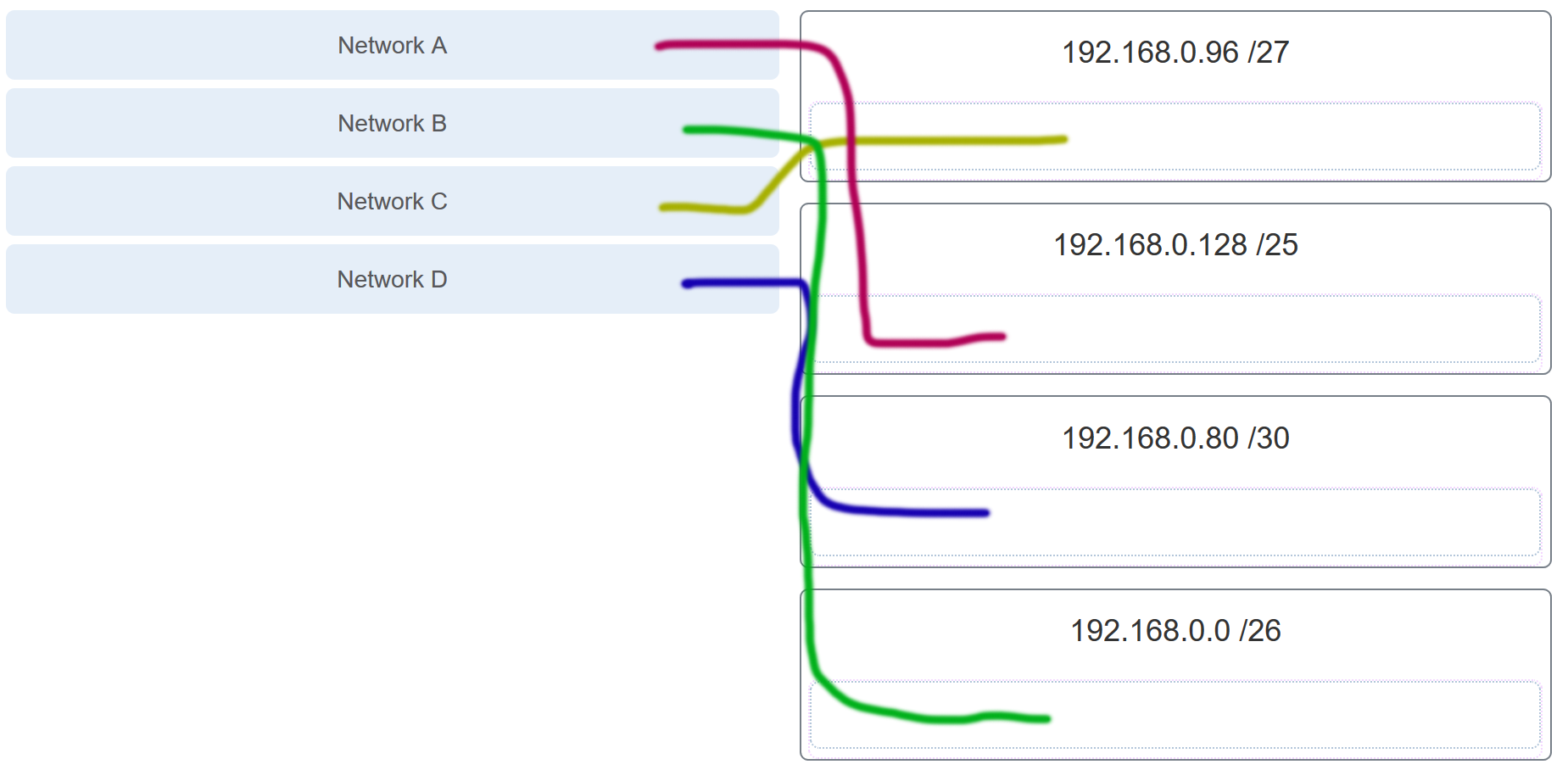
Explanation: Network A needs to use 192.168.0.128 /25, which yields 128 host addresses.
Network B needs to use 192.168.0.0 /26, which yields 64 host addresses.
Network C needs to use 192.168.0.96 /27, which yields 32 host addresses.
Network D needs to use 192.168.0.80/30, which yields 4 host addresses.
248. A high school in New York (school A) is using
videoconferencing technology to establish student interactions with
another high school (school B) in Russia. The videoconferencing is
conducted between two end devices through the Internet. The network
administrator of school A configures the end device with the IP address
209.165.201.10. The administrator sends a request for the IP address for
the end device in school B and the response is 192.168.25.10. Neither
school is using a VPN. The administrator knows immediately that this IP
will not work. Why?
- This is a loopback address.
- This is a link-local address.
- This is a private IP address.
- There is an IP address conflict.
249. Which three addresses are valid public addresses? (Choose three.)
- 198.133.219.17
- 192.168.1.245
- 10.15.250.5
- 128.107.12.117
- 172.31.1.25
- 64.104.78.227
Explanation: The ranges of private IPv4 addresses are as folllows:
10.0.0.0 – 10.255.255.255
172.16.0.0 – 172.31.255.255
192.168.0.0 – 192.168.255.255
250. A message is sent to all hosts on a remote network. Which type of message is it?
- limited broadcast
- multicast
- directed broadcast
- unicast
Explanation: A
directed broadcast is a message sent to all hosts on a specific network.
It is useful for sending a broadcast to all hosts on a nonlocal
network. A multicast message is a message sent to a selected group of
hosts that are part of a subscribing multicast group. A limited
broadcast is used for a communication that is limited to the hosts on
the local network. A unicast message is a message sent from one host to
another.
251. A company has a network address of 192.168.1.64 with a
subnet mask of 255.255.255.192. The company wants to create two
subnetworks that would contain 10 hosts and 18 hosts respectively. Which
two networks would achieve that? (Choose two.)
- 192.168.1.16/28
- 192.168.1.64/27
- 192.168.1.128/27
- 192.168.1.96/28
- 192.168.1.192/28
252. Which address is a valid IPv6 link-local unicast address?
- FEC8:1::FFFF
- FD80::1:1234
- FE80::1:4545:6578:ABC1
- FE0A::100:7788:998F
- FC90:5678:4251:FFFF
Explanation: IPv6
LLAs are in the fe80::/10 range. The /10 indicates that the first 10
bits are 1111 1110 10xx xxxx. The first hextet has a range of 1111 1110
1000 0000 (fe80) to 1111 1110 1011 1111 (febf).
253. Which of these addresses is the shortest abbreviation for the IP address:
3FFE:1044:0000:0000:00AB:0000:0000:0057?
- 3FFE:1044::AB::57
- 3FFE:1044::00AB::0057
- 3FFE:1044:0:0:AB::57
- 3FFE:1044:0:0:00AB::0057
- 3FFE:1044:0000:0000:00AB::57
- 3FFE:1044:0000:0000:00AB::0057
Explanation: The rules for reducing the notation of IPv6 addresses are:
1. Omit any leading 0s (zeros) in any hextet.
2. Replace any single, contiguous string of one or more 16-bit hextets consisting of all zeros with a double colon (::) .
3. The double colon (::) can only be used once within an address.
254. A network administrator has received the IPv6 prefix
2001:DB8::/48 for subnetting. Assuming the administrator does not subnet
into the interface ID portion of the address space, how many subnets
can the administrator create from the /48 prefix?
Explanation: With a
network prefix of 48, there will be 16 bits available for subnetting
because the interface ID starts at bit 64. Sixteen bits will yield 65536
subnets.
255. Given IPv6 address prefix 2001:db8::/48, what will be
the last subnet that is created if the subnet prefix is changed to /52?
- 2001:db8:0:f00::/52
- 2001:db8:0:8000::/52
- 2001:db8:0:f::/52
- 2001:db8:0:f000::/52
Explanation: Prefix
2001:db8::/48 has 48 network bits. If we subnet to a /52, we are moving
the network boundary four bits to the right and creating 16 subnets.
The first subnet is 2001:db8::/52 the last subnet is
2001:db8:0:f000::/52.
256. Consider the following range of addresses:
2001:0DB8:BC15:00A0:0000::
2001:0DB8:BC15:00A1:0000::
2001:0DB8:BC15:00A2:0000::
…
2001:0DB8:BC15:00AF:0000::
The prefix-length for the range of addresses is /60 .
Explanation: All
the addresses have the part 2001:0DB8:BC15:00A in common. Each number or
letter in the address represents 4 bits, so the prefix-length is /60.
257. What type of IPv6 address is FE80::1?
- loopback
- link-local
- multicast
- global unicast
258. Refer to the exhibit. A company is deploying an IPv6
addressing scheme for its network. The company design document indicates
that the subnet portion of the IPv6 addresses is used for the new
hierarchical network design, with the site subsection to represent
multiple geographical sites of the company, the sub-site section to
represent multiple campuses at each site, and the subnet section to
indicate each network segment separated by routers. With such a scheme,
what is the maximum number of subnets achieved per sub-site?
Explanation:
Because only one hexadecimal character is used to represent the subnet,
that one character can represent 16 different values 0 through F.
259. What is used in the EUI-64 process to create an IPv6 interface ID on an IPv6 enabled interface?
- the MAC address of the IPv6 enabled interface
- a randomly generated 64-bit hexadecimal address
- an IPv6 address that is provided by a DHCPv6 server
- an IPv4 address that is configured on the interface
Explanation: The
EUI-64 process uses the MAC address of an interface to construct an
interface ID (IID). Because the MAC address is only 48 bits in length,
16 additional bits (FF:FE) must be added to the MAC address to create
the full 64-bit interface ID.
260. What is the prefix for the host address 2001:DB8:BC15:A:12AB::1/64?
- 2001:DB8:BC15
- 2001:DB8:BC15:A
- 2001:DB8:BC15:A:1
- 2001:DB8:BC15:A:12
261. An IPv6 enabled device sends a data packet with the destination address of FF02::1. What is the target of this packet?
- the one IPv6 device on the link that has been uniquely configured with this address
- all IPv6 enabled devices on the local link or network
- only IPv6 DHCP servers
- only IPv6 configured routers
262. Match the IPv6 address with the IPv6 address type. (Not all options are used.)
Explanation: FF02::1:FFAE:F85F is a solicited node multicast address.
2001:DB8::BAF:3F57:FE94 is a global unicast address.
FF02::1 is the all node multicast address. Packets sent to this address will be received by all IPv6 hosts on the local link.
::1 is the IPv6 loopback address.
There are no examples of link local or unique local addresses provided.
263. Which IPv6 prefix is reserved for communication between devices on the same link?
- FC00::/7
- 2001::/32
- FE80::/10
- FDFF::/7
Explanation: IPv6
link-local unicast addresses are in the FE80::/10 prefix range and are
not routable. They are used only for communications between devices on
the same link.
264. Which type of IPv6 address refers to any unicast address that is assigned to multiple hosts?
- unique local
- global unicast
- link-local
- anycast
265. What are two types of IPv6 unicast addresses? (Choose two.)
- multicast
- loopback
- link-local
- anycast
- broadcast
Explanation:
Multicast, anycast, and unicast are types of IPv6 addresses. There is no
broadcast address in IPv6. Loopback and link-local are specific types
of unicast addresses.
266. Which service provides dynamic global IPv6 addressing to
end devices without using a server that keeps a record of available
IPv6 addresses?
- stateful DHCPv6
- SLAAC
- static IPv6 addressing
- stateless DHCPv6
Explanation: Using
stateless address autoconfiguration (SLAAC), a PC can solicit a router
and receive the prefix length of the network. From this information the
PC can then create its own IPv6 global unicast address.
267. Which protocol supports Stateless Address Autoconfiguration (SLAAC) for dynamic assignment of IPv6 addresses to a host?
Explanation: SLAAC
uses ICMPv6 messages when dynamically assigning an IPv6 address to a
host. DHCPv6 is an alternate method of assigning an IPv6 addresses to a
host. ARPv6 does not exist. Neighbor Discovery Protocol (NDP) provides
the functionality of ARP for IPv6 networks. UDP is the transport layer
protocol used by DHCPv6.
268. Three methods allow IPv6 and IPv4 to co-exist. Match each method with its description. (Not all options are used.)
269. A technician uses the ping 127.0.0.1 command. What is the technician testing?
- the TCP/IP stack on a network host
- connectivity between two adjacent Cisco devices
- connectivity between a PC and the default gateway
- connectivity between two PCs on the same network
- physical connectivity of a particular PC and the network
270. Refer to the exhibit. An administrator is trying to
troubleshoot connectivity between PC1 and PC2 and uses the tracert
command from PC1 to do it. Based on the displayed output, where should
the administrator begin troubleshooting?
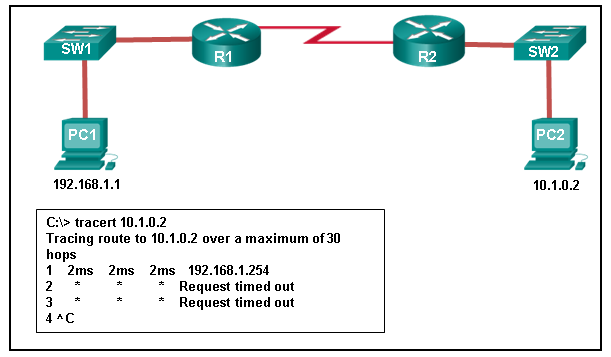 271. Which protocol is used by the traceroute command to send and receive echo-requests and echo-replies?
271. Which protocol is used by the traceroute command to send and receive echo-requests and echo-replies?
Explanation: Traceroute uses the ICMP (Internet Control Message Protocol) to send and receive echo-request and echo-reply messages.
272. Which ICMPv6 message is sent when the IPv6 hop limit
field of a packet is decremented to zero and the packet cannot be
forwarded?
- network unreachable
- time exceeded
- protocol unreachable
- port unreachable
273. A user executes a traceroute over IPv6. At what point would a router in the path to the destination device drop the packet?
- when the value of the Hop Limit field reaches 255
- when the value of the Hop Limit field reaches zero
- when the router receives an ICMP time exceeded message
- when the target host responds with an ICMP echo reply message
274. What is the purpose of ICMP messages?
- to inform routers about network topology changes
- to ensure the delivery of an IP packet
- to provide feedback of IP packet transmissions
- to monitor the process of a domain name to IP address resolution
Explanation: The purpose of ICMP messages is to provide feedback about issues that are related to the processing of IP packets.
275. What source IP address does a router use by default when the traceroute command is issued?
- the highest configured IP address on the router
- a loopback IP address
- the IP address of the outbound interface
- the lowest configured IP address on the router
Explanation: When
sending an echo request message, a router will use the IP address of the
exit interface as the source IP address. This default behavior can be
changed by using an extended ping and specifying a specific source IP
address.
276. Match each description with an appropriate IP address. (Not all options are used.)

Explanation:
Link-Local addresses are assigned automatically by the OS environment
and are located in the block 169.254.0.0/16. The private addresses
ranges are 10.0.0.0/8, 172.16.0.0/12, and 192.168.0.0/16. TEST-NET
addresses belong to the range 192.0.2.0/24. The addresses in the block
240.0.0.0 to 255.255.255.254 are reserved as experimental addresses.
Loopback addresses belong to the block 127.0.0.0/8.
277. A user issues a ping 192.135.250.103 command and
receives a response that includes a code of 1. What does this code
represent?
- host unreachable
- protocol unreachable
- port unreachable
- network unreachable
278. Which subnet would include the address 192.168.1.96 as a usable host address?
- 192.168.1.64/26
- 192.168.1.32/27
- 192.168.1.32/28
- 192.168.1.64/29
Explanation: For
the subnet of 192.168.1.64/26, there are 6 bits for host addresses,
yielding 64 possible addresses. However, the first and last subnets are
the network and broadcast addresses for this subnet. Therefore, the
range of host addresses for this subnet is 192.168.1.65 to
192.168.1.126. The other subnets do not contain the address 192.168.1.96
as a valid host address.
279. Open the PT Activity. Perform the tasks in the activity instructions and then answer the question.
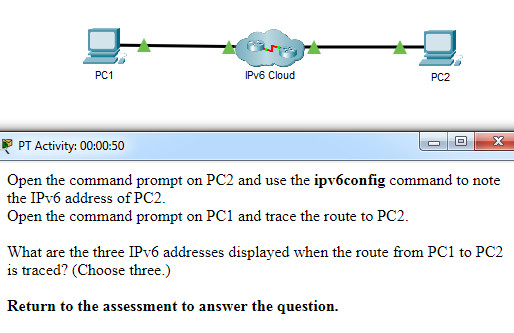
CCNA 1 v7 Modules 11 – 13 IP Addressing Exam Answers Full
What are the three IPv6 addresses displayed when the route from PC1 to PC2 is traced? (Choose three.)
- 2001:DB8:1:1::1
- 2001:DB8:1:1::A
- 2001:DB8:1:2::2
- 2001:DB8:1:2::1
- 2001:DB8:1:3::1
- 2001:DB8:1:3::2
- 2001:DB8:1:4::1
Explanation: Using the ipv6config command
on PC2 displays the IPv6 address of PC2, which is 2001:DB8:1:4::A. The
IPV6 link-local address, FE80::260:70FF:FE34:6930, is not used in route
tracing. Using the tracert 2001:DB8:1:4::A command on PC1 displays four addresses: 2001:DB8:1:1::1, 2001:DB8:1:2::1 , 2001:DB8:1:3::2, and 2001:DB8:1:4::A.
280. A host is transmitting a broadcast. Which host or hosts will receive it?
- all hosts in the same subnet
- a specially defined group of hosts
- the closest neighbor on the same network
- all hosts on the Internet
281. A host is transmitting a unicast. Which host or hosts will receive it?
- one specific host
- a specially defined group of hosts
- all hosts on the Internet
- the closest neighbor on the same network
282. A user issues a ping 2001:db8:FACE:39::10 command and
receives a response that includes a code of 3. What does this code
represent?
- address unreachable
- network unreachable
- host unreachable
- protocol unreachable
283. A host is transmitting a multicast. Which host or hosts will receive it?
- a specially defined group of hosts
- one specific host
- all hosts with the same IP address
- the closest neighbor on the same network
284. A host is transmitting a multicast. Which host or hosts will receive it?
- a specially defined group of hosts
- one specific host
- directly connected network devices
- the closest neighbor on the same network
285. A host is transmitting a multicast. Which host or hosts will receive it?
- a specially defined group of hosts
- one specific host
- all hosts with the same IP address
- all hosts on the Internet
286. A host is transmitting a multicast. Which host or hosts will receive it?
- a specially defined group of hosts
- one specific host
- directly connected network devices
- all hosts on the Internet
287. A host is transmitting a multicast. Which host or hosts will receive it?
- a specially defined group of hosts
- all hosts in the same subnet
- directly connected network devices
- the closest neighbor on the same network
288. A host is transmitting a broadcast. Which host or hosts will receive it?
- all hosts in the same subnet
- one specific host
- the closest neighbor on the same network
- directly connected network devices
289. A host is transmitting a broadcast. Which host or hosts will receive it?
- all hosts in the same subnet
- one specific host
- all hosts on the Internet
- directly connected network devices
290. Which is the compressed format of the IPv6 address 2001:0db8:0000:0000:0000:a0b0:0008:0001?
- 2001:db8::a0b0:8:1
- 2001:db8::ab8:1:0:1000
- 2001:db80:0:1::80:1
- 2001:db80:::1::80:1
291. Which is the compressed format of the IPv6 address fe80:09ea:0000:2200:0000:0000:0fe0:0290?
- fe80:9ea:0:2200::fe0:290
- fe80:9:20::b000:290
- fe80:9ea0::2020:0:bf:e0:9290
- fe80:9ea0::2020::bf:e0:9290
292. Which is the compressed format of the IPv6 address 2002:0042:0010:c400:0000:0000:0000:0909?
- 2002:42:10:c400::909
- 200:420:110:c4b::910:0:90
- 2002:4200::25:1090:0:99
- 2002:42::25:1090:0:99
293. Which is the compressed format of the IPv6 address 2001:0db8:0000:0000:0ab8:0001:0000:1000?
- 2001:db8::ab8:1:0:1000
- 2001:db8::a0b0:8:1
- 2001:db8:1::ab8:0:1
- 2001:db8:0:1::8:1
294. Which is the compressed format of the IPv6 address 2002:0420:00c4:1008:0025:0190:0000:0990?
- 2002:420:c4:1008:25:190::990
- 2002:42:10:c400::909
- 2002:4200::25:1090:0:99
- 2002:42::25:1090:0:99
295. Which is the compressed format of the IPv6 address 2001:0db8:0000:0000:0000:a0b0:0008:0001?
- 2001:db8::a0b0:8:1
- 2001:db8:1::ab8:0:1
- 2001:db8::ab8:1:0:1000
- 2001:db8:0:1::8:1
296. Which is the compressed format of the IPv6 address fe80:0000:0000:0000:0220:0b3f:f0e0:0029?
- fe80::220:b3f:f0e0:29
- fe80:9ea:0:2200::fe0:290
- fe80:9ea0::2020:0:bf:e0:9290
- fe80:9ea0::2020::bf:e0:9290
297. Which is the compressed format of the IPv6 address 2001:0db8:0000:0000:0000:a0b0:0008:0001?
- 2001:db8::a0b0:8:1
- 2001:db8::ab8:1:0:1000
- 2001:db80:0:1::80:1
- 2001:db8:0:1::8:1
298. Which is the compressed format of the IPv6 address 2002:0042:0010:c400:0000:0000:0000:0909?
- 2002:42:10:c400::909
- 2002:4200::25:1090:0:99
- 2002:420:c4:1008:25:190::990
- 2002:42::25:1090:0:99
299. Which is the compressed format of the IPv6 address fe80:09ea:0000:2200:0000:0000:0fe0:0290?
- fe80:9ea:0:2200::fe0:290
- fe80:9ea0::2020:0:bf:e0:9290
- fe80::220:b3f:f0e0:29
- fe80::0220:0b3f:f0e0:0029
300. A user issues a ping 2001:db8:FACE:39::10 command and
receives a response that includes a code of 2 . What does this code
represent?
- beyond scope of the source address
- communication with the destination administratively prohibited
- address unreachable
- no route to destination
301. A user issues a ping 192.135.250.103 command and
receives a response that includes a code of 1. What does this code
represent?
- host unreachable
- beyond scope of the source address
- address unreachable
- communication with the destination administratively prohibited
302. A user issues a ping fe80:65ab:dcc1::100 command and
receives a response that includes a code of 3. What does this code
represent?
- address unreachable
- communication with the destination administratively prohibited
- beyond scope of the source address
- no route to destination
303. A user issues a ping 10.10.14.67 command and receives a response that includes a code of 0. What does this code represent?
- network unreachable
- protocol unreachable
- port unreachable
- host unreachable
304. A user issues a ping fe80:65ab:dcc1::100 command and
receives a response that includes a code of 4. What does this code
represent?
- port unreachable
- host unreachable
- protocol unreachable
- network unreachable
305. A user issues a ping 198.133.219.8 command and receives a
response that includes a code of 0. What does this code represent?
- network unreachable
- protocol unreachable
- port unreachable
- host unreachable
306. A user issues a ping 2001:db8:3040:114::88 command and
receives a response that includes a code of 4. What does this code
represent?
- port unreachable
- host unreachable
- protocol unreachable
- network unreachable
307. A user issues a ping 2001:db8:FACE:39::10 command and
receives a response that includes a code of 2. What does this code
represent?
- beyond scope of the source address
- host unreachable
- protocol unreachable
- network unreachable
308. Which action is performed by a client when establishing
communication with a server via the use of UDP at the transport layer?
- The client sets the window size for the session.
- The client sends an ISN to the server to start the 3-way handshake.
- The client randomly selects a source port number.
- The client sends a synchronization segment to begin the session.
309. Which transport layer feature is used to guarantee session establishment?
- UDP ACK flag
- TCP 3-way handshake
- UDP sequence number
- TCP port number
310. What is the complete range of TCP and UDP well-known ports?
- 0 to 255
- 0 to 1023
- 256 – 1023
- 1024 – 49151
311. What is a socket?
- the combination of the source and destination IP address and source and destination Ethernet address
- the combination of a source IP address and port number or a destination IP address and port number
- the combination of the source and destination sequence and acknowledgment numbers
- the combination of the source and destination sequence numbers and port numbers
312. A PC is downloading a large file from a server. The TCP
window is 1000 bytes. The server is sending the file using 100-byte
segments. How many segments will the server send before it requires an
acknowledgment from the PC?
- 1 segment
- 10 segments
- 100 segments
- 1000 segments
313. Which factor determines TCP window size?
- the amount of data to be transmitted
- the number of services included in the TCP segment
- the amount of data the destination can process at one time
- the amount of data the source is capable of sending at one time
Explanation: Window
is the number of bytes that the sender will send prior to expecting an
acknowledgement from the destination device. The initial window is
agreed upon during the session startup via the three-way handshake
between source and destination. It is determined by how much data the
destination device of a TCP session is able to accept and process at one
time.
314. What does a client do when it has UDP datagrams to send?
- It just sends the datagrams.
- It queries the server to see if it is ready to receive data.
- It sends a simplified three-way handshake to the server.
- It sends to the server a segment with the SYN flag set to synchronize the conversation.
Explanation: When a client has UDP datagrams to send, it just sends the datagrams.
315. Which three fields are used in a UDP segment header? (Choose three.)
- Window Size
- Length
- Source Port
- Acknowledgment Number
- Checksum
- Sequence Number
Explanation: A UDP
header consists of only the Source Port, Destination Port, Length, and
Checksum fields. Sequence Number, Acknowledgment Number, and Window Size
are TCP header fields.
316. What are two roles of the transport layer in data communication on a network? (Choose two.)
- identifying the proper application for each communication stream
- tracking the individual communication between applications on the source and destination hosts
- providing frame delimiting to identify bits making up a frame
- performing a cyclic redundancy check on the frame for errors
- providing the interface between applications and the underlying network over which messages are transmitted
Explanation: The transport layer has several responsibilities. The primary responsibilities include the following:
- Tracking the individual communication streams between applications on the source and destination hosts
- Segmenting data at the source and reassembling the data at the destination
- Identifying the proper application for each communication stream through the use of port numbers
317. What information is used by TCP to reassemble and reorder received segments?
- port numbers
- sequence numbers
- acknowledgment numbers
- fragment numbers
318. What important information is added to the TCP/IP
transport layer header to ensure communication and connectivity with a
remote network device?
- timing and synchronization
- destination and source port numbers
- destination and source physical addresses
- destination and source logical network addresses
319. Which two characteristics are associated with UDP sessions? (Choose two.)
- Destination devices receive traffic with minimal delay.
- Transmitted data segments are tracked.
- Destination devices reassemble messages and pass them to an application.
- Received data is unacknowledged.
- Unacknowledged data packets are retransmitted.
Explanation:
TCP:
- Provides tracking of transmitted data segments
- Destination devices will acknowledge received data.
- Source devices will retransmit unacknowledged data.
UDP
- Destination devices will not acknowledge received data
- Headers use very little overhead and cause minimal delay.
320. A client application needs to terminate a TCP
communication session with a server. Place the termination process steps
in the order that they will occur. (Not all options are used.)
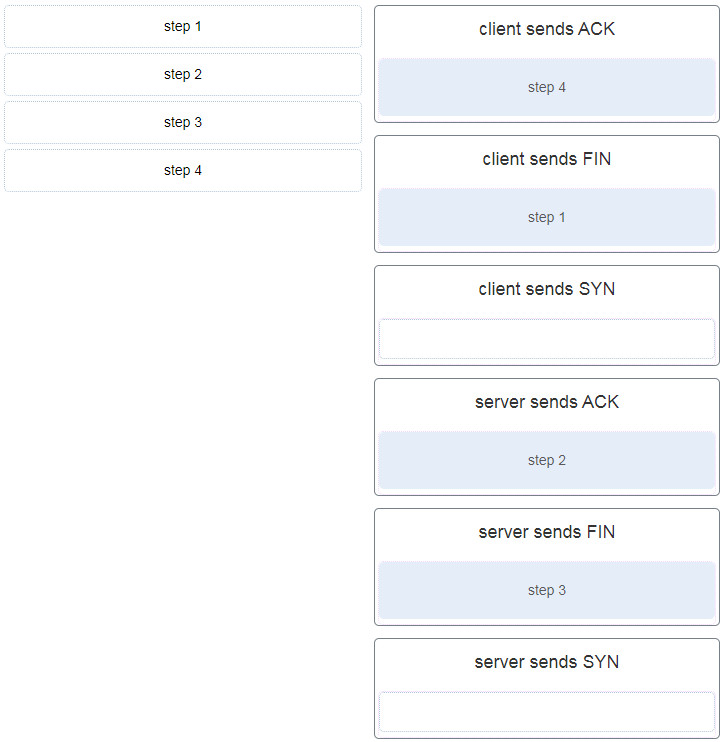 321. Which flag in the TCP header is used in response to a
received FIN in order to terminate connectivity between two network
devices?
322. Which protocol or service uses UDP for a client-to-server communication and TCP for server-to-server communication?
321. Which flag in the TCP header is used in response to a
received FIN in order to terminate connectivity between two network
devices?
322. Which protocol or service uses UDP for a client-to-server communication and TCP for server-to-server communication?
Explanation: Some
applications may use both TCP and UDP. DNS uses UDP when clients send
requests to a DNS server, and TCP when two DNS serves directly
communicate.
323. What is a characteristic of UDP?
- UDP datagrams take the same path and arrive in the correct order at the destination.
- Applications that use UDP are always considered unreliable.
- UDP reassembles the received datagrams in the order they were received.
- UDP only passes data to the network when the destination is ready to receive the data.
Explanation: UDP
has no way to reorder the datagrams into their transmission order, so
UDP simply reassembles the data in the order it was received and
forwards it to the application.
324. What kind of port must be requested from IANA in order to be used with a specific application?
- registered port
- private port
- dynamic port
- source port
Explanation:
Registered ports (numbers 1024 to 49151) are assigned by IANA to a
requesting entity to use with specific processes or applications. These
processes are primarily individual applications that a user has chosen
to install, rather than common applications that would receive a
well-known port number. For example, Cisco has registered port 1985 for
its Hot Standby Routing Protocol (HSRP) process.
325. Which three application layer protocols use TCP? (Choose three.)
- SMTP
- FTP
- SNMP
- HTTP
- TFTP
- DHCP
Explanation: Some
protocols require the reliable data transport that is provided by TCP.
In addition, these protocols do not have real time communication
requirements and can tolerate some data loss while minimizing protocol
overhead. Examples of these protocols are SMTP, FTP, and HTTP.
326. Which three statements characterize UDP? (Choose three.)
- UDP provides basic connectionless transport layer functions.
- UDP provides connection-oriented, fast transport of data at Layer 3.
- UDP relies on application layer protocols for error detection.
- UDP is a low overhead protocol that does not provide sequencing or flow control mechanisms.
- UDP relies on IP for error detection and recovery.
- UDP provides sophisticated flow control mechanisms.
327. Which two fields are included in the TCP header but not in the UDP header? (Choose two.)
- window
- checksum
- source port
- destination port
- sequence number
Explanation: The sequence number and window fields are included in the TCP header but not in the UDP header.
328. Which field in the TCP header indicates the status of the three-way handshake process?
- window
- reserved
- checksum
- control bits
Explanation: The value in the control bits field of theTCP header indicates the progress and status of the connection.
329. Why does HTTP use TCP as the transport layer protocol?
- to ensure the fastest possible download speed
- because HTTP is a best-effort protocol
- because transmission errors can be tolerated easily
- because HTTP requires reliable delivery
330. Which two types of applications are best suited for UDP? (Choose two.)
- applications that need data flow control
- applications that require reliable delivery
- applications that handle reliability themselves
- applications that need the reordering of segments
- applications that can tolerate some data loss, but require little or no delay
331. How are port numbers used in the TCP/IP encapsulation process?
- Source port numbers and destination port numbers are not necessary
when UDP is the transport layer protocol being used for the
communication.
- Source port and destination port numbers are randomly generated.
- If multiple conversations
occur that are using the same service, the source port number is used to
track the separate conversations.
- Destination port numbers are assigned automatically and cannot be changed.
Explanation: Both
UDP and TCP use port numbers to provide a unique identifier for each
conversation. Source port numbers are randomly generated and are used to
track different conversations. Destination port numbers identify
specific services by using either a default port number for the service
or a port number that is assigned manually by a system administrator.
332. In what two situations would UDP be better than TCP as the preferred transport protocol? (Choose two.)
- when applications need to guarantee that a packet arrives intact, in sequence, and unduplicated
- when a faster delivery mechanism is needed
- when delivery overhead is not an issue
- when applications do not need to guarantee delivery of the data
- when destination port numbers are dynamic
Explanation: UDP is
a very simple transport layer protocol that does not guarantee
delivery. Devices on both ends of the conversation are not required to
keep track of the conversation. UDP is used as the transport protocol
for applications that need a speedy, best-effort delivery.
333. What are three responsibilities of the transport layer? (Choose three.)
- meeting the reliability requirements of applications, if any
- multiplexing multiple communication streams from many users or applications on the same network
- identifying the applications and services on the client and server that should handle transmitted data
- directing packets towards the destination network
- formatting data into a compatible form for receipt by the destination devices
- conducting error detection of the contents in frames
334. Which three statements describe a DHCP Discover message? (Choose three.)
- The source MAC address is 48 ones (FF-FF-FF-FF-FF-FF).
- The destination IP address is 255.255.255.255.
- The message comes from a server offering an IP address.
- The message comes from a client seeking an IP address.
- All hosts receive the message, but only a DHCP server replies.
- Only the DHCP server receives the message.
Explanation: When a
host configured to use DHCP powers up on a network it sends a
DHCPDISCOVER message. FF-FF-FF-FF-FF-FF is the L2 broadcast address. A
DHCP server replies with a unicast DHCPOFFER message back to the host.
335. Which two protocols may devices use in the application process that sends email? (Choose two.)
- HTTP
- SMTP
- POP
- IMAP
- DNS
- POP3
336. What is true about the Server Message Block protocol?
- Different SMB message types have a different format.
- Clients establish a long term connection to servers.
- SMB messages cannot authenticate a session.
- SMB uses the FTP protocol for communication.
Explanation: The
Server Message Block protocol is a protocol for file, printer, and
directory sharing. Clients establish a long term connection to servers
and when the connection is active, the resources can be accessed. Every
SMB message has the same format. The use of SMB differs from FTP mainly
in the length of the sessions. SMB messages can authenticate sessions.
337. What is the function of the HTTP GET message?
- to request an HTML page from a web server
- to send error information from a web server to a web client
- to upload content to a web server from a web client
- to retrieve client email from an email server using TCP port 110
338. Which OSI layer provides the interface between the
applications used to communicate and the underlying network over which
messages are transmitted?
- application
- presentation
- session
- transport
339. Which networking model is being used when an author uploads one chapter document to a file server of a book publisher?
- peer-to-peer
- master-slave
- client/server
- point-to-point
Explanation: In the
client/server network model, a network device assumes the role of
server in order to provide a particular service such as file transfer
and storage. In the client/server network model, a dedicated server does
not have to be used, but if one is present, the network model being
used is the client/server model. In contrast, a peer-to-peer network
does not have a dedicated server.
340. What do the client/server and peer-to-peer network models have in common?
- Both models have dedicated servers.
- Both models support devices in server and client roles.
- Both models require the use of TCP/IP-based protocols.
- Both models are used only in the wired network environment.
Explanation: In
both the client/server and peer-to-peer network models, clients and
servers exist. In peer-to-peer networks, no dedicated server exists, but
a device can assume the server role to provide information to a device
serving in the client role.
341. In what networking model would eDonkey, eMule, BitTorrent, Bitcoin, and LionShare be used?
- peer-to-peer
- client-based
- master-slave
- point-to-point
Explanation: In a
peer-to-peer networking model, data is exchanged between two network
devices without the use of a dedicated server. Peer-to-peer applications
such as Shareaz, eDonkey, and Bitcoin allow one network device to
assume the role of server, while one or more other network devices
assume the role of client using the peer-to-peer application.
342. What is a common protocol that is used with peer-to-peer applications such as WireShare, Bearshare, and Shareaza?
- Ethernet
- Gnutella
- POP
- SMTP
343. What is a key characteristic of the peer-to-peer networking model?
- wireless networking
- social networking without the Internet
- network printing using a print server
- resource sharing without a dedicated server
Explanation: The peer-to-peer (P2P) networking model allows data, printer, and resource sharing without a dedicated server.
344. The application layer of the TCP/IP model performs the functions of what three layers of the OSI model? (Choose three.)
- physical
- session
- network
- presentation
- data link
- transport
- application
Explanation: The
network access layer of the TCP/IP model performs the same functions as
the physical and data link layers of the OSI model. The internetwork
layer equates to the network layer of the OSI model. The transport
layers are the same in both models. The application layer of the TCP/IP
model represents the session, presentation, and application layers of
the OSI model.
345. What is an example of network communication that uses the client-server model?
- A user uses eMule to download a file that is shared by a friend after the file location is determined.
- A workstation initiates an ARP to find the MAC address of a receiving host.
- A user prints a document by using a printer that is attached to a workstation of a coworker.
- A workstation initiates a DNS request when the user types www.cisco.com in the address bar of a web browser.
Explanation: When a
user types a domain name of a website into the address bar of a web
browser, a workstation needs to send a DNS request to the DNS server for
the name resolution process. This request is a client/server model
application. The eMule application is P2P. Sharing a printer on a
workstation is a peer-to-peer network. Using ARP is just a broadcast
message sent by a host.
346. Which layer in the TCP/IP model is used for formatting, compressing, and encrypting data?
- internetwork
- session
- presentation
- application
- network access
Explanation: The
application layer of the TCP/IP model performs the functions of three
layers of the OSI model – application, presentation, and session. The
application layer of the TCP/IP model is the layer that provides the
interface between the applications, is responsible for formatting,
compressing, and encrypting data, and is used to create and maintain
dialogs between source and destination applications.
347. What is an advantage of SMB over FTP?
- Only with SMB can data transfers occur in both directions.
- Only SMB establishes two simultaneous connections with the client, making the data transfer faster.
- SMB is more reliable than FTP because SMB uses TCP and FTP uses UDP.
- SMB clients can establish a long-term connection to the server.
348. A manufacturing company subscribes to certain hosted
services from its ISP. The services that are required include hosted
world wide web, file transfer, and e-mail. Which protocols represent
these three key applications? (Choose three.)
- FTP
- HTTP
- DNS
- SNMP
- DHCP
- SMTP
349. Which application layer protocol uses message types such as GET, PUT, and POST?
Explanation: The
GET command is a client request for data from a web server. A PUT
command uploads resources and content, such as images, to a web server. A
POST command uploads data files to a web server.
350. What type of information is contained in a DNS MX record?
- the FQDN of the alias used to identify a service
- the IP address for an FQDN entry
- the domain name mapped to mail exchange servers
- the IP address of an authoritative name server
Explanation: MX, or
mail exchange messages, are used to map a domain name to several mail
exchange servers that all belong to the same domain.
351. Which three protocols operate at the application layer of the TCP/IP model? (Choose three.)
- ARP
- TCP
- UDP
- FTP
- POP3
- DHCP
Explanation: FTP,
DHCP, and POP3 are application layer protocols. TCP and UDP are
transport layer protocols. ARP is a network layer protocol.
352. Which protocol is used by a client to communicate securely with a web server?
Explanation: HTTPS is a secure form of HTTP used to access web content hosted by a web server.
353. Which applications or services allow hosts to act as client and server at the same time?
- client/server applications
- email applications
- P2P applications
- authentication services
354. What are two characteristics of peer-to-peer networks? (Choose two.)
- scalability
- one way data flow
- decentralized resources
- centralized user accounts
- resource sharing without a dedicated server
Explanation:
Peer-to-peer networks have decentralized resources because every
computer can serve as both a server and a client. One computer might
assume the role of server for one transaction while acting as a client
for another transaction. Peer-to-peer networks can share resources among
network devices without the use of a dedicated server.
355. Which scenario describes a function provided by the transport layer?
- A student is using a classroom VoIP phone to call home. The unique
identifier burned into the phone is a transport layer address used to
contact another network device on the same network.
- A student is playing a short web-based movie with sound. The movie and sound are encoded within the transport layer header.
- A student has two web browser
windows open in order to access two web sites. The transport layer
ensures the correct web page is delivered to the correct browser window.
- A corporate worker is accessing a web server located on a corporate
network. The transport layer formats the screen so the web page appears
properly no matter what device is being used to view the web site.
Explanation: The source and destination port numbers are used to identify the correct application and window within that application.
356. Which three layers of the OSI model provide similar
network services to those provided by the application layer of the
TCP/IP model? (Choose three.)
- physical layer
- session layer
- transport layer
- application layer
- presentation layer
- data link layer
Explanation: The
three upper layers of the OSI model, the session, presentation, and
application layers, provide application services similar to those
provided by the TCP/IP model application layer. Lower layers of the OSI
model are more concerned with data flow.
357. A PC that is communicating with a web server has a TCP
window size of 6,000 bytes when sending data and a packet size of 1,500
bytes. Which byte of information will the web server acknowledge after
it has received two packets of data from the PC?
358. A PC that is communicating with a web server has a TCP
window size of 6,000 bytes when sending data and a packet size of 1,500
bytes. Which byte of information will the web server acknowledge after
it has received three packets of data from the PC?
359. A PC that is communicating with a web server has a TCP
window size of 6,000 bytes when sending data and a packet size of 1,500
bytes. Which byte of information will the web server acknowledge after
it has received four packets of data from the PC?
360. A PC that is communicating with a web server has a TCP
window size of 6,000 bytes when sending data and a packet size of 1,500
bytes. Which byte of information will the web server acknowledge after
it has received four packets of data from the PC?
361. A PC that is communicating with a web server has a TCP
window size of 6,000 bytes when sending data and a packet size of 1,500
bytes. Which byte of information will the web server acknowledge after
it has received two packets of data from the PC?
362. A PC that is communicating with a web server has a TCP
window size of 6,000 bytes when sending data and a packet size of 1,500
bytes. Which byte of information will the web server acknowledge after
it has received two packets of data from the PC?
363. A PC that is communicating with a web server has a TCP
window size of 6,000 bytes when sending data and a packet size of 1,500
bytes. Which byte of information will the web server acknowledge after
it has received two packets of data from the PC?
364. A PC that is communicating with a web server has a TCP
window size of 6,000 bytes when sending data and a packet size of 1,500
bytes. Which byte of information will the web server acknowledge after
it has received two packets of data from the PC?
365. A PC that is communicating with a web server has a TCP
window size of 6,000 bytes when sending data and a packet size of 1,500
bytes. Which byte of information will the web server acknowledge after
it has received three packets of data from the PC?
366. A PC that is communicating with a web server has a TCP
window size of 6,000 bytes when sending data and a packet size of 1,500
bytes. Which byte of information will the web server acknowledge after
it has received three packets of data from the PC?
367. A client creates a packet to send to a server. The
client is requesting TFTP service. What number will be used as the
destination port number in the sending packet?
368. A client creates a packet to send to a server. The
client is requesting FTP service. What number will be used as the
destination port number in the sending packet?
369. A client creates a packet to send to a server. The
client is requesting SSH service. What number will be used as the
destination port number in the sending packet?
370. A client creates a packet to send to a server. The
client is requesting HTTP service. What number will be used as the
destination port number in the sending packet?
371. A client creates a packet to send to a server. The
client is requesting POP3 service. What number will be used as the
destination port number in the sending packet?
372. A client creates a packet to send to a server. The
client is requesting telnet service. What number will be used as the
destination port number in the sending packet?
373. A client creates a packet to send to a server. The
client is requesting POP3 service. What number will be used as the
destination port number in the sending packet?
374. A client creates a packet to send to a server. The
client is requesting SNMP service. What number will be used as the
destination port number in the sending packet?
375. A client creates a packet to send to a server. The
client is requesting SMTP service. What number will be used as the
destination port number in the sending packet?
376. A client creates a packet to send to a server. The
client is requesting HTTPS service. What number will be used as the
destination port number in the sending packet?
377. Which component is designed to protect against unauthorized communications to and from a computer?
- security center
- port scanner
- antimalware
- antivirus
- firewall
378. Which command will block login attempts on RouterA for a
period of 30 seconds if there are 2 failed login attempts within 10
seconds?
- RouterA(config)# login block-for 10 attempts 2 within 30
- RouterA(config)# login block-for 30 attempts 2 within 10
- RouterA(config)# login block-for 2 attempts 30 within 10
- RouterA(config)# login block-for 30 attempts 10 within 2
379. What is the purpose of the network security accounting function?
- to require users to prove who they are
- to determine which resources a user can access
- to keep track of the actions of a user
- to provide challenge and response questions
380. What type of attack may involve the use of tools such as nslookup and fping?
- access attack
- reconnaissance attack
- denial of service attack
- worm attack
381. Match each weakness with an example. (Not all options are used.)
 382. Match the type of information security threat to the scenario. (Not all options are used.)
382. Match the type of information security threat to the scenario. (Not all options are used.)
 383. Which example of malicious code would be classified as a Trojan horse?
383. Which example of malicious code would be classified as a Trojan horse?
- malware that was written to look like a video game
- malware that requires manual user intervention to spread between systems
- malware that attaches itself to a legitimate program and spreads to other programs when launched
- malware that can automatically spread from one system to another by exploiting a vulnerability in the target
384. What is the difference between a virus and a worm?
- Viruses self-replicate but worms do not.
- Worms self-replicate but viruses do not.
- Worms require a host file but viruses do not.
- Viruses hide in legitimate programs but worms do not.
Explanation: Worms are able to self-replicate and exploit vulnerabilities on computer networks without user participation.
385. Which attack involves a compromise of data that occurs between two end points?
- denial-of-service
- man-in-the-middle attack
- extraction of security parameters
- username enumeration
Explanation: Threat
actors frequently attempt to access devices over the internet through
communication protocols. Some of the most popular remote exploits are as
follows:
- Man-In-the-middle attack (MITM) – The threat actor
gets between devices in the system and intercepts all of the data being
transmitted. This information could simply be collected or modified for a
specific purpose and delivered to its original destination.
- Eavesdropping attack – When devices are being
installed, the threat actor can intercept data such as security keys
that are used by constrained devices to establish communications once
they are up and running.
- SQL injection (SQLi) – Threat actors uses a flaw in
the Structured Query Language (SQL) application that allows them to
have access to modify the data or gain administrative privileges.
- Routing attack – A threat actor could either place a
rogue routing device on the network or modify routing packets to
manipulate routers to send all packets to the chosen destination of the
threat actor. The threat actor could then drop specific packets, known
as selective forwarding, or drop all packets, known as a sinkhole
attack.
386. Which type of attack involves an adversary attempting to gather information about a network to identify vulnerabilities?
- reconnaissance
- DoS
- dictionary
- man-in-the-middle
387. Match the description to the type of firewall filtering. (Not all options are used.)
 388. What is the purpose of the network security authentication function?
388. What is the purpose of the network security authentication function?
- to require users to prove who they are
- to determine which resources a user can access
- to keep track of the actions of a user
- to provide challenge and response questions
Explanation:
Authentication, authorization, and accounting are network services
collectively known as AAA. Authentication requires users to prove who
they are. Authorization determines which resources the user can access.
Accounting keeps track of the actions of the user.
389. Which firewall feature is used to ensure that packets
coming into a network are legitimate responses to requests initiated
from internal hosts?
- stateful packet inspection
- URL filtering
- application filtering
- packet filtering
390. When applied to a router, which command would help mitigate brute-force password attacks against the router?
- exec-timeout 30
- service password-encryption
- banner motd $Max failed logins = 5$
- login block-for 60 attempts 5 within 60
Explanation: The login block-for
command sets a limit on the maximum number of failed login attempts
allowed within a defined period of time. If this limit is exceeded, no
further logins are allowed for the specified period of time. This helps
to mitigate brute-force password cracking since it will significantly
increase the amount of time required to crack a password. The exec-timeout command specifies how long the session can be idle before the user is disconnected. The service password-encryption command encrypts the passwords in the running configuration. The banner motd command displays a message to users who are logging in to the device.
391. Identify the steps needed to configure a switch for SSH. The answer order does not matter. (Not all options are used.)

Explanation: The login and password cisco commands are used with Telnet switch configuration, not SSH configuration.
392. What feature of SSH makes it more secure than Telnet for a device management connection?
- confidentiality with IPsec
- stronger password requirement
- random one-time port connection
- login information and data encryption
Explanation: Secure
Shell (SSH) is a protocol that provides a secure management connection
to a remote device. SSH provides security by providing encryption for
both authentication (username and password) and the transmitted data.
Telnet is a protocol that uses unsecure plaintext transmission. SSH is
assigned to TCP port 22 by default. Although this port can be changed in
the SSH server configuration, the port is not dynamically changed. SSH
does not use IPsec.
393. What is the advantage of using SSH over Telnet?
- SSH is easier to use.
- SSH operates faster than Telnet.
- SSH provides secure communications to access hosts.
- SSH supports authentication for a connection request.
Explanation: SSH
provides a secure method for remote access to hosts by encrypting
network traffic between the SSH client and remote hosts. Although both
Telnet and SSH request authentication before a connection is
established, Telnet does not support encryption of login credentials.
394. What is the role of an IPS?
- detecting and blocking of attacks in real time
- connecting global threat information to Cisco network security devices
- authenticating and validating traffic
- filtering of nefarious websites
Explanation: An intrusion prevention system (IPS) provides real-time detection and blocking of attacks.
395. A user is redesigning a network for a small company and
wants to ensure security at a reasonable price. The user deploys a new
application-aware firewall with intrusion detection capabilities on the
ISP connection. The user installs a second firewall to separate the
company network from the public network. Additionally, the user installs
an IPS on the internal network of the company. What approach is the
user implementing?
- attack based
- risk based
- structured
- layered
Explanation: Using different defenses at various points of the network creates a layered approach.
396. What is an accurate description of redundancy?
- configuring a router with a complete MAC address database to ensure that all frames can be forwarded to the correct destination
- configuring a switch with proper security to ensure that all traffic forwarded through an interface is filtered
- designing a network to use multiple virtual devices to ensure that all traffic uses the best path through the internetwork
- designing a network to use multiple paths between switches to ensure there is no single point of failure
Explanation:
Redundancy attempts to remove any single point of failure in a network
by using multiple physically cabled paths between switches in the
network.
397. A network administrator is upgrading a small business
network to give high priority to real-time applications traffic. What
two types of network services is the network administrator trying to
accommodate? (Choose two.)
- voice
- video
- instant messaging
- FTP
- SNMP
398. What is the purpose of a small company using a protocol
analyzer utility to capture network traffic on the network segments
where the company is considering a network upgrade?
- to identify the source and destination of local network traffic
- to capture the Internet connection bandwidth requirement
- to document and analyze network traffic requirements on each network segment
- to establish a baseline for security analysis after the network is upgraded
Explanation: An
important prerequisite for considering network growth is to understand
the type and amount of traffic that is crossing the network as well as
the current traffic flow. By using a protocol analyzer in each network
segment, the network administrator can document and analyze the network
traffic pattern for each segment, which becomes the base in determining
the needs and means of the network growth.
399. Refer to the exhibit. An administrator is testing
connectivity to a remote device with the IP address 10.1.1.1. What does
the output of this command indicate?

- Connectivity to the remote device was successful.
- A router along the path did not have a route to the destination.
- A ping packet is being blocked by a security device along the path.
- The connection timed out while waiting for a reply from the remote device.
Explanation: In the
output of the ping command, an exclamation mark (!) indicates a
response was successfully received, a period (.) indicates that the
connection timed out while waiting for a reply, and the letter “U”
indicates that a router along the path did not have a route to the
destination and sent an ICMP destination unreachable message back to the
source.
400. Which method is used to send a ping message specifying the source address for the ping?
- Issue the ping command from within interface configuration mode.
- Issue the ping command without specifying a destination IP address.
- Issue the ping command without extended commands.
- Issue the ping command after shutting down un-needed interfaces.
Explanation: By issuing the ping
command without a destination IP address in privileged EXEC mode, the
Cisco IOS enters extended ping mode. This allows the user to implement
extended commands which include source IP address.
401. A network engineer is analyzing reports from a recently
performed network baseline. Which situation would depict a possible
latency issue?
- a change in the bandwidth according to the show interfaces output
- a next-hop timeout from a traceroute
- an increase in host-to-host ping response times
- a change in the amount of RAM according to the show version output
Explanation: While analyzing historical reports an administrator can compare host-to-host timers from the ping command and depict possible latency issues.
402. Which statement is true about Cisco IOS ping indicators?
- ‘!’ indicates that the ping was unsuccessful and that the device may have issues finding a DNS server.
- ‘U’ may indicate that a router
along the path did not contain a route to the destination address and
that the ping was unsuccessful.
- ‘.’ indicates that the ping was successful but the response time was longer than normal.
- A combination of ‘.’ and ‘!’ indicates that a router along the path
did not have a route to the destination address and responded with an
ICMP unreachable message.
Explanation: The
most common indicators of a ping issued from the Cisco IOS are “!”, “.”,
and “U”. The “!” indicates that the ping completed successfully,
verifying connectivity at Layer 3. The “.” may indicate that a
connectivity problem, routing problem, or device security issue exists
along the path and that an ICMP destination unreachable message was not
provided. The “U” indicates that a router along the path may not have
had a route to the destination address, and that it responded with an
ICMP unreachable message.
403. A user reports a lack of network connectivity. The
technician takes control of the user machine and attempts to ping other
computers on the network and these pings fail. The technician pings the
default gateway and that also fails. What can be determined for sure by
the results of these tests?
- The NIC in the PC is bad.
- The TCP/IP protocol is not enabled.
- The router that is attached to the same network as the workstation is down.
- Nothing can be determined for sure at this point.
Explanation: In
networks today, a failed ping could mean that the other devices on the
network are blocking pings. Further investigation such as checking
network connectivity from other devices on the same network is
warranted.
404. A network technician issues the C:\> tracert -6
www.cisco.com command on a Windows PC. What is the purpose of the -6
command option?
- It forces the trace to use IPv6.
- It limits the trace to only 6 hops.
- It sets a 6 milliseconds timeout for each replay.
- It sends 6 probes within each TTL time period.
405. Why would a network administrator use the tracert utility?
- to determine the active TCP connections on a PC
- to check information about a DNS name in the DNS server
- to identify where a packet was lost or delayed on a network
- to display the IP address, default gateway, and DNS server address for a PC
Explanation: The tracert utility is used to identify the path a packet takes from source to destination. Tracert is commonly used when packets are dropped or not reaching a specific destination.
406. A ping fails when performed from router R1 to directly
connected router R2. The network administrator then proceeds to issue
the show cdp neighbors command. Why would the network administrator
issue this command if the ping failed between the two routers?
- The network administrator suspects a virus because the ping command did not work.
- The network administrator wants to verify Layer 2 connectivity.
- The network administrator wants to verify the IP address configured on router R2.
- The network administrator wants to determine if connectivity can be established from a non-directly connected network.
Explanation: The show cdp neighbors command
can be used to prove that Layer 1 and Layer 2 connectivity exists
between two Cisco devices. For example, if two devices have duplicate IP
addresses, a ping between the devices will fail, but the output of show cdp neighbors will be successful. The show cdp neighbors detail could
be used to verify the IP address of the directly connected device in
case the same IP address is assigned to the two routers.
407. A network engineer is troubleshooting connectivity
issues among interconnected Cisco routers and switches. Which command
should the engineer use to find the IP address information, host name,
and IOS version of neighboring network devices?
- show version
- show ip route
- show interfaces
- show cdp neighbors detail
Explanation: The show cdp neighbors detail command
reveals much information about neighboring Cisco devices, including the
IP address, the capabilities, host name, and IOS version. The show interfaces and show version commands display information about the local device.
408. What information about a Cisco router can be verified using the show version command?
- the routing protocol version that is enabled
- the value of the configuration register
- the operational status of serial interfaces
- the administrative distance used to reach networks
Explanation: The value of the configuration register can be verified with the show version command.
409. Which command should be used on a Cisco router or switch
to allow log messages to be displayed on remotely connected sessions
using Telnet or SSH?
- debug all
- logging synchronous
- show running-config
- terminal monitor
410. Which command can an administrator issue on a Cisco router to send debug messages to the vty lines?
- terminal monitor
- logging console
- logging buffered
- logging synchronous
Explanation: Debug
messages, like other IOS log messages, are sent to the console line by
default. Sending these messages to the terminal lines requires the terminal monitor command.
411. By following a structured troubleshooting approach, a
network administrator identified a network issue after a conversation
with the user. What is the next step that the administrator should take?
- Verify full system functionality.
- Test the theory to determine cause.
- Establish a theory of probable causes.
- Establish a plan of action to resolve the issue.
Explanation: A structured network troubleshooting approach should include these steps in sequence:
- Identify the problem.
- Establish a theory of probable causes.
- Test the theory to determine cause.
- Establish a plan of action to resolve the issue.
- Verify full system functionality and implement preventive measures.
- Document findings, actions, and outcomes.
412. Users are complaining that they are unable to browse
certain websites on the Internet. An administrator can successfully ping
a web server via its IP address, but cannot browse to the domain name
of the website. Which troubleshooting tool would be most useful in
determining where the problem is?
- netstat
- tracert
- nslookup
- ipconfig
Explanation: The nslookup command
can be used to look up information about a particular DNS name in the
DNS server. The information includes the IP address of the DNS server
being used as well as the IP address associated with the specified DNS
name. This command can help verify the DNS that is used and if the
domain name to IP address resolution works.
413. An employee complains that a Windows PC cannot connect
to the Internet. A network technician issues the ipconfig command on the
PC and is shown an IP address of 169.254.10.3. Which two conclusions
can be drawn? (Choose two.)
- The PC cannot contact a DHCP server.
- The DNS server address is misconfigured.
- The default gateway address is not configured.
- The PC is configured to obtain an IP address automatically.
- The enterprise network is misconfigured for dynamic routing.
414. Refer to the exhibit. Host H3 is having trouble
communicating with host H1. The network administrator suspects a problem
exists with the H3 workstation and wants to prove that there is no
problem with the R2 configuration. What tool could the network
administrator use on router R2 to prove that communication exists to
host H1 from the interface on R2, which is the interface that H3 uses
when communicating with remote networks?

- traceroute
- show cdp neighbors
- Telnet
- an extended ping
415. Refer to the exhibit. Baseline documentation for a small
company had ping round trip time statistics of 36/97/132 between hosts
H1 and H3. Today the network administrator checked connectivity by
pinging between hosts H1 and H3 that resulted in a round trip time of
1458/2390/6066. What does this indicate to the network administrator?

- Connectivity between H1 and H3 is fine.
- H3 is not connected properly to the network.
- Something is causing interference between H1 and R1.
- Performance between the networks is within expected parameters.
- Something is causing a time delay between the networks.
416. Which network service automatically assigns IP addresses to devices on the network?
- DHCP
- Telnet
- DNS
- traceroute
Explanation:
Dynamic Host Configuration Protocol (DHCP) can be used to allow end
devices to automatically configure IP information, such as their IP
address, subnet mask, DNS server, and default gateway. The DNS service
is used to provide domain name resolution, mapping hostnames to IP
addresses. Telnet is a method for remotely accessing a CLI session of a
switch or router. Traceroute is a command used to determine the path a packet takes as it traverses the network.
417. Which command can an administrator execute to determine what interface a router will use to reach remote networks?
- show arp
- show interfaces
- show ip route
- show protocols
Explanation: The show ip route command
is used to display the IP routing table of the router. The IP routing
table will show a list of known local and remote networks and the
interfaces that the router will use to reach those networks.
418. On which two interfaces or ports can security be improved by configuring executive timeouts? (Choose two.)
- Fast Ethernet interfaces
- console ports
- serial interfaces
- vty ports
- loopback interfaces
Explanation:
Executive timeouts allow the Cisco device to automatically disconnect
users after they have been idle for the specified time. Console, vty,
and aux ports can be configured with executive timeouts.
419. When configuring SSH on a router to implement secure
network management, a network engineer has issued the login local and
transport input ssh line vty commands. What three additional
configuration actions have to be performed to complete the SSH
configuration? (Choose three.)
- Set the user privilege levels.
- Generate the asymmetric RSA keys.
- Configure the correct IP domain name.
- Configure role-based CLI access.
- Create a valid local username and password database.
- Manually enable SSH after the RSA keys are generated.
Explanation: SSH is
automatically enabled after the RSA keys are generated. Setting user
privilege levels and configuring role-based CLI access are good security
practices but are not a requirement of implementing SSH.
420. What is considered the most effective way to mitigate a worm attack?
- Change system passwords every 30 days.
- Ensure that all systems have the most current virus definitions.
- Ensure that AAA is configured in the network.
- Download security updates from the operating system vendor and patch all vulnerable systems.
Explanation:
Because worms take advantage of vulnerabilities in the system itself,
the most effective way to mitigate worm attacks is to download security
updates from the operating system vendor and patch all vulnerable
systems.
421. Which statement describes the ping and tracert commands?
- Tracert shows each hop, while ping shows a destination reply only.
- Tracert uses IP addresses; ping does not.
- Both ping and tracert can show results in a graphical display.
- Ping shows whether the transmission is successful; tracert does not.
Explanation: The ping utility
tests end-to-end connectivity between the two hosts. However, if the
message does not reach the destination, there is no way to determine
where the problem is located. On the other hand, the traceroute utility (tracert in Windows) traces the route a message takes from its source to the destination. Traceroute displays each hop along the way and the time it takes for the message to get to that network and back.
422. A technician is to document the current configurations
of all network devices in a college, including those in off-site
buildings. Which protocol would be best to use to securely access the
network devices?
Explanation: Telnet
sends passwords and other information in clear text, while SSH encrypts
its data. FTP and HTTP do not provide remote device access for
configuration purposes.
423. Open the PT Activity. Perform the tasks in the activity instructions and then answer the question.
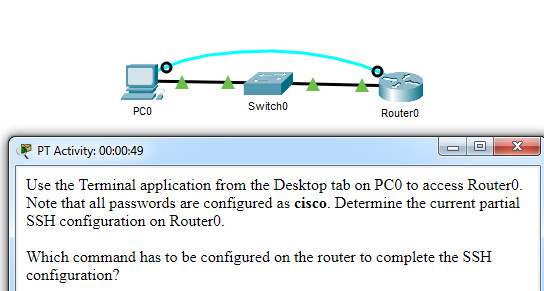
CCNA 1 v7 Modules 16 – 17 Building and Securing a Small Network Exam
Which command has to be configured on the router to complete the SSH configuration?
- service password-encryption
- transport input ssh
- enable secret class
- ip domain-name cisco.com
Explanation: The missing command to complete the SSH configuration is transport input ssh in line vty 0 4 mode.The commands service password-encryption and enable secret class do configure secure features on the router, but are not required to configure SSH. The command ip domain-name cisco.com is not required because the command ip domain-name span.com has been used.
424. An administrator decides to use “WhatAreyouwaiting4” as
the password on a newly installed router. Which statement applies to the
password choice?
- It is strong because it uses a passphrase.
- It is weak because it is often the default password on new devices.
- It is weak since it uses easily found personal information.
- It is weak since it is a word that is easily found in the dictionary.
425. An administrator decides to use “pR3s!d7n&0” as the
password on a newly installed router. Which statement applies to the
password choice?
- It is strong because it uses a minimum of 10 numbers, letters and special characters.
- It is weak because it is often the default password on new devices.
- It is weak since it uses easily found personal information.
- It is weak since it is a word that is easily found in the dictionary.
426. An administrator decides to use “5$7*4#033!” as the
password on a newly installed router. Which statement applies to the
password choice?
- It is strong because it contains 10 numbers and special characters.
- It is weak because it is often the default password on new devices.
- It is weak since it uses easily found personal information.
- It is strong because it uses a minimum of 10 numbers, letters and special characters.
427. An administrator decides to use “pR3s!d7n&0” as the
password on a newly installed router. Which statement applies to the
password choice?
- It is strong because it uses a minimum of 10 numbers, letters and special characters.
- It is weak since it is a word that is easily found in the dictionary.
- It is strong because it uses a passphrase.
- It is strong because it contains 10 numbers and special characters.
428. An administrator decides to use “12345678!” as the
password on a newly installed router. Which statement applies to the
password choice?
- It is weak because it uses a series of numbers or letters.
- It is strong because it uses a passphrase.
- It is weak since it is a word that is easily found in the dictionary.
- It is strong because it uses a minimum of 10 numbers, letters and special characters.
429. An administrator decides to use “admin” as the password
on a newly installed router. Which statement applies to the password
choice?
- It is weak because it is often the default password on new devices.
- It is strong because it uses a passphrase.
- It is strong because it uses a minimum of 10 numbers, letters and special characters.
- It is strong because it contains 10 numbers and special characters.
430. An administrator decides to use “Feb121978” as the
password on a newly installed router. Which statement applies to the
password choice?
- It is weak because it uses easily found personal information.
- It is strong because it uses a passphrase.
- It is weak since it is a word that is easily found in the dictionary.
- It is strong because it uses a minimum of 10 numbers, letters and special characters.
431. An administrator decides to use “password” as the
password on a newly installed router. Which statement applies to the
password choice?
- It is weak because it is a commonly used password.
- It is weak since it is a word that is easily found in the dictionary.
- It is strong because it uses a passphrase.
- It is strong because it uses a minimum of 10 numbers, letters and special characters.
432. An administrator decides to use “RobErT” as the password
on a newly installed router. Which statement applies to the password
choice?
- It is weak since it uses easily found personal information.
- It is strong because it uses a passphrase.
- It is strong because it uses a minimum of 10 numbers, letters and special characters.
- It is strong because it contains 10 numbers and special characters.
433. An administrator decides to use “Elizabeth” as the
password on a newly installed router. Which statement applies to the
password choice?
- It is weak because it uses easily found personal information.
- It is strong because it uses a passphrase.
- It is weak since it is a word that is easily found in the dictionary.
- It is strong because it uses a minimum of 10 numbers, letters and special characters.
Rules for strong passwords:
* minimum of 8 characters, preferably 10.
* use complex combinations of numbers, special characters, and upper and lower case letters.
* avoid repetition, common dictionary words, letter or number sequences.
* avoid names of children, relatives, pets, birthdays, or any easily identifiable personal information.
* can be created by misspelling words or replacing vowels with numbers or special characters.
434. A network technician is troubleshooting an issue and
needs to verify the IP addresses of all interfaces on a router. What is
the best command to use to accomplish the task?
- show ip interface brief
- nslookup
- ipconfig getifaddr en0
- show ip route
435. Students who are connected to the same switch are having
slower than normal response times. The administrator suspects a duplex
setting issue. What is the best command to use to accomplish the task?
- show interfaces
- ipconfig getifaddr en0
- copy running-config startup-config
- show ip nat translations
436. A user wants to know the IP address of the PC. What is the best command to use to accomplish the task?
- ipconfig
- copy running-config startup-config
- show interfaces
- show ip nat translations
437. A student wants to save a router configuration to NVRAM. What is the best command to use to accomplish the task?
- copy running-config startup-config
- show interfaces
- show ip nat translations
- show ip route
438. A support technician needs to know the IP address of the
wireless interface on a MAC. What is the best command to use to
accomplish the task?
- ipconfig getifaddr en0
- copy running-config startup-config
- show interfaces
- show ip nat translations
439. A network technician is troubleshooting an issue and
needs to verify all of the IPv6 interface addresses on a router. What is
the best command to use to accomplish the task?
- show ipv6 interface
- show interfaces
- show ip nat translations
- show ip route
440. A teacher is having difficulties connecting his PC to
the classroom network. He needs to verify that a default gateway is
configured correctly. What is the best command to use to accomplish the
task?
- ipconfig
- copy running-config startup-config
- show interfaces
- show ip nat translations
441. Only employees connected to IPv6 interfaces are having
difficulty connecting to remote networks. The analyst wants to verify
that IPv6 routing has been enabled. What is the best command to use to
accomplish the task?
- show running-config
- show interfaces
- copy running-config startup-config
- show ip nat translations
442. An administrator is troubleshooting connectivity issues
and needs to determine the IP address of a website. What is the best
command to use to accomplish the task?
- nslookup
- show ipv6 route
- show ipv6 interface
- copy startup-config running-config
443. Only employees connected to IPv6 interfaces are having
difficulty connecting to remote networks. The analyst wants to verify
that IPv6 routing has been enabled. What is the best command to use to
accomplish the task?
- show running-config
- show ipv6 route
- show ipv6 interface
- copy startup-config running-config
1. Which term refers to a network that provides secure access
to the corporate offices by suppliers, customers and collaborators?
- Internet
- intranet
- extranet*
- extendednet
Explain:
The term Internet refers to the worldwide collection of connected
networks. Intranet refers to a private connection of LANs and WANS that
belong to an organization and is designed to be accessible to the
members of the organization, employees, or others with authorization.
Extranets provide secure and safe access to suppliers, customers, and
collaborators. Extendednet is not a type of network.
2. A small business user is looking for an ISP connection
that provides high speed digital transmission over regular phone lines.
What ISP connection type should be used?
- DSL*
- dial-up
- satellite
- cell modem
- cable modem
3. Refer to the exhibit. An administrator is trying to
configure the switch but receives the error message that is displayed in
the exhibit. What is the problem?

- The entire command, configure terminal, must be used.
- The administrator is already in global configuration mode.
- The administrator must first enter privileged EXEC mode before issuing the command.*
- The administrator must connect via the console port to access global configuration mode.
Explain:
In order to enter global configuration mode, the command configure
terminal, or a shortened version such as config t, must be entered from
privileged EXEC mode. In this scenario the administrator is in user EXEC
mode, as indicated by the > symbol after the hostname. The
administrator would need to use the enable command to move into
privileged EXEC mode before entering the configure terminal command.
4. Which keys act as a hot key combination that is used to interrupt an IOS process?
- Ctrl-Shift-X
- Ctrl-Shift-6*
- Ctrl-Z
- Ctrl-C
Explain:
The Cisco IOS provides both hot keys and shortcuts for configuring
routers and switches. The Ctrl-Shift-6 hot key combination is used to
interrupt an IOS process, such as a ping or traceroute. Ctrl-Z is used
to exit the configuration mode. Ctrl-C aborts the current command.
Ctrl-Shift-X has no IOS function.
5. Refer to the exhibit. A network administrator is
configuring access control to switch SW1. If the administrator uses
Telnet to connect to the switch, which password is needed to access user
EXEC mode?
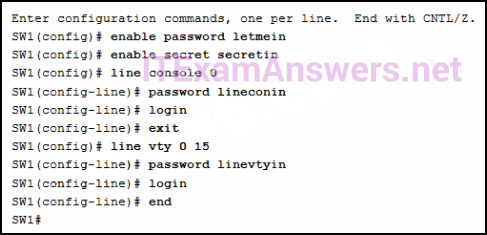
- letmein
- secretin
- lineconin
- linevtyin*
Explain:
Telnet accesses a network device through the virtual interface
configured with the line VTY command. The password configured under this
is required to access the user EXEC mode. The password configured under
the line console 0 command is required to gain entry through the
console port, and the enable and enable secret passwords are used to
allow entry into the privileged EXEC mode.
6. A network administrator enters the service
passwordencryption command into the configuration mode of a router.
What does this command accomplish?
- This command encrypts passwords as they are transmitted across serial WAN links.
- This command prevents someone from viewing the running configuration passwords.*
- This command enables a strong encryption algorithm for the enable secret password command.
- This command automatically encrypts passwords in configuration files that are currently stored in NVRAM.
- This command provides an exclusive encrypted password for external service personnel who are required to do router maintenance.
7. What is the purpose of the SVI on a Cisco switch?
- The SVI provides a physical interface for remote access to the switch.
- The SVI provides a faster method for switching traffic between ports on the switch.
- The SVI adds Layer 4 connectivity between VLANs.
- The SVI provides a virtual interface for remote access to the switch.*
Explain:
The SVI is a virtual, not physical, interface that provides remote
access to the switch. It does not impact Layer 4 nor does it enhance
switching between switch ports on the switch.
8. Which message delivery option is used when all devices need to receive the same message simultaneously?
- duplex
- unicast
- multicast
- broadcast*
Explain:
When all devices need to receive the same message simultaneously, the
message would be delivered as a broadcast. Unicast delivery occurs when
one source host sends a message to one destination host. The sending of
the same message from a host to a group of destination hosts is
multicast delivery. Duplex communications refers to the ability of the
medium to carry messages in both directions.
9. Which two protocols function at the internet layer? (Choose two.)
Explain:
ICMP and IP both function at the internet layer, whereas PPP is a
network access layer protocol, and POP and BOOTP are application layer
protocols.
10. What PDU is associated with the transport layer?
- segment*
- packet
- frame
- bits
Explain:
The PDU for the transport layer is called a segment. Packets, frames,
and bits are PDUs for the network, data link, and physical layers
respectively.
11. What is done to an IP packet before it is transmitted over the physical medium?
- It is tagged with information guaranteeing reliable delivery.
- It is segmented into smaller individual pieces.
- It is encapsulated into a TCP segment.
- It is encapsulated in a Layer 2 frame.*
Explain:
When messages are sent on a network, the encapsulation process works
from the top of the OSI or TCP/IP model to the bottom. At each layer of
the model, the upper layer information is encapsulated into the data
field of the next protocol. For example, before an IP packet can be
sent, it is encapsulated in a data link frame at Layer 2 so that it can
be sent over the physical medium.
12. What type of communication medium is used with a wireless LAN connection?
- fiber
- radio waves*
- microwave
- UTP
Explain:
A wired LAN connection commonly uses UTP. A wireless LAN connection uses radio waves.
13. In addition to the cable length, what two factors could
interfere with the communication carried over UTP cables? (Choose two.)
- crosstalk*
- bandwidth
- size of the network
- signal modulation technique
- electromagnetic interference *
Explain:
Copper media is widely used in network communications. However, copper
media is limited by distance and signal interference. Data is
transmitted on copper cables as electrical pulses. The electrical pulses
are susceptible to interference from two sources:
Electromagnetic interference (EMI) or radio frequency interference (RFI)
– EMI and RFI signals can distort and corrupt the data signals being
carried by copper media.
Crosstalk – Crosstalk is a disturbance caused by the electric or
magnetic fields of a signal on one wire interfering with the signal in
an adjacent wire.
14. What are the two sublayers of the OSI model data link layer? (Choose two.)
- internet
- physical
- LLC*
- transport
- MAC*
- network access
Explain:
The data link layer of the OSI model is divided into two sublayers: the
Media Access Control (MAC) sublayer and the Logical Link Control (LLC)
sublayer.
15. A technician has been asked to develop a physical
topology for a network that provides a high level of redundancy. Which
physical topology requires that every node is attached to every other
node on the network?
- bus
- hierarchical
- mesh*
- ring
- star
Explain:
The mesh topology provides high availability because every node is
connected to all other nodes. Mesh topologies can be found in WANs. A
partial mesh topology can also be used where some, but not all, end
points connect to one another.
16. What type of communication rule would best describe CSMA/CD?
- access method*
- flow control
- message encapsulation
- message encoding
Explain:
Carrier sense multiple access collision detection (CSMA/CD) is the
access method used with Ethernet. The access method rule of
communication dictates how a network device is able to place a signal on
the carrier. CSMA/CD dictates those rules on an Ethernet network and
CSMA/CA dictates those rules on an 802.11 wireless LAN.
17. If data is being sent over a wireless network, then
connects to an Ethernet network, and eventually connects to a DSL
connection, which header will be replaced each time the data travels
through a network infrastructure device?
- Layer 3
- data link*
- physical
- Layer 4
Explain:
Because each data link layer protocol controls how the device accesses
the media, the data link information must be removed and re-attached.
Even if a packet is going from one Ethernet network to another Ethernet
network, the data link layer information is replaced.
18. What best describes the destination IPv4 address that is used by multicasting?
- a single IP multicast address that is used by all destinations in a group*
- an IP address that is unique for each destination in the group
- a group address that shares the last 23 bits with the source IPv4 address
- a 48 bit address that is determined by the number of members in the multicast group
Explain:
The destination multicast IPv4 address is a group address, which is a single IP multicast address within the Class D range.
19. In an Ethernet network, when a device receives a frame of 1200 bytes, what will it do?
- drop the frame
- process the frame as it is*
- send an error message to the sending device
- add random data bytes to make the frame 1518 bytes long and then forward it
Explain:
Ethernet standards define the minimum frame as 64 bytes and a maximum of
1518 bytes. A frame less than 64 bytes is considered a “collision
fragment” or “runt frame” and is automatically discarded by receiving
devices. A frame greater than 1500 is considered a “baby giant”. A 1200
byte frame is within the normal range so it would be processed as is.
20. What important information is examined in the Ethernet frame header by a Layer 2 device in order to forward the data onward?
- source MAC address
- source IP address
- destination MAC address*
- Ethernet type
- destination IP address
Explain:
The Layer 2 device, such as a switch, uses the destination MAC address
to determine which path (interface or port) should be used to send the
data onward to the destination device.
21. What will a Layer 2 switch do when the destination MAC address of a received frame is not in the MAC table?
- It initiates an ARP request.
- It broadcasts the frame out of all ports on the switch.
- It notifies the sending host that the frame cannot be delivered.
- It forwards the frame out of all ports except for the port at which the frame was received.*
Explain:
A Layer 2 switch determines how to handle incoming frames by using its
MAC address table. When an incoming frame contains a destination MAC
address that is not in the table, the switch forwards the frame out all
ports, except for the port on which it was received.
22. What are two features of ARP? (Choose two.)
- If a host is ready to send a
packet to a local destination device and it has the IP address but not
the MAC address of the destination, it generates an ARP broadcast.*
- An ARP request is sent to all devices on the Ethernet LAN and
contains the IP address of the destination host and its multicast MAC
address.
- When a host is encapsulating a packet into a frame, it refers to the
MAC address table to determine the mapping of IP addresses to MAC
addresses.
- If no device responds to the ARP request, then the originating node
will broadcast the data packet to all devices on the network segment.
- If a device receiving an ARP request has the destination IPv4 address, it responds with an ARP reply.*
Explain:
When a node encapsulates a data packet into a frame, it needs the
destination MAC address. First it determines if the destination device
is on the local network or on a remote network. Then it checks the ARP
table (not the MAC table) to see if a pair of IP address and MAC address
exists for either the destination IP address (if the destination host
is on the local network) or the default gateway IP address (if the
destination host is on a remote network). If the match does not exist,
it generates an ARP broadcast to seek the IP address to MAC address
resolution. Because the destination MAC address is unknown, the ARP
request is broadcast with the MAC address FFFF.FFFF.FFFF. Either the
destination device or the default gateway will respond with its MAC
address, which enables the sending node to assemble the frame. If no
device responds to the ARP request, then the originating node will
discard the packet because a frame cannot be created.
23. Which two services are required to enable a computer to
receive dynamic IP addresses and access the Internet using domain names?
(Choose two.)
- DNS*
- WINS
- HTTP
- DHCP*
- SMTP
24. What is a basic characteristic of the IP protocol?
- connectionless*
- media dependent
- user data segmentation
- reliable end-to-end delivery
Explain:
Internet Protocol (IP) is a network layer protocol that does not require
initial exchange of control information to establish an end-to-end
connection before packets are forwarded. Thus, IP is connectionless and
does not provide reliable end-to-end delivery by itself. IP is media
independent. User data segmentation is a service provided at the
transport layer.
25. Refer to the exhibit. A user issues the command netstat
–r on a workstation. Which IPv6 address is one of the link-local
addresses of the workstation?
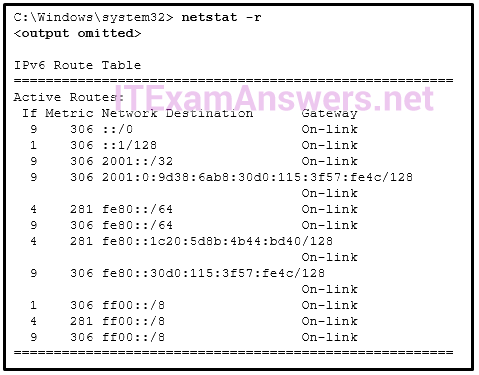
- ::1/128
- fe80::30d0:115:3f57:fe4c/128*
- fe80::/64
- 2001:0:9d38:6ab8:30d0:115:3f57:fe4c/128
Explain:
In the IPv6 address scheme, the network of fe80::/10 is reserved for
link-local addresses. The address fe80::/64 is a network address that
indicates, in this workstation, fe80::/64 is actually used for
link-local addresses. Thus the address fe80::30d0:115:3f57:fe4c/128 is a
valid IPv6 link-local address.
26. What is the valid most compressed format possible of the IPv6 address 2001:0DB8:0000:AB00:0000:0000:0000:1234?
- 2001:DB8:0:AB00::1234*
- 2001:DB8:0:AB::1234
- 2001:DB8::AB00::1234
- 2001:DB8:0:AB:0:1234
Explain:
There are two rules defining how an IPv6 address can be compressed. The
first rule states that leading zeros in a hextet can be eliminated. The
second rule states that a single :: can be used to represent one or more
contiguous all zero hextets. There can be one and only one :: in an
IPv6 address.
27. At a minimum, which address is required on IPv6-enabled interfaces?
- link-local*
- unique local
- site local
- global unicast
Explain:
All IPv6 enabled interfaces must at minimum have a link-local address.
Other IPv6 addresses can be assigned to the interface as required.
28. An IPv6 enabled device sends a data packet with the destination address of FF02::2. What is the target of this packet?
- all IPv6 enabled devices across the network
- all IPv6 enabled devices on the local link
- all IPv6 DHCP servers
- all IPv6 configured routers on the local link*
Explain:
FF02::2 identifies all IPv6 routers that exist on the link or network.
FF02::1 is the target for all IPv6 enabled devices on the link or
network.
29. What is the purpose of ICMP messages?
- to inform routers about network topology changes
- to ensure the delivery of an IP packet
- to provide feedback of IP packet transmissions*
- to monitor the process of a domain name to IP address resolution
Explain:
The purpose of ICMP messages is to provide feedback about issues that are related to the processing of IP packets.
30. Which statement describes a characteristic of the traceroute utility?
- It sends four Echo Request messages.
- It utilizes the ICMP Source Quench messages.
- It is primarily used to test connectivity between two hosts.
- It identifies the routers in the path from a source host to a destination host.*
Explain:
Traceroute is a utility that generates a list of hops (or routers) along the path from a source host to the destination host.
31. What is the usable number of host IP addresses on a network that has a /26 mask?
Explain:
A /26 mask is the same as 255.255.255.192. The mask leaves 6 host bits.
With 6 host bits, 64 IP addresses are possible. One address represents
the subnet number and one address represents the broadcast address,
which means that 62 addresses can then be used to assign to network
devices.
32. Refer to the exhibit. An administrator must send a
message to everyone on the router A network. What is the broadcast
address for network 172.16.16.0/22?
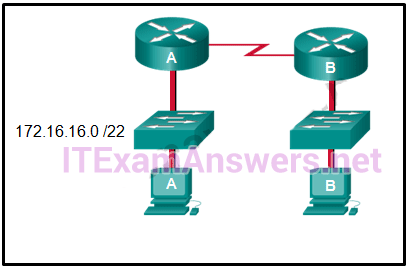
- 172.16.16.255
- 172.16.20.255
- 172.16.19.255*
- 172.16.23.255
- 172.16.255.255
Explain:
The 172.16.16.0/22 network has 22 bits in the network portion and 10
bits in the host portion. Converting the network address to binary
yields a subnet mask of 255.255.252.0. The range of addresses in this
network will end with the last address available before 172.16.20.0.
Valid host addresses for this network range from
172.16.16.1-172.16.19.254, making 172.16.19.255 the broadcast address.
33. Given IPv6 address prefix 2001:db8::/48, what will be the
last subnet that is created if the subnet prefix is changed to /52?
- 2001:db8:0:f00::/52
- 2001:db8:0:8000::/52
- 2001:db8:0:f::/52
- 2001:db8:0:f000::/52*
Explain:
Prefix 2001:db8::/48 has 48 network bits. If we subnet to a /52, we are
moving the network boundary four bits to the right and creating 16
subnets. The first subnet is 2001:db8::/52 the last subnet is
2001:db8:0:f000::/52.
34. A technician with a PC is using multiple applications
while connected to the Internet. How is the PC able to keep track of the
data flow between multiple application sessions and have each
application receive the correct packet flows?
- The data flow is being tracked based on the destination port number utilized by each application.
- The data flow is being tracked based on the source port number utilized by each application.*
- The data flow is being tracked based on the source IP address used by the PC of the technician.
- The data flow is being tracked based on the destination IP address used by the PC of the technician.
Explain:
The source port number of an application is randomly generated and used
to individually keep track of each session connecting out to the
Internet. Each application will use a unique source port number to
provide simultaneous communication from multiple applications through
the Internet.
35. What three services are provided by the transport layer? (Choose three.)
- flow control*
- encryption of data
- path determination
- connection establishment *
- error recovery*
- bit transmission
- data representation
Explain:
The transport layer is responsible for tracking digital conversations
between a source application and a destination application through the
use of port numbers. Two protocols that operate at the transport layer
are TCP and UDP. TCP can provide reliability by establishing a
connection, maintaining flow control, and error recovery.
36. An Internet television transmission is using UDP. What
happens when part of the transmission is not delivered to the
destination?
- A delivery failure message is sent to the source host.
- The part of the television transmission that was lost is re-sent.
- The entire transmission is re-sent.
- The transmission continues without the missing portion.*
Explain:
Most streaming services, such as Internet television, use UDP as the
transport layer protocol. These transmissions can tolerate some
transmission failures, and no failure messages or retransmissions are
required. Such control measures would create noticeable disruption to
the flow of data.
37. Which two OSI model layers are considered to be included in the top layer of the TCP/IP protocol stack? (Choose two.)
- internet
- network
- presentation*
- session*
- transport
Explain:
The top three OSI model layers are included in the top layer of the
TCP/IP protocol stack. These top three OSI model layers include the
application, presentation, and session layers
38. An author is uploading one chapter document from a
personal computer to a file server of a book publisher. What role is the
personal computer assuming in this network model?
- client*
- master
- server
- slave
- transient
Explain:
In the client/server network model, a network device assumes the role of
server in order to provide a particular service such as file transfer
and storage. The device requesting the service assumes the role of
client. In the client/server network model, a dedicated server does not
have to be used, but if one is present, the network model being used is
the client/server model. In contrast, the peer-to-peer network model
does not have a dedicated server.
39. Which two automatic addressing assignments are supported by DHCPv4? (Choose two.)
- local server address
- subnet mask*
- default gateway address*
- physical address of the recipient
- physical address of the sender
40. When a network administrator is trying to manage network
traffic on a growing network, when should traffic flow patterns be
analyzed?
- during times of peak utilization*
- during off-peak hours
- during employee holidays and weekends
- during randomly selected times
Explain:
Planning for network growth requires knowledge of the types of traffic
traveling on the network. Network administrators can use a protocol
analyzer to identify the traffic on the network. To get the best
representation of the different types of traffic, the network should be
analyzed during peak utilization.
41. What is the objective of a network reconnaissance attack?
- discovery and mapping of systems*
- unauthorized manipulation of data
- disabling network systems or services
- denying access to resources by legitimate users
Explain:
The objective of a network reconnaissance attack is to discover
information about a network, network systems, and network services.
42. A network administrator enters the service
password-encryption command into the configuration mode of a router.
What does this command accomplish?
- This command encrypts passwords as they are transmitted across serial WAN links.
- This command automatically encrypts passwords in configuration files that are currently stored in NVRAM.
- This command provides an exclusive encrypted password for external service personnel who are required to do router maintenance.
- This command enables a strong encryption algorithm for the enable secret password command.
- This command prevents someone from viewing the running configuration passwords.*
43. What will be the result of failed login attempts if the following command is entered into a router?
- login block-for 150 attempts 4 within 90
- All login attempts will be blocked for 150 seconds if there are 4 failed attempts within 90 seconds.*
- All login attempts will be blocked for 90 seconds if there are 4 failed attempts within 150 seconds.
- All login attempts will be blocked for 1.5 hours if there are 4 failed attempts within 150 seconds.
- All login attempts will be blocked for 4 hours if there are 90 failed attempts within 150 seconds.
Explain:
The components of the login block-for 150 attempts 4 within 90 command are as follows:
The expression block-for 150 is the time in seconds that logins will be blocked.
The expression attempts 4 is the number of failed attempts that will trigger the blocking of login requests.
The expression within 90 is the time in seconds in which the 4 failed attempts must occur.
44. Which two statements correctly describe a router memory type and its contents? (Choose two.)
- ROM is nonvolatile and stores the running IOS.
- FLASH is nonvolatile and contains a limited portion of the IOS.
- RAM is volatile and stores the IP routing table.*
- NVRAM is nonvolatile and stores a full version of the IOS.
- ROM is nonvolatile and contains basic diagnostic software.*
Explain:
ROM is a nonvolatile memory and stores bootup instructions, basic
diagnostic software, and a limited IOS. Flash is a nonvolatile memory
used as permanent storage for the IOS and other system-related files.
RAM is volatile memory and stores the IP routing table, IPv4 to MAC
address mappings in the ARP cache, packets that are buffered or
temporarily stored, the running configuration, and the currently running
IOS. NVRAM is a nonvolatile memory that stores the startup
configuration file.
45. A user reports a lack of network connectivity. The
technician takes control of the user machine and attempts to ping other
computers on the network and these pings fail. The technician pings the
default gateway and that also fails. What can be determined for sure by
the results of these tests?
- The NIC in the PC is bad.
- The TCP/IP protocol is not enabled.
- The router that is attached to the same network as the workstation is down.
- Nothing can be determined for sure at this point.*
Explain:
In networks today, a failed ping could mean that the other devices on
the network are blocking pings. Further investigation such as checking
network connectivity from other devices on the same network is
warranted.
46. For Cisco IOS, which escape sequence allows terminating a traceroute operation?
- Ctrl+Shift+6*
- Ctrl+Esc
- Ctrl+x
- Ctrl+c
Explain:
Once a traceroute is initiated in the Cisco IOS, it can be stopped by issuing the Ctrl+Shift+6 escape sequence.
47. Match the phases to the functions during the boot up process of a Cisco router. (Not all options are used.)

 Place the options in the following order.
— not scored —
locale and load the Cisco IOS software -> phase 2
locate and load the startup configuration file -> phase 3
perform the POST and load the bootstrap program -> phase 1
Place the options in the following order.
— not scored —
locale and load the Cisco IOS software -> phase 2
locate and load the startup configuration file -> phase 3
perform the POST and load the bootstrap program -> phase 1
Explain:
There are three major phases to the bootup process of a Cisco router:
Perform the POST and load the bootstrap program.
Locate and load the Cisco IOS software.
Locate and load the startup configuration file
If a startup configuration file cannot be located, the router will enter setup mode by displaying the setup mode prompt.
48. What three blocks of addresses are defined by RFC 1918 for private network use? (Choose three.)
- 10.0.0.0/8*172.16.0.0/12*
- 192.168.0.0/16*
- 100.64.0.0/14
- 169.254.0.0/16
- 239.0.0.0/8
Explain:RFC 1918, Address Allocation for Private
Internets, defines three blocks of IPv4 address for private networks
that should not be routable on the public Internet.
10.0.0.0/8
172.16.0.0/12
192.168.0.0/16
49. A network administrator is variably subnetting a given
block of IPv4 addresses. Which combination of network addresses and
prefix lengths will make the most efficient use of addresses when the
need is for 2 subnets capable of supporting 10 hosts and 1 subnet that
can support 6 hosts?
- 10.1.1.128/28
10.1.1.144/28
10.1.1.160/29*
- 10.1.1.128/28
10.1.1.144/28
10.1.1.160/2810.1.1.128/28
10.1.1.140/28
10.1.1.158/26
- 10.1.1.128/26
10.1.1.144/26
10.1.1.160/26
- 10.1.1.128/26
10.1.1.140/26
10.1.1.158/28
Explain:
Prefix lengths of /28 and /29 are the most efficient to create subnets
of 16 addresses (to support 10 hosts) and 8 addresses (to support 6
hosts), respectively. Addresses in one subnet must also not overlap into
the range of another subnet.
50. Match the descriptions to the terms. (Not all options are used.)
Question
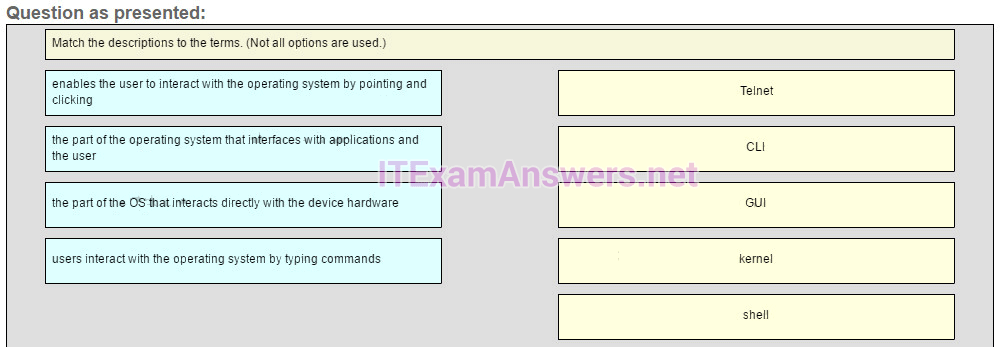 Answer
Answer
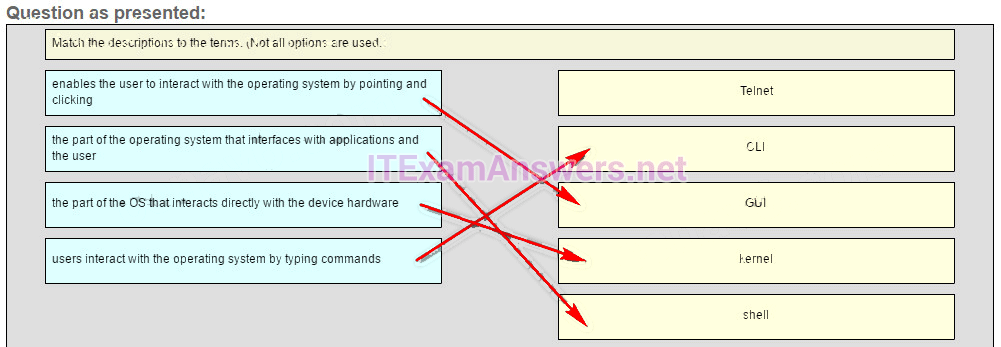 Place the options in the following order.
— not scored —
CLI -> users interact with the operating system by typing commands
GUI -> enables the user to interact with the operating system by pointing and clicking
kernel -> the part of the OS that interacts directly with the device hardware
shell -> the part of the operating system that interfaces with applications and the user
Place the options in the following order.
— not scored —
CLI -> users interact with the operating system by typing commands
GUI -> enables the user to interact with the operating system by pointing and clicking
kernel -> the part of the OS that interacts directly with the device hardware
shell -> the part of the operating system that interfaces with applications and the user
Explain:
A GUI, or graphical user interface, allows the user to interact with the
operating system by pointing and clicking at elements on the screen. A
CLI, or command-line interface, requires users to type commands at a
prompt in order to interact with the OS. The shell is the part of the
operating system that is closest to the user. The kernel is the part of
the operating system that interfaces with the hardware.
51. Match the requirements of a reliable network with the supporting network architecture. (Not all options are used.)
Question
 Answer
Answer
 Place the options in the following order.
Protect the network from unauthorized access. -> security
Provide redundant links and devices. -> fault tolerance
— not scored —
Expand the network without degrading the service for existing users. -> scalability
— not scored —
52. Match the functions with the corresponding OSI layer. (Not all options are used.)
Question
Place the options in the following order.
Protect the network from unauthorized access. -> security
Provide redundant links and devices. -> fault tolerance
— not scored —
Expand the network without degrading the service for existing users. -> scalability
— not scored —
52. Match the functions with the corresponding OSI layer. (Not all options are used.)
Question
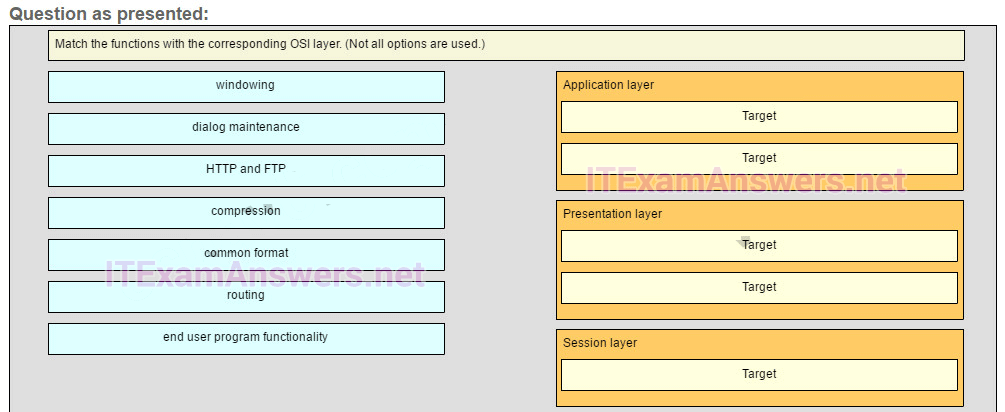 Answer
Answer
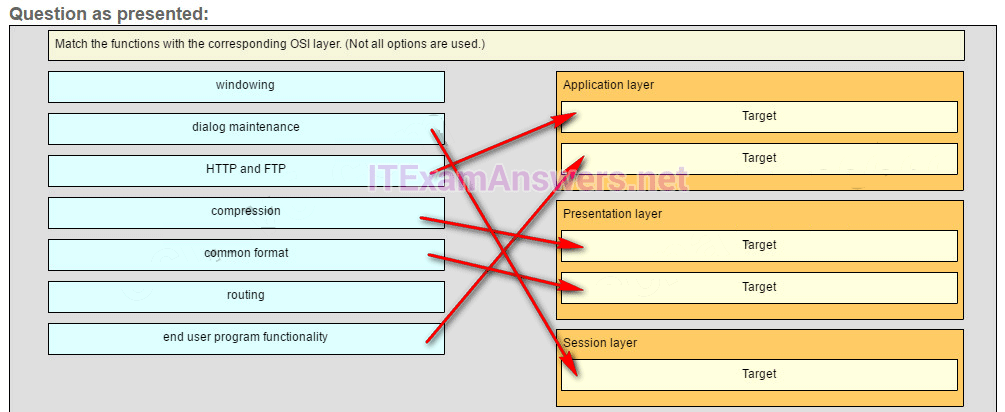 Place the options in the following order.
Application layer
HTTP and FTP
end user program functionality
Presentation layer
compression
common format
Session layer
dialog maintenance
53. What subnet mask is required to support 512 subnets on networks 172.28.0.0/16?
Place the options in the following order.
Application layer
HTTP and FTP
end user program functionality
Presentation layer
compression
common format
Session layer
dialog maintenance
53. What subnet mask is required to support 512 subnets on networks 172.28.0.0/16?
- 255.255.240.0
- 255.255.255.224
- 255.255.255.240
- 255.255.255.128*
- 255.255.252.0
54. A DHCP server is used to IP addresses dynamically to the
hosts on a network. The address pool is configured with 10.29.244.0/25.
There are 19 printers on this network that need to use reserve static IP
addresses from the pool. How many IP address in the pool are left to be
assign to other hosts?
Older Version
55. What is an advantage of storing configuration files to a USB flash drive instead of to a TFTP server?
- The files can be saved without using terminal emulation software.
- The transfer of the files does not rely on network connectivity.*
- The USB flash drive is more secure.
- The configuration files can be stored to a flash drive that uses any file system format.
56. Refer to the exhibit. An administrator is trying to view
the current configuration on this switch but receives the error message
that is displayed. What does this error indicate?

- The command does not exist.
- One or more required keywords or arguments were omitted.
- Not enough characters were entered for the interpreter to recognize the command.*
- The administrator does not have the required level of access to use this command.
57. A host is accessing a Web server on a remote network.
Which three functions are performed by intermediary network devices
during this conversation? (Choose three.)
- regenerating data signals*
- acting as a client or a server
- providing a channel over which messages travel
- applying security settings to control the flow of data *
- notifying other devices when errors occur*
- serving as the source or destination of the messages
58. For which three reasons was a packet-switched
connectionless data communications technology used when developing the
Internet? (Choose three.)
- It can rapidly adapt to the loss of data transmission facilities. *
- It efficiently utilizes the network infrastructure to transfer data. *
- Data packets can travel multiple paths through the network simultaneously.*
- It allows for billing of network use by the amount of time a connection is established.
- It requires that a data circuit between the source and destination be established before data can be transferred.
59. A medium-sized business is researching available options
for connecting to the Internet. The company is looking for a high speed
option with dedicated, symmetric access. Which connection type should
the company choose?
- DSL
- dialup
- satellite
- leased line*
- cable modem
60. What is an ISP?
- It is a standards body that develops cabling and wiring standards for networking.
- It is a protocol that establishes how computers within a local network communicate.
- It is an organization that enables individuals and businesses to connect to the Internet.*
- It is a networking device that combines the functionality of several different networking devices in one.
61. Refer to the exhibit. A network engineer is attempting to
connect to a new router to perform the initial configuration. The
engineer connects a rollover cable from the serial port of a PC to the
Aux port on the router, then configures HyperTerminal as shown. The
engineer cannot get a login prompt in HyperTerminal. What would fix the
problem?

CCNA 1 Practice Final Answer 001 (v5.02, 2015)
- Connect to the Ethernet port on the PC.
- Change connection settings to even parity.
- Move the cable to the router console port.*
- Use a crossover cable instead of a rollover cable.
62. Which connection provides a secure CLI session with encryption to a Cisco router?
- a console connection
- an AUX connection
- a Telnet connection
- an SSH connection*
63. Refer to the exhibit. From global configuration mode, an
administrator is attempting to create a message-of-the-day banner by
using the command banner motd V Authorized access only! Violators will
be prosecuted! V When users log in using Telnet, the banner does not
appear correctly. What is the problem?
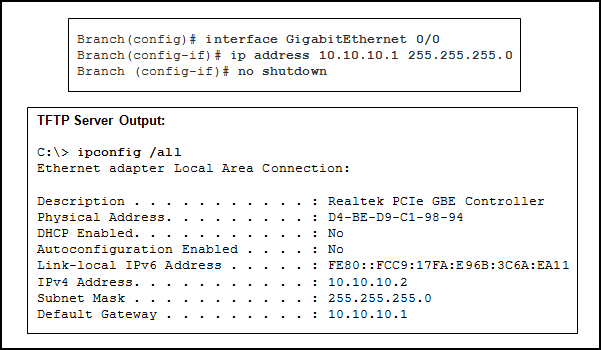
CCNA 1 Practice Final Answer 003 (v5.02, 2015)
- The banner message is too long.
- The delimiting character appears in the banner message.*
- The symbol “!” signals the end of a banner message.
- Message-of-the-day banners will only appear when a user logs in through the console port.
64. What will happen if the default gateway address is incorrectly configured on a host?
- The host cannot communicate with other hosts in the local network.
- The switch will not forward packets initiated by the host.
- The host will have to use ARP to determine the correct address of the default gateway.
- The host cannot communicate with hosts in other networks.*
- A ping from the host to 127.0.0.1 would not be successful.
65. A network administrator is designing a new network
infrastructure that includes both wired and wireless connectivity. Under
which situation would a wireless connection be recommended?
- The end-user device only has an Ethernet NIC.
- The end-user device requires a dedicated connection because of performance requirements.
- The end-user device needs mobility when connecting to the network.*
- The end-user device area has a high concentration of RFI.
66. A network administrator is troubleshooting connectivity
issues on a server. Using a tester, the administrator notices that the
signals generated by the server NIC are distorted and not usable. In
which layer of the OSI model is the error categorized?
- presentation layer
- network layer
- physical layer*
- data link layer
67. Refer to the exhibit. Which layer of the OSI model would format data in this way?

CCNA 1 Practice Final Answer 005 (v5.02, 2015)
- physical
- network
- data link*
- transport
- application
68. On a point-to-point network, which communication type is
used when two devices can both transmit and receive but not at the same
time?
- controlled access
- deterministic
- full-duplex
- half-duplex*
69. A frame is transmitted from one networking device to
another. Why does the receiving device check the FCS field in the frame?
- to determine the physical address of the sending device
- to verify the network layer protocol information
- to compare the interface media type between the sending and receiving ends
- to check the frame for possible transmission errors*
- to verify that the frame destination matches the MAC address of the receiving device
70. The ARP table in a switch maps which two types of address together?
- Layer 3 address to a Layer 2 address*
- Layer 3 address to a Layer 4 address
- Layer 4 address to a Layer 2 address
- Layer 2 address to a Layer 4 address
71. What are two actions performed by a Cisco switch? (Choose two.)
- building a routing table that is based on the first IP address in the frame header
- using the source MAC addresses of frames to build and maintain a MAC address table*
- forwarding frames with unknown destination IP addresses to the default gateway
- utilizing the MAC address table to forward frames via the destination MAC address*
- examining the destination MAC address to add new entries to the MAC address table
72. Which two functions are primary functions of a router? (Choose two.)
- packet switching*
- microsegmentation
- domain name resolution
- path selection*
- flow control
73. A router boots and enters setup mode. What is the reason for this?
- The IOS image is corrupt.
- Cisco IOS is missing from flash memory.
- The configuration file is missing from NVRAM.*
- The POST process has detected hardware failure.
74. Using default settings, what is the next step in the router boot sequence after the IOS loads from flash?
- Perform the POST routine.
- Search for a backup IOS in ROM.
- Load the bootstrap program from ROM.
- Load the running-config file from RAM.
- Locate and load the startup-config file from NVRAM.*
75. What are two ways that TCP uses the sequence numbers in a segment? (Choose two.)
- to identify missing segments at the destination*
- to reassemble the segments at the remote location*
- to specify the order in which the segments travel from source to destination
- to limit the number of segments that can be sent out of an interface at one time
- to determine if the packet changed during transit
76. A high school in New York (school A) is using
videoconferencing technology to establish student interactions with
another high school (school B) in Russia. The videoconferencing is
conducted between two end devices through the Internet. The network
administrator of school A configures the end device with the IP address
192.168.25.10. The administrator sends a request for the IP address for
the end device in school B and the response is 192.168.25.10. The
administrator knows immediately that this IP will not work. Why?
- This is a loopback address.
- This is a link-local address.
- This is a private IP address.*
- There is an IP address conflict.
77. Which service will translate private internal IP addresses into Internet routable public IP addresses?
78. Which IPv6 address notation is valid?
- 2001:0DB8::ABCD::1234
- ABCD:160D::4GAB:FFAB
- 2001:DB8:0:1111::200*
- 2001::ABCD::
79. Which range of link-local addresses can be assigned to an IPv6-enabled interface??
- FEC0::/10?
- FDEE::/7?
- FEBF::/10*
- FF00::/8?
80. What are the three parts of an IPv6 global unicast address? (Choose three.)
- broadcast address
- global routing prefix*
- subnet mask
- subnet ID *
- interface ID*
81. A network administrator has been issued a network address
of 192.31.7.64/26. How many subnets of equal size could be created from
the assigned /26 network by using a /28 prefix?
82. A small satellite office has been given the overall
network number of 192.168.99.0/24 and the network technician can
subdivide the network addresses as needed. The office needs network
access for both wired and wireless devices. However, because of the
security consideration, these two networks should be separate. The wired
network will have 20 devices. The wireless network has a potential
connection of 45 devices. Which addressing scheme would be most
efficient for these two networks?
- 192.168.99.0/26
192.168.99.64/27*
- 192.168.99.0/27
192.168.99.32/26
- 192.168.99.0/27
192.168.99.32/28
- 192.168.99.0/28
192.168.99.16/28
- 192.168.99.0/28
192.168.99.64/26
83. The administrator of a branch office receives an IPv6
prefix of 2001:db8:3000::/52 from the corporate network manager. How
many subnets can the administrator create?
- 1024
- 2048
- 4096*
- 8192
- 65536
84. A user is attempting to do an http://www.cisco.com/
without success. Which two configuration values must be set on the host
to allow this access? (Choose two.)
- DNS server*
- WINS server
- HTTP server
- default gateway*
- Netbios
85. Which devices should be secured to mitigate against MAC address spoofing attacks?
- Layer 7 devices
- Layer 4 devices
- Layer 2 devices*
- Layer 3 devices
86. Which router configuration mode would an administrator use to configure the router for SSH or Telnet login access?
- line*
- router
- global
- interface
- privileged EXEC
87. Refer to the exhibit. An administrator is testing
connectivity to a remote device with the IP address 10.1.1.1. What does
the output of this command indicate?
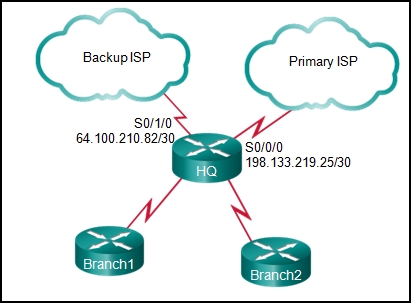
CCNA 1 Practice Final Answer 007 (v5.02, 2015)
- Connectivity to the remote device was successful.
- A router along the path did not have a route to the destination.*
- A ping packet is being blocked by a security device along the path.
- The connection timed out while waiting for a reply from the remote device.
88. Which is a function of the show ip route command when used as a tool for troubleshooting network connectivity?
- indicates the point of failure in the connection
- shows the IP address of the next hop router for each route*
- lists the IP addresses of all hops the traffic will pass through to reach the destination network
- shows the incoming and outgoing interfaces the traffic will go through in order to reach the destination network
89. A user calls the help desk to report that a Windows XP
workstation is unable to connect to the network after startup and that a
popup window says “This connection has limited or no connectivity.” The
technician asks the user to issue the ipconfig /all command. The user
reports the IP address is 169.254.69.196 with subnet mask of 255.255.0.0
and nothing is displayed for the DNS server IP address. What is the
cause of the problem?
- The workstation NIC has malfunctioned.
- The subnet mask was configured incorrectly.
- The DNS server IP address needs to be configured.
- The workstation is unable to obtain an IP address from a DHCP server.*
90. A particular email site does not appear to be responding
on a Windows 7 computer. What command could the technician use to show
any cached DNS entries for this web page?
- ipconfig /all
- arp -a
- ipconfig /displaydns*
- nslookup
91. To revert to a previous configuration, an administrator
issues the command copy tftp startup-config on a router and enters the
host address and file name when prompted. After the command is
completed, why does the current configuration remain unchanged?
- The command should have been copy startup-config tftp.
- The configuration should have been copied to the running configuration instead.*
- The configuration changes were copied into RAM and require a reboot to take effect.
- A TFTP server can only be used to restore the Cisco IOS, not the router configuration.
92. Refer to the graphic. What is the effect of setting the security mode to WEP on the Linksys integrated router?
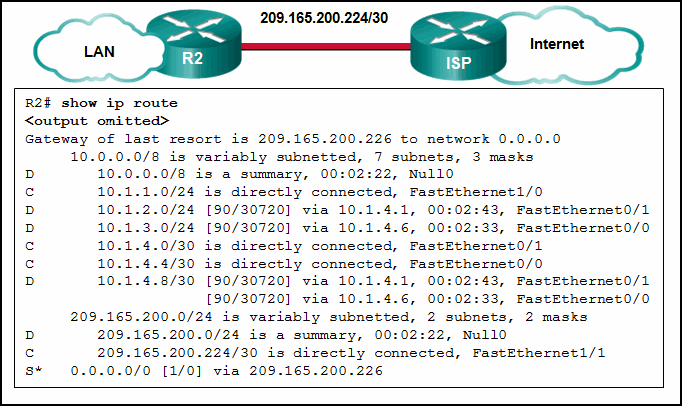
CCNA 1 Practice Final Answer 008 (v5.02, 2015)
- It identifies the wireless LAN.
- It allows the access point to inform clients of its presence.
- It translates IP addresses into easy-to-remember domain names.
- It encrypts data between the wireless client and the access point.*
- It translates an internal address or group of addresses into an outside, public address.
93. Which type of wireless security is easily compromised?
94. Refer to the exhibit. Which two settings could be changed to improve security on the wireless network? (Choose two.)

CCNA 1 Practice Final Answer 009 (v5.02, 2015)
- network mode
- SSID*
- radio band
- wide channel
- standard channel
- SSID broadcast*
95. Fill in the blank. Do not abbreviate. Use lower case.
Which interface configuration mode command puts a Layer 3 switch interface into Layer 3 mode?
no switchport
96. Fill in the blank.
A nibble consists of
4 bits.
97. Match each item to the type of topology diagram on which it is typically identified. (Not all options are used.)
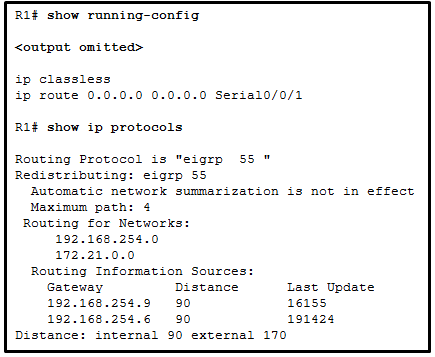 98. Match the situation with the appropriate use of network media.
98. Match the situation with the appropriate use of network media.
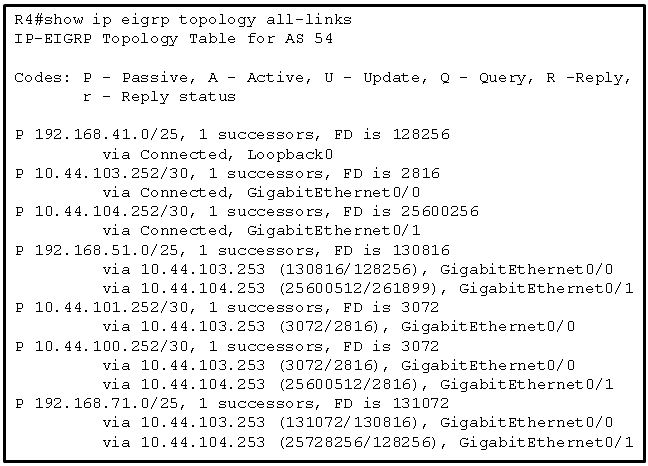 99. Match the subnetwork to a host address that would be included within the subnetwork. (Not all options are used.)
99. Match the subnetwork to a host address that would be included within the subnetwork. (Not all options are used.)
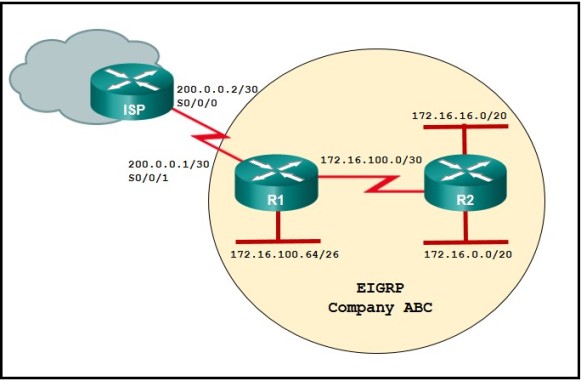 100. Open the PT activity. Perform the tasks in the activity instructions and then fill in the blank.
100. Open the PT activity. Perform the tasks in the activity instructions and then fill in the blank.
The Server0 message is
winner.?
101. Which two statements are correct in a comparison of IPv4 and IPv6 packet headers? (Choose two.)
- The Source Address field name from IPv4 is kept in IPv6.*
- The Version field from IPv4 is not kept in IPv6.
- The Destination Address field is new in IPv6.
- The Header Checksum field name from IPv4 is kept in IPv6.
- The Time-to-Live field from IPv4 has been replaced by the Hop Limit field in IPv6.*
102. Why are port numbers included in the TCP header of a segment?
- to allow the receiving host to assemble the packet in the proper order
- to enable a receiving host to forward the data to the appropriate application*
- to determine which Layer 3 protocol should be used to encapsulate the data
- to identify which switch ports should receive or forward the segment
- to indicate the correct router interface that should be used to forward a segment
103. Open the PT Activity. Perform the tasks in the activity instructions and then answer the question.
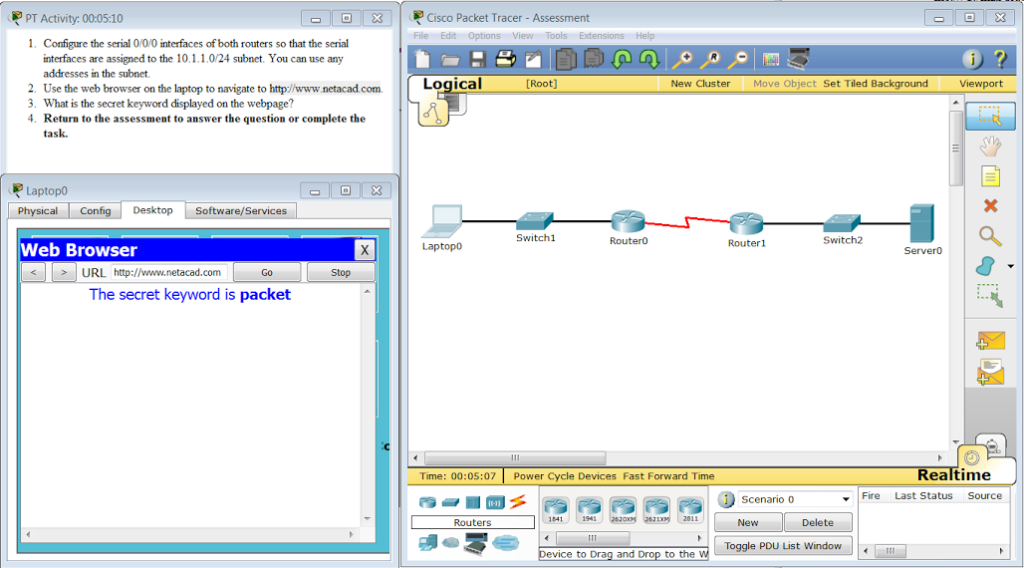 What is the secret keyword that is displayed on the web page?
What is the secret keyword that is displayed on the web page?
- cisco
- switch
- frame
- packet*
- router
104. Which two types of applications rely on their traffic
having priority over other traffic types through the network? (Choose
two.)
- email
- voice*
- file transfer
- instant messaging
- video*
105. Fill in the blank.
In dotted decimal notation, the IP address “
172.25.0.126” is the last host address for the network 172.25.0.64/26.
106. What are two characteristics of a scalable network? (Choose two.)
- is not as reliable as a small network
- grows in size without impacting existing users*
- easily overloaded with increased traffic
- suitable for modular devices that allow for expansion*
- offers limited number of applications
107. Question as presented:

Subnet 192.168.1.32/27 will have a valid host range from 192.168.1.33 – 192.168.1.62 with the broadcast address as 192.168.1.63
Subnet 192.168.1.64/27 will have a valid host range from 192.168.1.65 – 192.168.1.94 with the broadcast address as 192.168.1.95
Subnet 192.168.1.96/27 will have a
valid host range from 192.168.1.97 – 192.168.1.126 with the broadcast
address as 192.168.1.127
108. What information is added during encapsulation at OSI Layer 3?
- source and destination port number
- source and destination MAC
- source and destination IP address*
- source and destination application protocol
109. Refer to the exhibit. HostA is attempting to contact
ServerB. Which two statements correctly describe the addressing that
HostA will generate in the process? (Choose two.)
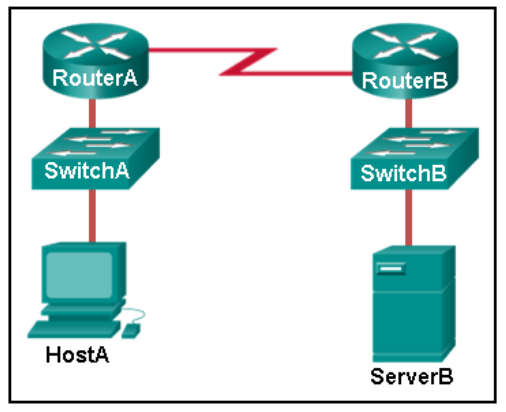
- A packet with the destination IP address of RouterA.
- A frame with the destination MAC address of SwitchA.
- A frame with the destination MAC address of RouterA.*
- A packet with the destination IP address of RouterB.
- A packet with the destination IP address of ServerB.*
- A frame with the destination MAC address of ServerB.
110. What will a host on an Ethernet network do if it
receives a frame with a destination MAC address that does not match its
own MAC address?
- It will remove the frame from the media.
- It will discard the frame.*
- It will forward the frame to the next host.
- It will strip off the data-link frame to check the destination IP address.
111. A PC that is communicating with a web server is
utilizing a window size of 6,000 bytes when sending data and a packet
size of 1,500 bytes. What byte of information will the web server
acknowledge after it has received four packets of data from the PC?
- 1,500
- 5
- 6,001*
- 1,501
- 6,000
112. What three primary functions does data link layer encapsulation provide? (Choose three.)
- error detection*
- port identification
- addressing*
- path determination
- IP address resolution
- frame delimiting*
113. Fill in the blank using a number.
The minimum Ethernet frame size is “
64” bytes. Anything smaller than that should be considered a “runt frame.”
114. What three statements describe features or functions of media access control? (Choose three.)
- Ethernet utilizes CSMA/CD.*
- 802.11 utilizes CSMA/CD.
- It uses contention-based access also known as deterministic access.
- Data link layer protocols define the rules for access to different media.*
- Controlled media access involves collision handling.
- It is responsible for detecting transmission errors in transmitted data.*
115. Open the PT activity. Perform the tasks in the activity instructions and then answer the question.
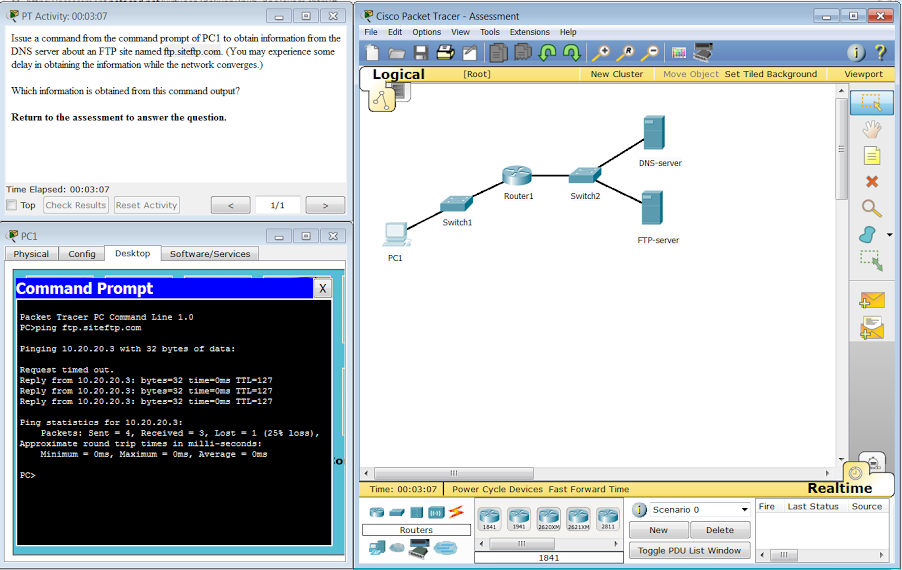 Which information is obtained from this command output?
Which information is obtained from this command output?
- 10.20.20.3, non-authoritative answer*
- 10.20.20.4, non-authoritative answer
- 10.20.20.3, authoritative answer
- 10.20.20.4, authoritative answer
116. What makes fiber preferable to copper cabling for interconnecting buildings? (Choose three.)
- greater bandwidth potential*
- limited susceptibility to EMI/RFI*
- durable connections
- easily terminated
- greater distances per cable run*
- lower installation cost
117. A network team is comparing physical WAN topologies for
connecting remote sites to a headquarters building. Which topology
provides high availability and connects some, but not all, remote sites?
- point-to-point
- mesh
- partial mesh*
- hub and spoke
118. What is the function of CSMA/CA in a WLAN?
- It assures that clients are connected to the correct WLAN.
- It describes the smallest building block of the WLAN.
- It provides the mechanism for media access.*
- It allows a host to move between cells without loss of signal.
119. Fill in the blank.
A nibble consists of “
4” bits.
120. Place the options in the following order:

 [+] cables connecting rooms to wiring closets
[+] desktop PC in a classroom
[#] IP address of a server
[#] a switch located in a classroom
[+] cables connecting rooms to wiring closets
[+] desktop PC in a classroom
[#] IP address of a server
[#] a switch located in a classroom
[+] Order does not matter within this group.
[#] Order does not matter within this group.
121. Why are the paired wires twisted in a CAT5 cable?
- to improve the mechanical strength
- to provide eletromagnetic noise cancellation*
- to facilitate cable termination in the connector
- to extend the signaling length
122. Refer to the exhibit. What will be the result of
entering this configuration the next time a network administrator
connects a console cable to the router and no additional commands have
been entered?
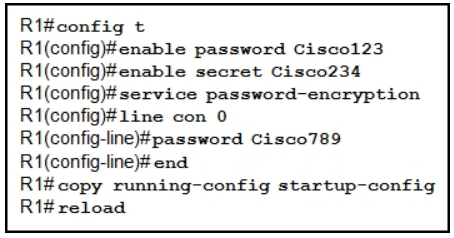
- The administrator will be presented with the R1> prompt.*
- The administrator will be required to enter Cisco789.
- The administrator will be required to enter Cisco234.
- The administrator will be required to enter Cisco123.
123. Question as presented:

 124. Refer to the exhibit. Using VLSM, what is the largest
and smallest subnet mask required on this network in order to minimize
address waste?
124. Refer to the exhibit. Using VLSM, what is the largest
and smallest subnet mask required on this network in order to minimize
address waste?
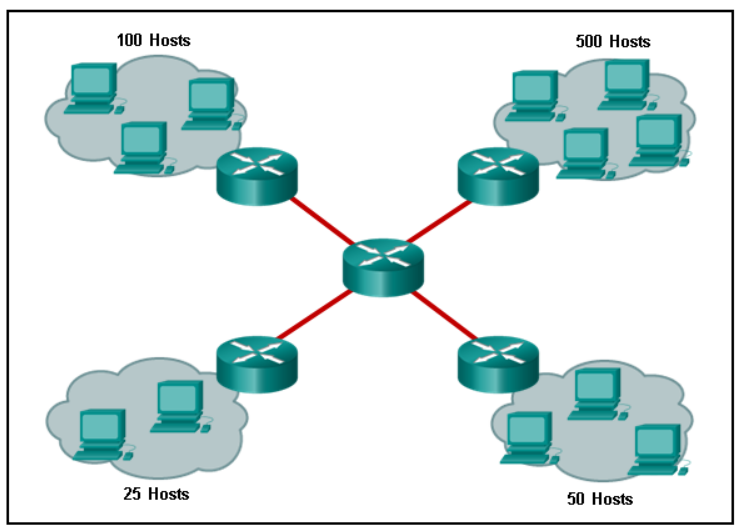
- 255.255.254.0 and 255.255.255.252*
- 255.255.255.128 and 255.255.255.224
- 255.255.254.0 and 255.255.255.224
- 255.255.255.0 and 255.255.255.252
125. What is one purpose of the TCP three-way handshake?
- synchronizing sequence numbers between source and destination in preparation for data transfer*
- determining the IP address of the destination host in preparation for data transfer
- sending echo requests from the source to the destination host to establish the presence of the destination
- requesting the destination to transfer a binary file to the source
126. Which type of wireless security is easily compromised?
127. An administrator needs to upgrade the IOS in a router to
a version that supports new features. Which factor should the
administrator consider before performing the upgrade?
- NVRAM must be erased before the new IOS can be installed.
- The old IOS should be backed up to NVRAM so that it is not lost during a power failure.
- The new IOS might require more RAM to function properly.*
- The old IOS must be removed first.
128. Which two statements describe the characteristics of fiber-optic cabling? (Choose two.)
- Fiber-optic cabling does not conduct electricity.*
- Fiber-optic cabling has high signal loss.
- Fiber-optic cabling is primarily used as backbone cabling.*
- Multimode fiber-optic cabling carries signals from multiple sending devices.
- Fiber-optic cabling uses LEDs for single-mode cables and laser technology for multimode cables.
129. A host PC is attempting to lease an address through
DHCP. What message is sent by the server to let the client know it is
able to use the provided IP information?
- DHCPDISCOVER
- DHCPOFFER
- DHCPREQUEST
- DHCPACK*
- DHCPNACK
130. What part of the URL, http://www.cisco.com/index.html, represents the top-level DNS domain?
131. A user issues the ipconfig /displaydns command on the workstation. What is the function of this command?
- to show all of the cached DNS entries*
- to show the local DNS server parameters
- to show the result of last name resolution request
- to show the DNS configuration for the workstation
132. Consider the following range of addresses:
2001:0DB8:BC15:00A0:0000::
2001:0DB8:BC15:00A1:0000::
2001:0DB8:BC15:00A2:0000::
…
2001:0DB8:BC15:00AF:0000::
The prefix-length for the range of addresses is __
60__
133. Which publicly available resources describe protocols,
processes, and technologies for the Internet but do not give
implementation details?
- protocol models
- Request for Comments*
- IRTF research papers
- IEEE standards
134. What information does the loopback test provide?
- The device has the correct IP address on the network.
- The Ethernet cable is working correctly.
- The device has end-to-end connectivity.
- DHCP is working correctly.
- The TCP/IP stack on the device is working correctly.*
135. What are the two main components of Cisco Express Forwarding (CEF)? (Choose two.)
- adjacency tables*
- ARP tables
- routing tables
- forwarding information base (FIB)*
- MAC-address tables
136. Which subnet would include the address 192.168.1.96 as a usable host address?
- 192.168.1.64/26*
- 192.168.1.32/27
- 192.168.1.32/28
- 192.168.1.64/29
137. When applied to a router, which command would help mitigate brute-force password attacks against the router?
- exec-timeout 30
- banner motd $Max failed logins = 5$
- login block-for 60 attempts 5 within 60*
- service password-encryption
138. Which statement best describes the operation of the File Transfer Protocol?
- An FTP client uses a source port number of 21 and a randomly
generated destination port number during the establishment of control
traffic with an FTP Server.
- An FTP client uses a source
port number of 20 and a randomly generated destination port number
during the establishment of data traffic with an FTP Server.*
- An FTP server uses a source port number of 20 and a randomly
generated destination port number during the establishment of control
traffic with an FTP client.
- An FTP server uses a source port number of 21 and a randomly
generated destination port number during the establishment of control
traffic with an FTP client.
Download PDF File below:
Version 6.0:
1. What is a characteristic of a fault tolerant network?
- a network that protects confidential information from unauthorized access
- a network that can expand quickly to support new users and
applications without impacting the performance of the service delivered
to existing users
- a network that supports a mechanism for managing congestion and ensuring reliable delivery of content to all users
- a network that recovers quickly when a failure occurs and depends on redundancy to limit the impact of a failure*
Explain:
Fault tolerant networks limit the impact of a failure because the
networks are built in a way that allows for quick recovery when such a
failure occurs. These networks depend on multiple or redundant paths
between the source and destination of a message.
A scalable network can expand quickly to support new users and
applications without impacting the performance of the service being
delivered to existing users.
Quality of service (QoS) is a mechanism for managing congestion and ensuring reliable delivery of content to all users.
2. Three bank employees are using the corporate network. The
first employee uses a web browser to view a company web page in order to
read some announcements. The second employee accesses the corporate
database to perform some financial transactions. The third employee
participates in an important live audio conference with other corporate
managers in branch offices. If QoS is implemented on this network, what
will be the priorities from highest to lowest of the different data
types?
- financial transactions, audio conference, web page
- audio conference, financial transactions, web page*
- audio conference, web page, financial transactions
- financial transactions, web page, audio conference
Explain:
QoS mechanisms enable the establishment of queue management strategies
that enforce priorities for different categories of application data.
Thus, this queuing enables voice data to have priority over transaction
data, which has priority over web data.
3. What is a benefit of using cloud computing in networking?
- End users have the freedom to use personal tools to access information and communicate across a business network.
- Network capabilities are extended without requiring investment in new infrastructure, personnel, or software.*
- Technology is integrated into every-day appliances allowing them to
interconnect with other devices, making them more ‘smart’ or automated.
- Home networking uses existing electrical wiring to connect devices
to the network wherever there is an electrical outlet, saving the cost
of installing data cables.
Explain:
Cloud computing extends IT’s capabilities without requiring investment
in new infrastructure, training new personnel, or licensing new
software. These services are available on-demand and delivered
economically to any device anywhere in the world without compromising
security or function. BYOD is about end users having the freedom to use
personal tools to access information and communicate across a business
or campus network. Smart home technology is integrated into every-day
appliances allowing them to interconnect with other devices, making them
more ‘smart’ or automated. Powerline networking is a trend for home
networking that uses existing electrical wiring to connect devices to
the network wherever there is an electrical outlet, saving the cost of
installing data cables.
4. What is the function of the shell in an OS?
- It interacts with the device hardware.
- It interfaces between the users and the kernel.*
- It provides dedicated firewall services.
- It provides the intrusion protection services for the device.
Explain:
Most operating systems contain a shell and a kernel. The kernel
interacts with the hardware and the shell interfaces between the kernel
and the users.
5. Which connection provides a secure CLI session with encryption to a Cisco switch?
- a console connection
- an AUX connection
- a Telnet connection
- an SSH connection*
Explain:
A CLI session using Secure Shell (SSH) provides enhanced security
because SSH supports strong passwords and encryption during the
transport of session data. The other methods support authentication but
not encryption.
6. A network technician is attempting to configure an interface
by entering the following command: SanJose(config)# ip address
192.168.2.1 255.255.255.0. The command is rejected by the device. What
is the reason for this?
- The command is being entered from the wrong mode of operation.*
- The command syntax is wrong.
- The subnet mask information is incorrect.
- The interface is shutdown and must be enabled before the switch will accept the IP address.
Explain:
The wrong mode of operation is being used. The CLI prompt indicates that
the mode of operation is global configuration. IP addresses must be
configured from interface configuration mode, as indicated by the
SanJose(config-if)# prompt.
7. An administrator uses the Ctrl-Shift-6 key combination on a
switch after issuing the ping command. What is the purpose of using
these keystrokes?
- to restart the ping process
- to interrupt the ping process*
- to exit to a different configuration mode
- to allow the user to complete the command
Explain:
To interrupt an IOS process such as ping or traceroute, a user enters
the Ctrl-Shift-6 key combination. Tab completes the remainder of
parameters or arguments within a command. To exit from configuration
mode to privileged mode use the Ctrl-Z keystroke. CTRL-R will redisplay
the line just typed, thus making it easier for the user to press Enter
and reissue the ping command.
8. Refer to the exhibit. A network administrator is configuring
access control to switch SW1. If the administrator uses a console
connection to connect to the switch, which password is needed to access
user EXEC mode?
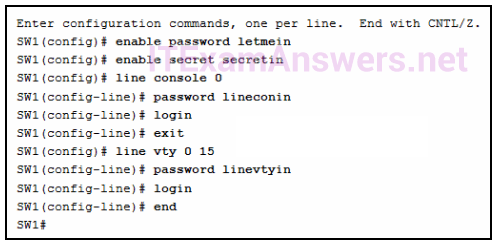
- letmein
- secretin
- linevtyin
- lineconin*
Explain:
Telnet accesses a network device through the virtual interface
configured with the line VTY command. The password configured under this
is required to access the user EXEC mode. The password configured under
the line console 0 command is required to gain entry through the
console port, and the enable and enable secret passwords are used to
allow entry into the privileged EXEC mode.
9. On which switch interface would an administrator configure an IP address so that the switch can be managed remotely?
- FastEthernet0/1
- VLAN 1*
- vty 0
- console 0
Explain:
Interface VLAN 1 is a virtual interface on a switch, called SVI (switch
virtual interface). Configuring an IP address on the default SVI,
interface VLAN 1, will allow a switch to be accessed remotely. The VTY
line must also be configured to allow remote access, but an IP address
cannot be configured on this line.
10. What protocol is responsible for controlling the size of
segments and the rate at which segments are exchanged between a web
client and a web server?
Explain:
TCP is a Layer 4 protocol of the OSI model. TCP has several
responsibilities in the network communication process. It divides large
messages into smaller segments which are more efficient to send across
the network. It also controls the size and rate of segments exchanged
between clients and servers.
11. What is an advantage to using a protocol that is defined by an open standard?
- A company can monopolize the market.
- The protocol can only be run on equipment from a specific vendor.
- An open standard protocol is not controlled or regulated by standards organizations.
- It encourages competition and promotes choices.*
Explain:
A monopoly by one company is not a good idea from a user point of view.
If a protocol can only be run on one brand, it makes it difficult to
have mixed equipment in a network. A proprietary protocol is not free to
use. An open standard protocol will in general be implemented by a wide
range of vendors.
12. What are two benefits of using a layered network model? (Choose two.)
- It assists in protocol design. *
- It speeds up packet delivery.
- It prevents designers from creating their own model.
- It prevents technology in one layer from affecting other layers.*
- It ensures a device at one layer can function at the next higher layer.
Explain:
Some vendors have developed their own reference models and protocols.
Today, if a device is to communicate on the Internet, the device must
use the TCP/IP model. The benefits of using a layered model are as
follows:
assists in protocol design
fosters competition between vendors
prevents a technology that functions at one layer from affecting any other layer
provides a common language for describing network functionality
helps in visualizing the interaction between each layer and protocols between each layer
13. Which two OSI model layers have the same functionality as two layers of the TCP/IP model? (Choose two.)
- data link
- network*
- physical
- session
- transport*
Explain:
The OSI transport layer is functionally equivalent to the TCP/IP
transport layer, and the OSI network layer is equivalent to the TCP/IP
internet layer. The OSI data link and physical layers together are
equivalent to the TCP/IP network access layer. The OSI session layer
(with the presentation layer) is included within the TCP/IP application
layer.
14. Which name is assigned to the transport layer PDU?
- bits
- data
- frame
- packet
- segment*
Explain:
Application data is passed down the protocol stack on its way to be
transmitted across the network media. During the process, various
protocols add information to it at each level. At each stage of the
process, a PDU (protocol data unit) has a different name to reflect its
new functions. The PDUs are named according to the protocols of the
TCP/IP suite:
Data – The general term for the PDU used at the application layer.
Segment – transport layer PDU
Packet – network layer PDU
Frame – data link layer PDU
Bits – A physical layer PDU used when physically transmitting data over the medium
15. A network engineer is measuring the transfer of bits across
the company backbone for a mission critical database application. The
engineer notices that the network throughput appears lower than the
bandwidth expected. Which three factors could influence the differences
in throughput? (Choose three.)
- the amount of traffic that is currently crossing the network*
- the sophistication of the encapsulation method applied to the data
- the type of traffic that is crossing the network*
- the latency that is created by the number of network devices that the data is crossing*
- the bandwidth of the WAN connection to the Internet
- the reliability of the gigabit Ethernet infrastructure of the backbone
Explain:
Throughput usually does not match the specified bandwidth of physical
links due to multiple factors. These factors include, the amount of
traffic, type of traffic, and latency created by the network devices the
data has to cross.
16. A network administrator is troubleshooting connectivity
issues on a server. Using a tester, the administrator notices that the
signals generated by the server NIC are distorted and not usable. In
which layer of the OSI model is the error categorized?
- presentation layer
- network layer
- physical layer*
- data link layer
Explain:
The NIC has responsibilities in both Layer 1 and Layer 2. The NIC
encodes the frame as a series of signals that are transmitted onto the
local media. This is the responsibility of the physical layer of the OSI
model. The signal could be in the form of electrical, optical, or radio
waves.
17. Which type of UTP cable is used to connect a PC to a switch port?
- console
- rollover
- crossover
- straight-through**
Explain:
A rollover cable is a Cisco proprietary cable used to connect to a
router or switch console port. A straight-through (also called patch)
cable is usually used to interconnect a host to a switch and a switch to
a router. A crossover cable is used to interconnect similar devices
together, for example, between two switches, two routers, and two hosts.
18. A network administrator is measuring the transfer of bits
across the company backbone for a mission critical financial
application. The administrator notices that the network throughput
appears lower than the bandwidth expected. Which three factors could
influence the differences in throughput? (Choose three.)
- the amount of traffic that is currently crossing the network*
- the sophistication of the encapsulation method applied to the data
- the type of traffic that is crossing the network *
- the latency that is created by the number of network devices that the data is crossing*
- the bandwidth of the WAN connection to the Internet
- the reliability of the gigabit Ethernet infrastructure of the backbone
Explain:
Throughput usually does not match the specified bandwidth of physical
links due to multiple factors. These factors include, the amount of
traffic, type of traffic, and latency created by the network devices the
data has to cross.
19. What is a characteristic of UTP cabling?
- cancellation*
- cladding
- immunity to electrical hazards
- woven copper braid or metallic foil
Explain:
Cladding and immunization from electrical hazards are characteristics
for fiber-optic cabling. A woven copper braid or metallic foil is used
as a shield for the inner coaxial cable conductor. Cancellation is a
property of UTP cabling where two wires are located adjacent to one
another so each magnetic field cancels out the adjacent magnetic field.
20. What are two characteristics of fiber-optic cable? (Choose two.)
- It is not affected by EMI or RFI.*
- Each pair of cables is wrapped in metallic foil.
- It combines the technique of cancellation, shielding, and twisting to protect data.
- It typically contains 4 pairs of fiber-optic wires.
- It is more expensive than UTP cabling is.*
Explain:
Fiber-optic cabling supports higher bandwidth than UTP for longer
distances. Fiber is immune to EMI and RFI, but costs more, requires more
skill to install, and requires more safety precautions.
21. What is a characteristic of the LLC sublayer?
- It provides the logical addressing required that identifies the device.
- It provides delimitation of data according to the physical signaling requirements of the medium.
- It places information in the frame allowing multiple Layer 3 protocols to use the same network interface and media.*
- It defines software processes that provide services to the physical layer.
Explain:
The Logical Link Control (LLC) defines the software processes that
provide services to the network layer protocols. The information is
placed by LLC in the frame and identifies which network layer protocol
is being used for the frame. This information allows multiple Layer 3
protocols, such as IPv4 and IPv6, to utilize the same network interface
and media.
22. A network team is comparing physical WAN topologies for
connecting remote sites to a headquarters building. Which topology
provides high availability and connects some, but not all, remote sites?
- mesh
- partial mesh*
- hub and spoke
- point-to-point
Explain:
Partial mesh topologies provide high availability by interconnecting
multiple remote sites, but do not require a connection between all
remote sites. A mesh topology requires point-to-point links with every
system being connected to every other system. A point-to-point topology
is where each device is connected to one other device. A hub and spoke
uses a central device in a star topology that connects to other
point-to-point devices.
23. What method is used to manage contention-based access on a wireless network?
- CSMA/CD
- priority ordering
- CSMA/CA*
- token passing
Explain:
Carrier sense multiple access with collision avoidance (CSMA/CA) is used
with wireless networking technology to mediate media contention.
Carrier sense multiple access with collision detection (CSMA/CD) is used
with wired Ethernet technology to mediate media contention. Priority
ordering and token passing are not used (or not a method) for media
access control.
24. What are the three primary functions provided by Layer 2 data encapsulation? (Choose three.)
- error correction through a collision detection method
- session control using port numbers
- data link layer addressing*
- placement and removal of frames from the media
- detection of errors through CRC calculations *
- delimiting groups of bits into frames*
- conversion of bits into data signals
Explain:
Through the framing process, delimiters are used to identify the start
and end of the sequence of bits that make up a frame. Data link layer
addressing is added to enable a frame to be delivered to a destination
node. A cyclic redundancy check (CRC) field is calculated on every bit
and added to the frame. If the CRC value contained in the arriving frame
is the same as the one the receiving node creates, the frame will be
processed.
25. What will a host on an Ethernet network do if it receives a
frame with a destination MAC address that does not match its own MAC
address?
- It will discard the frame.*
- It will forward the frame to the next host.
- It will remove the frame from the media.
- It will strip off the data-link frame to check the destination IP address.
Explain:
In an Ethernet network, each NIC in the network checks every arriving
frame to see if the destination MAC address in the frame matches its own
MAC address. If there is no match, the device discards the frame. If
there is a match, the NIC passes the frame up to the next OSI layer.
26. What are two examples of the cut-through switching method? (Choose two.)
- store-and-forward switching
- fast-forward switching*
- CRC switching
- fragment-free switching*
- QOS switching
Explain:
Store-and forward switching accepts the entire frame and performs error
checking using CRC before forwarding the frame. Store-and-forward is
often required for QOS analysis. Fast-forward and fragment-free are both
variations of the cut-through switching method where only part of the
frame is received before the switch begins to forward it.
27. What are two actions performed by a Cisco switch? (Choose two.)
- building a routing table that is based on the first IP address in the frame header
- using the source MAC addresses of frames to build and maintain a MAC address table*
- forwarding frames with unknown destination IP addresses to the default gateway
- utilizing the MAC address table to forward frames via the destination MAC address*
- examining the destination MAC address to add new entries to the MAC address table
Explain:
Important actions that a switch performs are as follows:
When a frame comes in, the switch examines the Layer 2 source address to build and maintain the Layer 2 MAC address table.
It examines the Layer 2 destination address to determine how to forward
the frame. When the destination address is in the MAC address table,
then the frame is sent out a particular port. When the address is
unknown, the frame is sent to all ports that have devices connected to
that network.
28. Which frame forwarding method receives the entire frame and
performs a CRC check to detect errors before forwarding the frame?
- cut-through switching
- store-and-forward switching*
- fragment-free switching
- fast-forward switching
Explain:
Fast-forward and fragment-free switching are variations of cut-through
switching, which begins to forward the frame before the entire frame is
received.
29. Refer to the exhibit. If host A sends an IP packet to host
B, what will the destination address be in the frame when it leaves host
A?
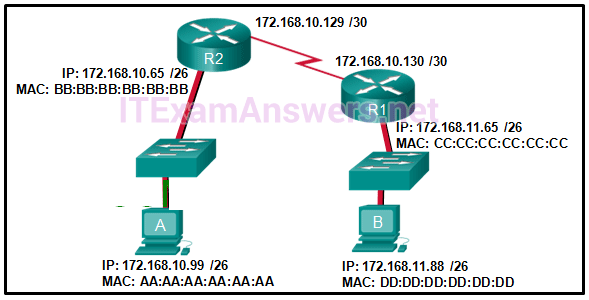
- DD:DD:DD:DD:DD:DD
- 172.168.10.99
- CC:CC:CC:CC:CC:CC
- 172.168.10.65
- BB:BB:BB:BB:BB:BB*
- AA:AA:AA:AA:AA:AA
Explain:
When a host sends information to a distant network, the Layer 2 frame
header will contain a source and destination MAC address. The source
address will be the originating host device. The destination address
will be the router interface that connects to the same network. In the
case of host A sending information to host B, the source address is
AA:AA:AA:AA:AA:AA and the destination address is the MAC address
assigned to the R2 Ethernet interface, BB:BB:BB:BB:BB:BB.
30. What addresses are mapped by ARP?
- destination MAC address to a destination IPv4 address*
- destination IPv4 address to the source MAC address
- destination IPv4 address to the destination host name
- destination MAC address to the source IPv4 address
Explain:
ARP, or the Address Resolution Protocol, works by mapping a destination
MAC address to a destination IPv4 address. The host knows the
destination IPv4 address and uses ARP to resolve the corresponding
destination MAC address.
31. What information is added during encapsulation at OSI Layer 3?
- source and destination MAC
- source and destination application protocol
- source and destination port number
- source and destination IP address*
Explain:
IP is a Layer 3 protocol. Layer 3 devices can open the Layer 3 header to
inspect the Layer 3 header which contains IP-related information
including the source and destination IP addresses.
32. What are two services provided by the OSI network layer? (Choose two.)
- performing error detection
- routing packets toward the destination *
- encapsulating PDUs from the transport layer*
- placement of frames on the media
- collision detection
Explain:
The OSI network layer provides several services to allow communication between devices:
addressing
encapsulation
routing
de-encapsulation
Error detection, placing frames on the media, and collision detection are all functions of the data ink layer.
33. Refer to the exhibit. The network administrator for a small
advertising company has chosen to use the 192.168.5.96/27 network for
internal LAN addressing. As shown in the exhibit, a static IP address is
assigned to the company web server. However, the web server cannot
access the Internet. The administrator verifies that local workstations
with IP addresses that are assigned by a DHCP server can access the
Internet, and the web server is able to ping local workstations. Which
component is incorrectly configured?
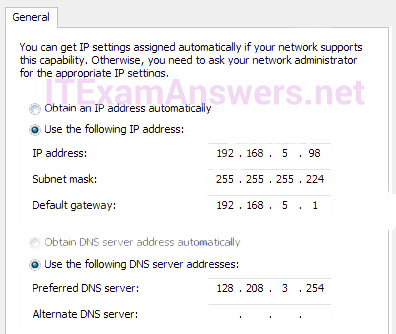
- subnet mask
- DNS address
- host IP address
- default gateway address*
Explain:
When a 255.255.255.224 subnet mask is used, the first three bits of the
last octet are part of the network portion for an IPv4 address in the
subnet. For the 192.168.5.96/27 network, valid host addresses are
192.168.5.97 through 192.168.5.126. The default gateway address is for
the Layer 3 device on the same network and it must contain an IP address
within the valid IP address range.
34. Why does a Layer 3 device perform the ANDing process on a destination IP address and subnet mask?
- to identify the broadcast address of the destination network
- to identify the host address of the destination host
- to identify faulty frames
- to identify the network address of the destination network*
Explain:
ANDing allows us to identify the network address from the IP address and the network mask.
35. What are two functions of NVRAM? (Choose two.)
- to store the routing table
- to retain contents when power is removed *
- to store the startup configuration file*
- to contain the running configuration file
- to store the ARP table
Explain:
NVRAM is permanent memory storage, so the startup configuration file is preserved even if the router loses power.
36. Refer to the exhibit. What will be the result of entering
this configuration the next time a network administrator connects a
console cable to the router and no additional commands have been
entered?
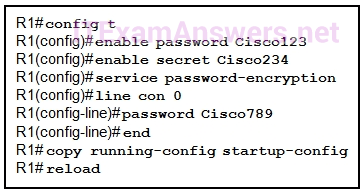
- The administrator will be required to enter Cisco123.
- The administrator will be required to enter Cisco234.
- The administrator will be required to enter Cisco789.
- The administrator will be presented with the R1> prompt.*
Explain:
Until both the password password and the login commands are entered in
console line configuration mode, no password is required to gain access
to enable mode.
37. What is the dotted decimal representation of the IPv4 address 11001011.00000000.01110001.11010011?
- 192.0.2.199
- 198.51.100.201
- 203.0.113.211*
- 209.165.201.223
Explain:
Each section (octet) contains eight binary digits. Each digit represents
a specific value (128, 64, 32, 16, 8, 4, 2, and 1). Everywhere there is
a 1, the specific value is relevant. Add all relevant values in a
particular octet to obtain the decimal value. For example binary
11001011 equals 203 in decimal.
38. What are three characteristics of multicast transmission? (Choose three.)
- The source address of a multicast transmission is in the range of 224.0.0.0 to 224.0.0.255.
- A single packet can be sent to a group of hosts. *
- Multicast transmission can be used by routers to exchange routing information. *
- Routers will not forward multicast addresses in the range of 224.0.0.0 to 224.0.0.255.*
- Computers use multicast transmission to request IPv4 addresses.
- Multicast messages map lower layer addresses to upper layer addresses.
Explain:
Broadcast messages consist of single packets that are sent to all hosts
on a network segment. These types of messages are used to request IPv4
addresses, and map upper layer addresses to lower layer addresses. A
multicast transmission is a single packet sent to a group of hosts and
is used by routing protocols, such as OSPF and RIPv2, to exchange
routes. The address range 224.0.0.0 to 224.0.0.255 is reserved for
link-local addresses to reach multicast groups on a local network.
39. What are the three ranges of IP addresses that are reserved for internal private use? (Choose three.)
- 10.0.0.0/8*
- 64.100.0.0/14
- 127.16.0.0/12
- 172.16.0.0/12*
- 192.31.7.0/24
- 192.168.0.0/16*
Explain:
The private IP address blocks that are used inside companies are as follows:
10.0.0.0 /8 (any address that starts with 10 in the first octet)
172.16.0.0 /12 (any address that starts with 172.16 in the first two octets through 172.31.255.255)
192.168.0.0 /16 (any address that starts with 192.168 in the first two octets)
40. What purpose does NAT64 serve in IPv6?
- It converts IPv6 packets into IPv4 packets.*
- It translates private IPv6 addresses into public IPv6 addresses.
- It enables companies to use IPv6 unique local addresses in the network.
- It converts regular IPv6 addresses into 64-bit addresses that can be used on the Internet.
- It converts the 48-bit MAC address into a 64-bit host address that can be used for automatic host addressing.
Explain:
NAT64 is typically used in IPv6 when networks are being transitioned
from IPv4 to IPv6. It allows the IPv6 networks to connect to IPv4
networks (such as the Internet), and works by translating the IPv6
packets into IPv4 packets.
41. What is the most compressed representation of the IPv6 address 2001:0000:0000:abcd:0000:0000:0000:0001?
- 2001:0:abcd::1
- 2001:0:0:abcd::1*
- 2001::abcd::1
- 2001:0000:abcd::1
- 2001::abcd:0:1
Explain:
The IPv6 address 2001:0000:0000:abcd:0000:0000:0000:0001 in its most
compressed format would be 2001:0:0:abcd::1. The first two hextets of
zeros would each compress to a single zero. The three consecutive
hextets of zeros can be compressed to a double colon ::. The three
leading zeros in the last hextet can be removed. The double colon :: can
only be used once in an address.
42. Which range of link-local addresses can be assigned to an IPv6-enabled interface?
- FEC0::/10
- FDEE::/7
- FE80::/10*
- FF00::/8
Explain:
Link-local addresses are in the range of FE80::/10 to FEBF::/10. The
original IPv6 specification defined site-local addresses and used the
prefix range FEC0::/10, but these addresses were deprecated by the IETF
in favor of unique local addresses. FDEE::/7 is a unique local address
because it is in the range of FC00::/7 to FDFF::/7. IPv6 multicast
addresses have the prefix FF00::/8.
43. Which three addresses are valid public addresses? (Choose three.)
- 198.133.219.17*
- 192.168.1.245
- 10.15.250.5
- 128.107.12.117*
- 192.15.301.240
- 64.104.78.227 *
44. Refer to the exhibit. On the basis of the output, which two statements about network connectivity are correct? (Choose two.)

- There is connectivity between this device and the device at 192.168.100.1.*
- The connectivity between these two hosts allows for videoconferencing calls.
- There are 4 hops b**etween this device and the device at 192.168.100.1.*
- The average transmission time between the two hosts is 2 milliseconds.
- This host does not have a default gateway configured.
Explain:
The output displays a successful Layer 3 connection between a host
computer and a host at 19.168.100.1. It can be determined that 4 hops
exist between them and the average transmission time is 1 milliseconds.
Layer 3 connectivity does not necessarily mean that an application can
run between the hosts.
45. What type of IPv6 address is FE80::1?
- loopback
- link-local*
- multicast
- global unicast
Explain:
Link-local IPv6 addresses start with FE80::/10, which is any address
from FE80:: to FEBF::. Link-local addresses are used extensively in IPv6
and allow directly connected devices to communicate with each other on
the link they share.
46. How many valid host addresses are available on an IPv4 subnet that is configured with a /26 mask?
Explain:
When a /26 mask is used, 6 bits are used as host bits. With 6 bits, 64
addresses are possible, but one address is for the subnet number and one
address is for a broadcast. This leaves 62 addresses that can be
assigned to network devices.
47. A site administrator has been told that a particular network
at the site must accommodate 126 hosts. Which subnet mask would be used
that contains the required number of host bits?
- 255.255.255.0
- 255.255.255.128*
- 255.255.255.224
- 255.255.255.240
Explain:
The subnet mask of 255.255.255.0 has 8 host bits. The mask of
255.255.255.128 results in 7 host bits. The mask of 255.255.255.224 has 5
host bits. Finally, 255.255.255.240 represents 4 host bits.
48. A network administrator wants to have the same subnet mask
for three subnetworks at a small site. The site has the following
networks and numbers of devices:
Subnetwork A: IP phones – 10 addresses
Subnetwork B: PCs – 8 addresses
Subnetwork C: Printers – 2 addresses
What single subnet mask would be appropriate to use for the three subnetworks?
- 255.255.255.0
- 255.255.255.240*
- 255.255.255.248
- 255.255.255.252
Explain:
If the same mask is to be used, then the network with the most hosts
must be examined for number of hosts. Because this is 10 hosts, 4 host
bits are needed. The /28 or 255.255.255.240 subnet mask would be
appropriate to use for these networks.
49. How many hosts are addressable on a network that has a mask of 255.255.255.248?
Explain:
The subnet mask of 255.255.255.248 is the same as /29. This means the
network portion of the address is 29 of the 32 bits in the address. Only
3 bits remain for host bits. 2^3 = 8, but one of these addresses has to
be used for the network number and one address must be used as the
broadcast address to reach all of the hosts on this network. That leaves
only 6 usable IP addresses that can be assigned to hosts in this
network. Don’t forget that the default gateway must be one of these
devices if this network is to communicate with other networks.
50. Which subnet would include the address 192.168.1.96 as a usable host address?
- 192.168.1.64/26*
- 192.168.1.32/27
- 192.168.1.32/28
- 192.168.1.64/29
Explain:
For the subnet of 192.168.1.64/26, there are 6 bits for host addresses,
yielding 64 possible addresses. However, the first and last subnets are
the network and broadcast addresses for this subnet. Therefore, the
range of host addresses for this subnet is 192.168.1.65 to
192.168.1.126. The other subnets do not contain the address 192.168.1.96
as a valid host address.
51. What subnet mask is needed if an IPv4 network has 40 devices that need IP addresses and address space is not to be wasted?
- 255.255.255.0
- 255.255.255.128
- 255.255.255.192*
- 255.255.255.224
- 255.255.255.240
Explain:
In order to accommodate 40 devices, 6 host bits are needed. With 6 bits,
64 addresses are possible, but one address is for the subnet number and
one address is for a broadcast. This leaves 62 addresses that can be
assigned to network devices. The mask associated with leaving 6 host
bits for addressing is 255.255.255.192.
52. What are two characteristics shared by TCP and UDP? (Choose two.)
- default window size
- connectionless communication
- port numbering*
- 3-way handshake
- ability to to carry digitized voice
- use of checksum*
Explain:
Both TCP and UDP use source and destination port numbers to distinguish
different data streams and to forward the right data segments to the
right applications. Error checking the header and data is done by both
protocols by using a checksum calculation to determine the integrity of
the data that is received. TCP is connection-oriented and uses a 3-way
handshake to establish an initial connection. TCP also uses window to
regulate the amount of traffic sent before receiving an acknowledgment.
UDP is connectionless and is the best protocol for carry digitized VoIP
signals.
53. Why are port numbers included in the TCP header of a segment?
- to indicate the correct router interface that should be used to forward a segment
- to identify which switch ports should receive or forward the segment
- to determine which Layer 3 protocol should be used to encapsulate the data
- to enable a receiving host to forward the data to the appropriate application*
- to allow the receiving host to assemble the packet in the proper order
54. Refer to the exhibit. Consider the IP address of
192.168.10.0/24 that has been assigned to a high school building. The
largest network in this building has 100 devices. If 192.168.10.0 is the
network number for the largest network, what would be the network
number for the next largest network, which has 40 devices?
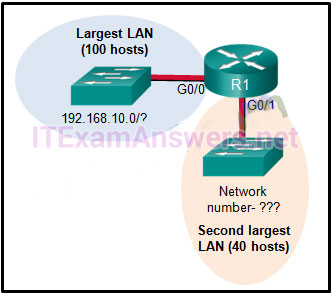
- 192.168.10.0
- 192.168.10.128*
- 192.168.10.192
- 192.168.10.224
- 192.168.10.240
Explain:
The first thing to calculate is what IP addresses are used by the
largest LAN. Because the LAN has 100 hosts, 7 bits must be left for host
bits. This would be a subnet mask of 255.255.255.128 for the largest
LAN (192.168.10.0/25). The IP addresses range from 192.168.10.0 through
192.168.10.127. 192.168.10.0 is the network number (all 0s in the host
bits) and 192.168.10.127 is the broadcast for this Ethernet LAN (all 1s
in the host bits). The next available IP address is the next network
number – 192.168.10.128.
55. Which statement is true about variable-length subnet masking?
- Each subnet is the same size.
- The size of each subnet may be different, depending on requirements.*
- Subnets may only be subnetted one additional time.
- Bits are returned, rather than borrowed, to create additional subnets.
Explain:
In variable-length subnet masking, bits are borrowed to create subnets.
Additional bits may be borrowed to create additional subnets within the
original subnets. This may continue until there are no bits available to
borrow.
56. In what two situations would UDP be the preferred transport protocol over TCP? (Choose two.)
- when applications need to guarantee that a packet arrives intact, in sequence, and unduplicated
- when a faster delivery mechanism is needed*
- when delivery overhead is not an issue
- when applications do not need to guarantee delivery of the data*
- when destination port numbers are dynamic
Explain:
UDP is a stateless protocol, which means that neither device on either
end of the conversation must keep track of the conversation. As a
stateless protocol, UDP is used as the Layer 4 protocol for applications
that need speedy (best-effort) delivery. An example of such traffic is
the transport of digitized voice or video.
57. What important information is added to the TCP/IP transport
layer header to ensure communication and connectivity with a remote
network device?
- timing and synchronization
- destination and source port numbers*
- destination and source physical addresses
- destination and source logical network addresses
Explain:
The destination and source port numbers are used to identify exactly
which protocol and process is requesting or responding to a request.
58. What is the TCP mechanism used in congestion avoidance?
- three-way handshake
- socket pair
- two-way handshake
- sliding window*
Explain:
TCP uses windows to attempt to manage the rate of transmission to the
maximum flow that the network and destination device can support while
minimizing loss and retransmissions. When overwhelmed with data, the
destination can send a request to reduce the of the window. This
congestion avoidance is called sliding windows.
59. Which scenario describes a function provided by the transport layer?
- A student is using a classroom VoIP phone to call home. The unique
identifier burned into the phone is a transport layer address used to
contact another network device on the same network.
- A student is playing a short web-based movie with sound. The movie and sound are encoded within the transport layer header.
- A student has two web browser
windows open in order to access two web sites. The transport layer
ensures the correct web page is delivered to the correct browser
window.*
- A corporate worker is accessing a web server located on a corporate
network. The transport layer formats the screen so the web page appears
properly no matter what device is being used to view the web site.
Explain:
The source and destination port numbers are used to identify the correct application and window within that application.
60. A user opens three browsers on the same PC to access
www.cisco.com to search for certification course information. The Cisco
web server sends a datagram as a reply to the request from one of the
web browsers. Which information is used by the TCP/IP protocol stack in
the PC to identify which of the three web browsers should receive the
reply?
- the destination IP address
- the destination port number*
- the source IP address
- the source port number
Explain:
Each web browser client application opens a randomly generated port
number in the range of the registered ports and uses this number as the
source port number in the datagram that it sends to a server. The server
then uses this port number as the destination port number in the reply
datagram that it sends to the web browser. The PC that is running the
web browser application receives the datagram and uses the destination
port number that is contained in this datagram to identify the client
application.
61. What are two ways that TCP uses the sequence numbers in a segment? (Choose two.)
- to identify missing segments at the destination *
- to reassemble the segments at the remote location*
- to specify the order in which the segments travel from source to destination
- to limit the number of segments that can be sent out of an interface at one time
- to determine if the packet changed during transit
62. Which two tasks are functions of the presentation layer? (Choose two.)
- compression*
- addressing
- encryption*
- session control
- authentication
Explain:
The presentation layer deals with common data format. Encryption,
formatting, and compression are some of the functions of the layer.
Addressing occurs in the network layer, session control occurs in the
session layer, and authentication takes place in the application or
session layer.
63. Which three statements characterize UDP? (Choose three.)
- UDP provides basic connectionless transport layer functions.*
- UDP provides connection-oriented, fast transport of data at Layer 3.
- UDP relies on application layer protocols for error detection. *
- UDP is a low overhead protocol that does not provide sequencing or flow control mechanisms.*
- UDP relies on IP for error detection and recovery.
- UDP provides sophisticated flow control mechanisms.
Explain:
UDP is a simple protocol that provides the basic transport layer
functions. It has much lower overhead than TCP because it is not
connection-oriented and does not offer the sophisticated retransmission,
sequencing, and flow control mechanisms that provide reliability.
64. What is a key characteristic of the peer-to-peer networking model?
- wireless networking
- social networking without the Internet
- network printing using a print server
- resource sharing without a dedicated server*
Explain:
The peer-to-peer (P2P) networking model allows data, printer, and resource sharing without a dedicated server.
65. A technician can ping the IP address of the web server of a
remote company but cannot successfully ping the URL address of the same
web server. Which software utility can the technician use to diagnose
the problem?
- tracert
- ipconfig
- netstat
- nslookup*
Explain:
Traceroute (tracert) is a utility that generates a list of hops that
were successfully reached along the path from source to destination.This
list can provide important verification and troubleshooting
information. The ipconfig utility is used to display the IP
configuration settings on a Windows PC. The Netstat utility is used to
identify which active TCP connections are open and running on a
networked host. Nslookup is a utility that allows the user to manually
query the name servers to resolve a given host name. This utility can
also be used to troubleshoot name resolution issues and to verify the
current status of the name servers.
66. Which domain name would be an example of a top-level domain?
- www.cisco.com
- cisco.com
- .com*
- root.cisco.com
Explain:
Top-level domains represent a country or type of organization, such as .com or .edu.
67. A PC obtains its IP address from a DHCP server. If the PC is
taken off the network for repair, what happens to the IP address
configuration?
- The configuration is permanent and nothing changes.
- The address lease is automatically renewed until the PC is returned.
- The address is returned to the pool for reuse when the lease expires.*
- The configuration is held by the server to be reissued when the PC is returned.
Explain:
When a DCHP address is issued to a host, it is for a specific lease
time. Once the lease expires, the address is returned to the DHCP pool.
68. When planning for network growth, where in the network should packet captures take place to assess network traffic?
- on as many different network segments as possible*
- only at the edge of the network
- between hosts and the default gateway
- only on the busiest network segment
Explain:
Because some types of traffic will be only on specific network segments,
packet captures for analysis should be performed on as many segments as
possible.
69. A wireless host needs to request an IP address. What protocol would be used to process the request?
Explain:
The DHCP protocol is used to request, issue, and manage IP addressing
information. CSMA/CD is the access method used with wired Ethernet. ICMP
is used to test connectivity. SNMP is used with network management and
FTP is used for file transfer.
70. Which example of malicious code would be classified as a Trojan horse?
- malware that was written to look like a video game*
- malware that requires manual user intervention to spread between systems
- malware that attaches itself to a legitimate program and spreads to other programs when launched
- malware that can automatically spread from one system to another by exploiting a vulnerability in the target
Explain:
A Trojan horse is malicious code that has been written specifically to
look like a legitimate program. This is in contrast to a virus, which
simply attaches itself to an actual legitimate program. Viruses require
manual intervention from a user to spread from one system to another,
while a worm is able to spread automatically between systems by
exploiting vulnerabilities on those devices.
71. When applied to a router, which command would help mitigate brute-force password attacks against the router?
- exec-timeout 30
- service password-encryption
- banner motd $Max failed logins = 5$
- login block-for 60 attempts 5 within 60*
Explain:
The login block-for command sets a limit on the maximum number of failed
login attempts allowed within a defined period of time. If this limit
is exceeded, no further logins are allowed for the specified period of
time. This helps to mitigate brute-force password cracking since it will
significantly increase the amount of time required to crack a password.
The exec-timeout command specifies how long the session can be idle
before the user is disconnected. The service password-encryption command
encrypts the passwords in the running configuration. The banner motd
command displays a message to users who are logging in to the device.
72. A network technician suspects that a particular network
connection between two Cisco switches is having a duplex mismatch. Which
command would the technician use to see the Layer 1 and Layer 2 details
of a switch port?
- show mac-address-table
- show ip interface brief
- show interfaces*
- show running-config
Explain:
The show interfaces command can be used on both routers and switches to
see speed, duplex, media type, MAC address, port type, and other Layer
1/Layer 2-related information.
73. Where are Cisco IOS debug output messages sent by default?
- Syslog server
- console line*
- memory buffers
- vty lines
Explain:
Debug messages, like other IOS log messages, are sent to the console
line by default. Sending these messages to the terminal lines requires
the terminal monitor command.
74. Match the description with the associated IOS mode. (not all options are used.)
Question
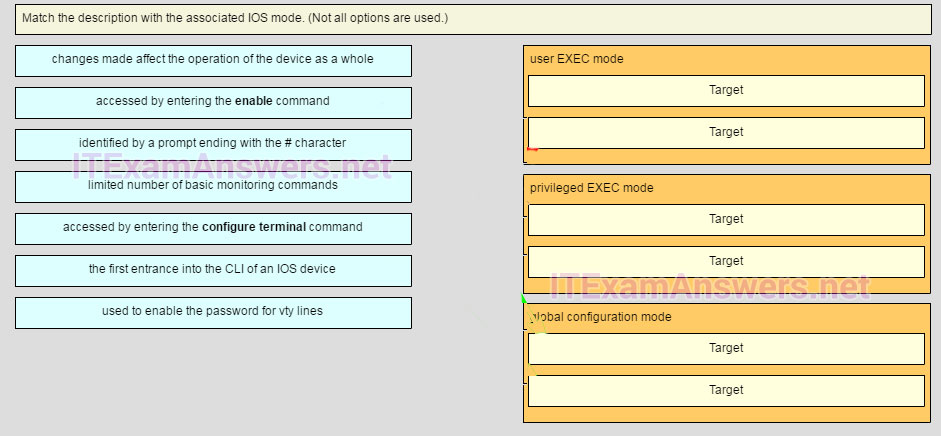 Answer
Answer
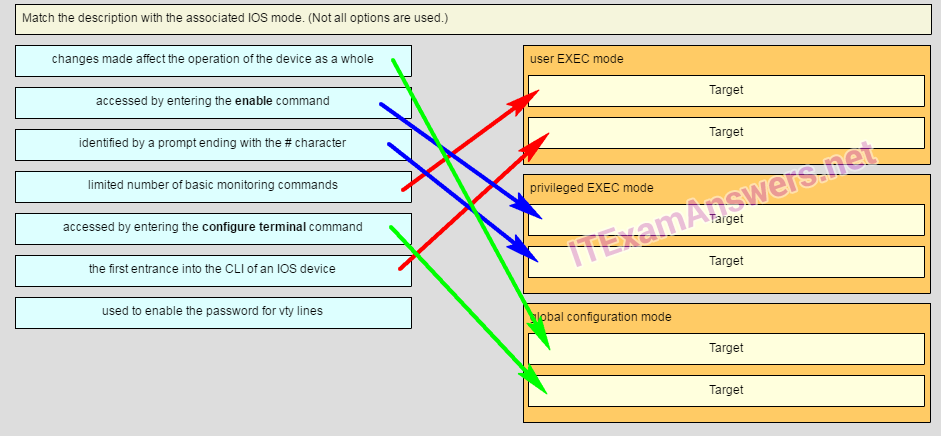
 user EXEC mode
limited number of basic monitoring commands
user EXEC mode
limited number of basic monitoring commands
the first entrance intro the CLI of an IOS device
privileged EXEC mode
accessed by entering the enable command
identified by a prompt ending with the # character
global configuration mode
changes made affect the operation of the device as a whole
accessed by entering the configure terminal command
75. Refer to the exhibit. Match the packets with their
destination IP address to the exiting interfaces on the router. (Not all
options are used.)

 Answer
Answer


- FastEthernet0/0 -> packets with destination of 172.17.6.15
- FastEthernet0/1 -> packets with destination of 172.17.14.8
- FastEthernet1/0 -> packets with destination of 172.17.12.10
- FastEthernet1/1 -> packets with destination of 172.17.10.5
- Serial0/0/0 -> packets with destination of 172.17.8.20
76. Refer to the exhibit. An administrator is testing
connectivity to a remote device with the IP address 10.1.1.1. What does
the output of this command indicate?

- Connectivity to the remote device was successful.
- A router along the path did not have a route to the destination.*
- A ping packet is being blocked by a security device along the path.
- The connection timed out while waiting for a reply from the remote device.
Explain:
In the output of the ping command, an exclamation mark (!) indicates a
response was successfully received, a period (.) indicates that the
connection timed out while waiting for a reply, and the letter “U”
indicates that a router along the path did not have a route to the
destination and sent an ICMP destination unreachable message back to the
source.
77. A user is unable to reach the web site when typing
http://www.cisco.com in a web browser, but can reach the same site by
typing http://72.163.4.161. What is the issue?
- default gateway
- DHCP
- TCP/IP protocol stack
- DNS *
Explain:
Domain Name Service (DNS) is used to translate a web address to an IP
address. The address of the DNS server is provided via DHCP to host
computers.
78. A company is expanding its business to other countries. All
branch offices must remain connected to corporate headquarters at all
times. Which network technology is required to support this requirement?
Explain:
A local-area network (LAN) normally connects end users and network
resources over a limited geographic area using Ethernet technology. A
wireless LAN (WLAN) serves the same purpose as a LAN but uses wireless
technologies. A metropolitan-area network (MAN) spans a larger
geographic area such as a city, and a wide-area network (WAN) connects
networks together over a large geographic area. WANs can span cities,
countries, or the globe.
79. A home user is looking for an ISP connection that provides
high speed digital transmission over regular phone lines. What ISP
connection type should be used?
- DSL*
- dial-up
- satellite
- cell modem
- cable modem
80. How does quality of service help a network support a wide range of applications and services?
- by limiting the impact of a network failure
- by allowing quick recovery from network failures
- by providing mechanisms to manage congested network traffic*
- by providing the ability for the network to grow to accommodate new users
Explain:
Quality of service (QoS), is a vital component of the architecture of a
network. With QoS, network administrators can provide applications with
predictable and measurable service guarantees through mechanisms that
manage congested network traffic.
81. What source IP address does a router use by default when the traceroute command is issued?
- the highest configured IP address on the router
- the lowest configured IP address on the router
- a loopback IP address
- the IP address of the outbound interface*
Explain:
When sending an echo request message, a router will use the IP address
of the exit interface as the source IP address. This default behavior
can be changed by using an extended ping and specifying a specific
source IP address.
82. After making configuration changes on a Cisco switch, a
network administrator issues a copy running-config startup-config
command. What is the result of issuing this command?
- The new configuration will be stored in flash memory.
- The new configuration will be loaded if the switch is restarted.*
- The current IOS file will be replaced with the newly configured file.
- The configuration changes will be removed and the original configuration will be restored.
Explain:
With the copy running-config startup-config command, the content of the
current operating configuration replaces the startup configuration file
stored in NVRAM. The configuration file saved in NVRAM will be loaded
when the device is restarted.
83. Refer to the exhibit. A network administrator is configuring
access control to switch SW1. If the administrator has already logged
into a Telnet session on the switch, which password is needed to access
privileged EXEC mode?
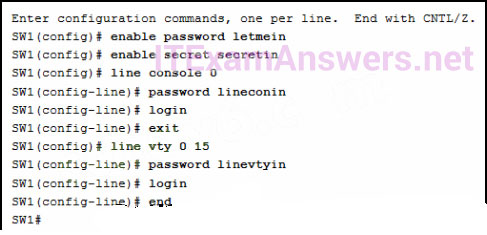
- letmein
- secretin*
- lineconin
- linevtyin
Explain:
Telnet accesses a network device through the virtual interface
configured with the line VTY command. The password configured under this
is required to access the user EXEC mode. The password configured under
the line console 0 command is required to gain entry through the
console port, and the enable and enable secret passwords are used to
allow entry into the privileged EXEC mode.
84. Match each item to the type of topology diagram on which it is typically identified. (Not all options are used.)
Question
 Answer
Answer
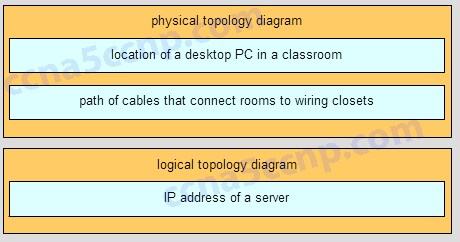
- physical topology diagram
location of a desktop PC in a classroom
path of cables that connect rooms to wiring closets
- logical topology diagram
IP address of a server
Explain:
A logical topology diagram typically depicts the IP addressing scheme
and groupings of devices and ports. A physical topology diagram shows
how those devices are connected to each other and the network, focusing
on the physical locations of intermediary devices, configured ports, and
cabling.
85. Which connection provides a secure CLI session with encryption to a Cisco network device?
- a console connection
- an AUX connection
- a Telnet connection
- an SSH connection*
Explain:
A CLI session using Secure Shell (SSH) provides enhanced security
because SSH supports strong passwords and encryption during the
transport of session data. The other methods support authentication but
not encryption.
86. What function does pressing the Tab key have when entering a command in IOS?
- It aborts the current command and returns to configuration mode.
- It exits configuration mode and returns to user EXEC mode.
- It moves the cursor to the beginning of the next line.
- It completes the remainder of a partially typed word in a command.*
Explain:
Pressing the Tab key after a command has been partially typed will cause the IOS to complete the rest of the command.
87. What layer is responsible for routing messages through an internetwork in the TCP/IP model?
- internet*
- transport
- network access
- session
Explain:
The TCP/IP model consists of four layers: application, transport,
internet, and network access. Of these four layers, it is the internet
layer that is responsible for routing messages. The session layer is not
part of the TCP/IP model but is rather part of the OSI model.
88. Which statement accurately describes a TCP/IP encapsulation process when a PC is sending data to the network?
- Data is sent from the internet layer to the network access layer.
- Packets are sent from the network access layer to the transport layer.
- Segments are sent from the transport layer to the internet layer.*
- Frames are sent from the network access layer to the internet layer.
Explain:
When the data is traveling from the PC to the network, the transport
layer sends segments to the internet layer. The internet layer sends
packets to the network access layer, which creates frames and then
converts the frames to bits. The bits are released to the network media.
89. What unique address is embedded in an Ethernet NIC and used for communication on an Ethernet network?
- host address
- IP address
- MAC address*
- network address
- k layer
Explain:
The MAC address is a 48-bit address that is burned into every Ethernet NIC. Each MAC address is unique throughout the world.
90. Which procedure is used to reduce the effect of crosstalk in copper cables?
- requiring proper grounding connections
- twisting opposing circuit wire pairs together*
- wrapping the bundle of wires with metallic shielding
- designing a cable infrastructure to avoid crosstalk interference
- avoiding sharp bends during installation
Explain:
In copper cables, crosstalk is a disturbance caused by the electric or
magnetic fields of a signal on one wire interfering with the signal in
an adjacent wire. Twisting opposing circuit wire pairs together can
effectively cancel the crosstalk. The other options are effective
measures to counter the negative effects of EMI and RFI, but not
crosstalk.
91. During the encapsulation process, what occurs at the data link layer for a PC connected to an Ethernet network?
- An IP address is added.
- The logical address is added.
- The physical address is added.*
- The process port number is added.
Explain:
The Ethernet frame includes the source and destination physical address.
The trailer includes a CRC value in the Frame Check Sequence field to
allow the receiving device to determine if the frame has been changed
(has errors) during the transmission.
92. What are two characteristics of Ethernet MAC addresses? (Choose two.)
- They are globally unique.*
- They are routable on the Internet.
- They are expressed as 12 hexadecimal digits.*
- MAC addresses use a flexible hierarchical structure.
- MAC addresses must be unique for both Ethernet and serial interfaces on a device.
Explain:
An Ethernet MAC address is a 48-bit binary value expressed as 12
hexadecimal digits. MAC addresses must be globally unique by design. MAC
addresses are in flat structure and thus they are not routable on the
Internet. Serial interfaces do not use MAC addresses.
93. If a device receives an Ethernet frame of 60 bytes, what will it do?
- drop the frame*
- process the frame as it is
- send an error message to the sending device
- add random data bytes to make it 64 bytes long and then forward it
Explain:
Ethernet standards define the minimum frame size as 64 bytes. A frame
less than 64 bytes is considered a “collision fragment” or “runt frame”
and is automatically discarded by receiving devices.
94. Under which two circumstances will a switch flood a frame
out of every port except the port that the frame was received on?
(Choose two.)
- The frame has the broadcast address as the destination address. *
- The destination address is unknown to the switch.*
- The source address in the frame header is the broadcast address.
- The source address in the frame is a multicast address.
- The destination address in the frame is a known unicast address.
Explain:
A switch will flood a frame out of every port, except the one that the
frame was received from, under two circumstances. Either the frame has
the broadcast address as the destination address, or the destination
address is unknown to the switch.
95. Which switching method has the lowest level of latency?
- cut-through
- store-and-forward
- fragment-free
- fast-forward*
Explain:
Fast-forward switching begins to forward a frame after reading the
destination MAC address, resulting in the lowest latency. Fragment-free
reads the first 64 bytes before forwarding. Store-and-forward has the
highest latency because it reads the entire frame before beginning to
forward it. Both fragment-free and fast-forward are types of cut-through
switching.
96. Which two commands can be used on a Windows host to display the routing table? (Choose two.)
- netstat -s
- route print*
- show ip route
- netstat -r*
- tracert
Explain:
On a Windows host, the route print or netstat -r commands can be used to
display the host routing table. Both commands generate the same output.
On a router, the show ip route command is used to display the routing
table. The netstat –scommand is used to display per-protocol statistics.
The tracert command is used to display the path that a packet travels
to its destination.
97. Which two functions are primary functions of a router? (Choose two.)
- packet forwarding*
- microsegmentation
- domain name resolution
- path selection*
- flow control
98. What is the binary representation of 0xCA?
- 10111010
- 11010101
- 11001010*
- 11011010
Explain:
When converted, CA in hex is equivalent to 11011010 in binary. One way
to do the conversion is one nibble at a time, C = 1100 and A = 1010.
Combine the two nibbles gives 11001010.
99. At a minimum, which address is required on IPv6-enabled interfaces?
- link-local*
- unique local
- site local
- global unicast
Explain:
All IPv6 enabled interfaces must at minimum have a link-local address.
Other IPv6 addresses can be assigned to the interface as required.
100. Which service provides dynamic global IPv6 addressing to
end devices without using a server that keeps a record of available IPv6
addresses?
- stateful DHCPv6
- SLAAC*
- static IPv6 addressing
- stateless DHCPv6
Explain:
Using stateless address autoconfiguration (SLAAC), a PC can solicit a
router and receive the prefix length of the network. From this
information the PC can then create its own IPv6 global unicast address.
101. What is the purpose of the command ping ::1?
- It tests the internal configuration of an IPv6 host.*
- It tests the broadcast capability of all hosts on the subnet.
- It tests the multicast connectivity to all hosts on the subnet.
- It tests the reachability of the default gateway for the network.
Explain:
The address ::1 is an IPv6 loopback address. Using the command ping ::1
tests the internal IP stack to ensure that it is configured and
functioning correctly. It does not test reachability to any external
device, nor does it confirm that IPv6 addresses are properly configured
on the host.
102. How many usable IP addresses are available on the 192.168.1.0/27 network?
Explain:
A /27 mask is the same as 255.255.255.224. This leaves 5 host bits. With
5 host bits, 32 IP addresses are possible, but one address represents
the subnet number and one address represents the broadcast address.
Thus, 30 addresses can then be used to assign to network devices.
103. What is the process of dividing a data stream into smaller pieces before transmission?
- segmentation*
- encapsulation
- encoding
- flow control
Explain:
Data streams would cause significant network congestion if they were
transmitted as a single large stream of bits. To increase efficiency,
data streams are segmented into smaller more manageable pieces which are
then transmitted over the network.
104. When IPv4 addressing is manually configured on a web
server, which property of the IPv4 configuration identifies the network
and host portion for an IPv4 address?
- DNS server address
- subnet mask*
- default gateway
- DHCP server address
Explain:
There are several components that need to be entered when configuring IPv4 for an end device:
IPv4 address – uniquely identifies an end device on the network
Subnet mask – determines the network address portion and host portion for an IPv4 address
Default gateway – the IP address of the router interface used for communicating with hosts in another network
DNS server address – the IP address of the Domain Name System (DNS) server
DHCP server address (if DHCP is used) is not configured manually on end
devices. It will be provided by a DHCP server when an end device
requests an IP address.
105. Which two roles can a computer assume in a peer-to-peer
network where a file is being shared between two computers? (Choose
two.)
- client*
- master
- server*
- slave
- transient
Explain:
In a peer-to-peer (P2P) network, two or more computers are connected and
can share resources without the use of a dedicated server. The computer
that has the file acts as a server for the device (the client) that
requests the file.
106. Which two protocols operate at the highest layer of the TCP/IP protocol stack? (Choose two.)
- DNS*
- Ethernet
- IP
- POP*
- TCP
- UDP
Explain:
The application layer is the top layer of the TCP/IP protocol stack.
Application layer protocols include HTTP, DNS, HTML, TFTP, POP, IMAP,
FTP, and SMTP.
107. What is one difference between the client-server and peer-to-peer network models?
- Only in the client-server model can file transfers occur.
- Every device in a peer-to-peer network can function as a client or a server.*
- A peer-to-peer network transfers data faster than a transfer using a client-server network.
- A data transfer that uses a device serving in a client role requires that a dedicated server be present.
Explain:
Data transfer speeds depend on a number of factors including the amount
of traffic, the quality of service imposed, and the network media.
Transfer speeds are not dependent on the network model type. File
transfers can occur using the client-server model or the peer-to-peer
model. A data transfer between a device acting in the client role and a
device acting in the server role can occur in both peer-to-peer and
client-server networks.
108. What is the function of the HTTP GET message?
- to request an HTML page from a web server*
- to send error information from a web server to a web client
- to upload content to a web server from a web client
- to retrieve client email from an email server using TCP port 110
Explain:
There are three common HTTP message types:
GET – used by clients to request data from the web server
POST – used by clients to upload data to a web server
PUT – used by clients to upload data to a web server
109. Which networking model is being used when an author uploads one chapter document to a file server of a book publisher?
- peer-to-peer
- master-slave
- client/server*
- point-to-point
Explain:
In the client/server network model, a network device assumes the role of
server in order to provide a particular service such as file transfer
and storage. In the client/server network model, a dedicated server does
not have to be used, but if one is present, the network model being
used is the client/server model. In contrast, a peer-to-peer network
does not have a dedicated server.
110. What network service resolves the URL entered on a PC to the IP address of the destination server?
Explain:
When a client attempts to connect to a website, the destination URL must
be resolved to an IP address. To do this the client queries a Domain
Name System (DNS) server.
111. A network engineer is analyzing reports from a recently
performed network baseline. Which situation would depict a possible
latency issue?
- a change in the bandwidth according to the show interfaces output
- a next-hop timeout from a traceroute
- an increase in host-to-host ping response times*
- a change in the amount of RAM according to the show version output
Explain:
While analyzing historical reports an administrator can compare
host-to-host timers from the ping command and depict possible latency
issues.
112. Which firewall feature is used to ensure that packets
coming into a network are legitimate responses to requests initiated
from internal hosts?
- stateful packet inspection*
- URL filtering
- application filtering
- packet filtering
Explain:
Stateful packet inspection on a firewall checks that incoming packets
are actually legitimate responses to requests originating from hosts
inside the network. Packet filtering can be used to permit or deny
access to resources based on IP or MAC address. Application filtering
can permit or deny access based on port number. URL filtering is used to
permit or deny access based on URL or on keywords.
113. What is one indication that a Windows computer did not receive an IPv4 address from a DHCP server?
- The computer cannot ping 127.0.0.1.
- Windows displays a DHCP timeout message.
- The computer receives an IP address that starts with 169.254*
- The computer cannot ping other devices on the same network with IP addresses in the 169.254.0.0/16 range.
Explain:
When a Windows PC cannot communicate with an IPv4 DHCP server, the
computer automatically assigns an IP address in the 169.254.0.0/16
range. Any other device on the same network that receives an address in
the same range is reachable.
114. Which command can an administrator issue on a Cisco router to send debug messages to the vty lines?
- terminal monitor*
- logging console
- logging buffered
- logging synchronous
Explain:
Debug messages, like other IOS log messages, are sent to the console
line by default. Sending these messages to the terminal lines requires
the terminal monitor command.
115. Fill in the blank.
During data communications, a host may need to send a single message to a
specific group of destination hosts simultaneously. This message is in
the form of a
Multicast message.
116. A medium-sized business is researching available options
for connecting to the Internet. The company is looking for a high speed
option with dedicated, symmetric access. Which connection type should
the company choose?
- DSL
- dialup
- satellite
- leased line*
- cable modem
117. What is the purpose of having a converged network?
- to provide high speed connectivity to all end devices
- to make sure that all types of data packets will be treated equally
- to achieve fault tolerance and high availability of data network infrastructure devices
- to reduce the cost of deploying and maintaining the communication infrastructure*
Explain:
With the development of technology, companies can now consolidate
disparate networks onto one platform called a converged network. In a
converged network, voice, video, and data travel over the same network,
thus eliminating the need to create and maintain separate networks. This
also reduces the costs associated with providing and maintaining the
communication network infrastructure.
118. What characteristic of a network enables it to quickly grow
to support new users and applications without impacting the performance
of the service being delivered to existing users?
- reliability
- scalability*
- quality of service
- accessibility
Explain:
Networks must be able to quickly grow to support new users and services,
without impacting existing users and services. This ability to grow is
known as scalability.
119. After several configuration changes are made to a router,
the copy running-configuration startup-configuration command is issued.
Where will the changes be stored?
- flash
- ROM
- NVRAM*
- RAM
- the configuration register
- a TFTP server
120. Refer to the exhibit. From global configuration mode, an
administrator is attempting to create a message-of-the-day banner by
using the command banner motd V Authorized access only! Violators will
be prosecuted! V When users log in using Telnet, the banner does not
appear correctly. What is the problem?
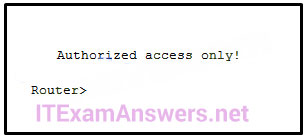
- The banner message is too long.
- The delimiting character appears in the banner message.*
- The symbol “!” signals the end of a banner message.
- Message-of-the-day banners will only appear when a user logs in through the console port.
121. What are three characteristics of an SVI? (Choose three.)
- It is designed as a security protocol to protect switch ports.
- It is not associated with any physical interface on a switch.*
- It is a special interface that allows connectivity by different types of media.
- It is required to allow connectivity by any device at any location.
- It provides a means to remotely manage a switch. *
- It is associated with VLAN1 by default.*
Explain:
Switches have one or more switch virtual interfaces (SVIs). SVIs are
created in software since there is no physical hardware associated with
them. Virtual interfaces provide a means to remotely manage a switch
over a network that is using IP. Each switch comes with one SVI
appearing in the default configuration “out-of-the-box.” The default SVI
interface is VLAN1.
122. A technician configures a switch with these commands:SwitchA(config)# interface vlan 1
SwitchA(config-if)# ip address 192.168.1.1 255.255.255.0
SwitchA(config-if)# no shutdownWhat is the technician configuring?
- Telnet access
- SVI*
- password encryption
- physical switchport access
Explain:
For a switch to have an IP address, a switch virtual interface must be
configured. This allows the switch to be managed remotely over the
network.
123. In computer communication, what is the purpose of message encoding?
- to convert information to the appropriate form for transmission*
- to interpret information
- to break large messages into smaller frames
- to negotiate correct timing for successful communication
Explain:
Before a message is sent across a network it must first be encoded.
Encoding is the process of converting the data message into another
format suitable for transmission across the physical medium. Each bit of
the message is encoded into a pattern of sounds, light waves, or
electrical impulses depending on the network media over which the bits
are transmitted. The destination host receives and decodes the signals
in order to interpret the message.
124. What is a characteristic of multicast messages?
- They are sent to a select group of hosts.*
- They must be acknowledged.
- They are sent to a single destination.
- They are sent to all hosts on a network.
Explain:
Multicast is a one-to-many type of communication. Multicast messages are addressed to a specific multicast group.
125. A large corporation has modified its network to allow users
to access network resources from their personal laptops and smart
phones. Which networking trend does this describe?
- bring your own device*
- video conferencing
- online collaboration
- cloud computing
126. True or False.
A dedicated server is not needed when implementing a peer-to-peer network.
127. Which term refers to a network that provides secure
access to the corporate offices by suppliers, customers and
collaborators?
- Internet
- intranet
- extranet*
- extendednet
Explain:
The term Internet refers to the worldwide collection of connected
networks. Intranet refers to a private connection of LANs and WANS that
belong to an organization and is designed to be accessible to the
members of the organization, employees, or others with authorization.
Extranets provide secure and safe access to suppliers, customers, and
collaborators. Extendednet is not a type of network.
128. What subnet mask is required to support 512 subnets on networks 172.28.0.0/16?
- 255.255.240.0
- 255.255.255.224
- 255.255.255.240
- 255.255.255.128*
- 255.255.252.0
129. A DHCP server is used to IP addresses dynamically to the
hosts on a network. The address pool is configured with 10.29.244.0/25.
There are 19 printers on this network that need to use reserve static
IP addresses from the pool. How many IP address in the pool are left to
be assign to other hosts?
Version 5:
130. What is a function of the data link layer?
- provides the formatting of data
- provides for the exchange of data over a common local media*
- provides end-to-end delivery of data between hosts
- provides delivery of data between two applications
131. Which communication tool allows real-time collaboration?
- wiki
- e-mail
- weblog
- instant messaging*
132. A host is accessing a Web server on a remote network.
Which three functions are performed by intermediary network devices
during this conversation? (Choose three.)
- regenerating data signals*
- acting as a client or a server
- providing a channel over which messages travel
- applying security settings to control the flow of data *
- notifying other devices when errors occur*
- serving as the source or destination of the messages
133. Refer to the exhibit. From which location did this router load the IOS?
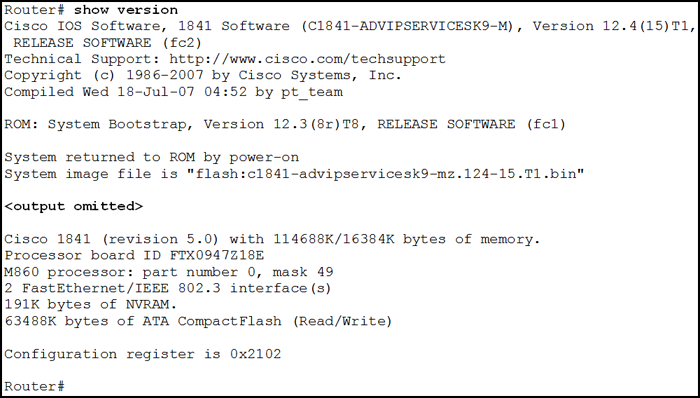
- flash memory*
- NVRAM?
- RAM
- ROM
- a TFTP server?
134. Refer to the exhibit. Which action will be successful?
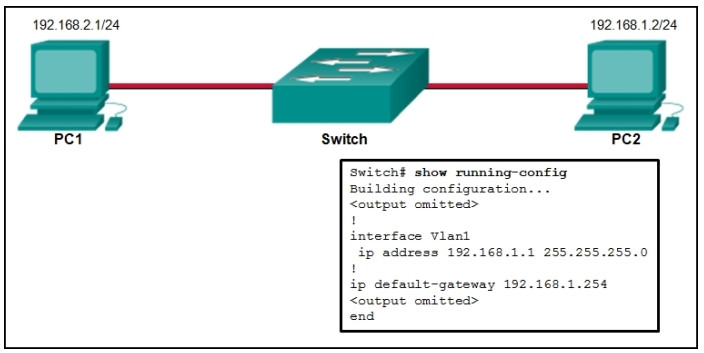
- PC1 can send a ping to 192.168.1.1?.
- PC1 can send a ping to 192.168.1.254?.
- PC2 can send a ping to 192.168.1.1.*
- PC2 can send a ping to 192.168.1.254?.
135. Fill in the blank.
Port numbers ranging from 0 to 1023 are considered to be
Well Known ports.
136. Fill in the blank.
ISOC, IANA, EIA, and IEEE represent
standards organizations which help to promote and maintain an open Internet.
137. Refer to the exhibit. An administrator is trying to
configure the switch but receives the error message that is displayed in
the exhibit. What is the problem?

- The entire command, configure terminal, must be used.
- The administrator is already in global configuration mode.
- The administrator must first enter privileged EXEC mode before issuing the command.*
- The administrator must connect via the console port to access global configuration mode.
138. A company is expanding its business to other countries.
All branch offices must remain connected to corporate headquarters at
all times. Which network technology is required to support this
requirement?
Explain:
A local-area network (LAN) normally connects end users and network
resources over a limited geographic area using Ethernet technology. A
wireless LAN (WLAN) serves the same purpose as a LAN but uses wireless
technologies. A metropolitan-area network (MAN) spans a larger
geographic area such as a city, and a wide-area network (WAN) connects
networks together over a large geographic area. WANs can span cities,
countries, or the globe.
139. A network administrator is upgrading a small business
network to give high priority to real-time applications traffic. What
two types of network services is the network administrator trying to
accommodate? (Choose two.)
- SNMP
- instant messaging
- voice*
- FTP
- video*
140. Match the situation with the appropriate use of network media.
Question
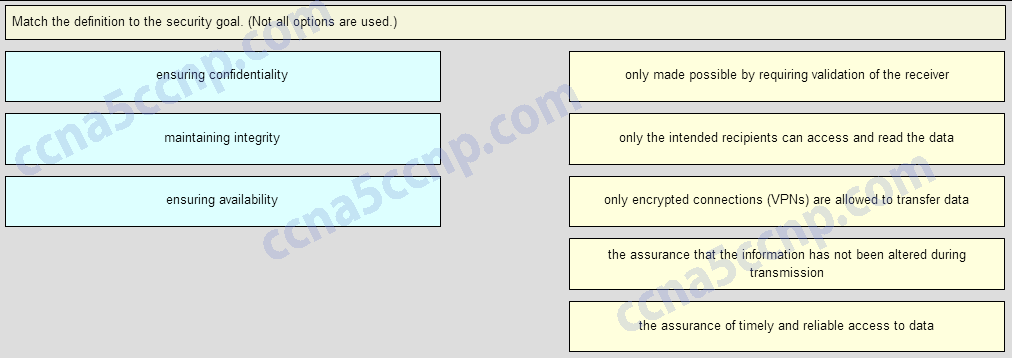 Answer
Answer
CCNA 1 v6.0 Final Exam Answers 2019-2020
- Copper Cables
horizontal cabling structure
desktop PCs in an enterprise office
- Fiber Optic
backbone cabling in an enterprise
long-haul networks
- Wireless
guest access in a coffee shop
waiting rooms in a hospital
Explain:
Copper Cables – horizontal cabling structure and desktop PCs in offices in an enterprise
Fiber optic – backbone cabling in an enterprise and long-haul networks
Wireless – coffee shops and waiting rooms in a hospital
141. Which IPv4 address can be pinged to test the internal TCP/IP operation of a host?
- 0.0.0.0
- 0.0.0.1
- 127.0.0.1*
- 192.168.1.1
- 255.255.255.255
142. What three application layer protocols are part of the TCP/IP protocol suite? (Choose three.)
ARP
143. Which two protocols function at the internet layer? (Choose two)
144. Which publicly available resources describe protocols,
processes, and technologies for the Internet but do not give
implementation details?
- Request for Comments*
- IRTF research papers
- protocol models
- IEEE standards
145. Which address on a PC does not change, even if the PC is moved to a different network?
- IP address
- default gateway address
- MAC address*
- logical address
146. What is the protocol that is used to discover a physical
address from a known logical address and what message type does it use?
- ARP, multicast
- DNS, unicast
- DNS, broadcast
- ARP, broadcast*
- PING, multicast
- PING, broadcast
147. What will happen if the default gateway address is incorrectly configured on a host?
- The host cannot communicate with other hosts in the local network.
- The switch will not forward packets initiated by the host.
- The host will have to use ARP to determine the correct address of the default gateway.
- The host cannot communicate with hosts in other networks.*
- A ping from the host to 127.0.0.1 would not be successful.
148. What is an important function of the physical layer of the OSI model?
- It accepts frames from the physical media.
- It encapsulates upper layer data into frames.
- It defines the media access method performed by the hardware interface.
- It encodes frames into electrical, optical, or radio wave signals.*
149. Which two statements describe the characteristics of fiber-optic cabling? (Choose two.)
- Fiber-optic cabling does not conduct electricity.*
- Fiber-optic cabling has high signal loss.
- Fiber-optic cabling is primarily used as backbone cabling.*
- Multimode fiber-optic cabling carries signals from multiple sending devices.
- Fiber-optic cabling uses LEDs for single-mode cab?les and laser technology for multimode cables.
150. What is contained in the trailer of a data-link frame?
- logical address
- physical address
- data
- error detection*
151. Refer to the exhibit. A ping to PC3 is issued from PC0,
PC1, and PC2 in this exact order. Which MAC addresses will be contained
in the S1 MAC address table that is associated with the Fa0/1 port?
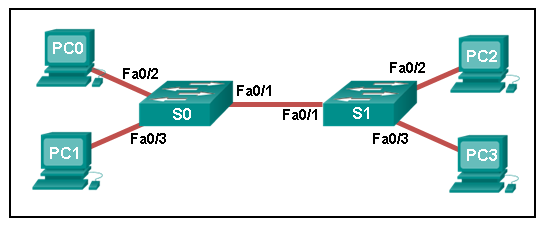
- just PC0 and PC1 MAC addresses*
- just the PC0 MAC address
- PC0, PC1, and PC2 MAC addresses
- just the PC1 MAC address
- just the PC2 MAC address
152. How does a Layer 3 switch differ from a Layer 2 switch?
- A Layer 3 switch supports VLANs, but a Layer 2 switch does not.
- An IP address can be assigned to a physical port of a Layer 3 switch. However, this is not supported in Layer 2 switches.*
- A Layer 3 switch maintains an IP address table instead of a MAC address table.
- A Layer 3 switch learns the MAC addresses that are associated with each of its ports. However, a Layer 2 switch does not.
153. What is the purpose of the routing process?
- to encapsulate data that is used to communicate across a network
- to select the paths that are used to direct traffic to destination networks*
- to convert a URL name into an IP address
- to provide secure Internet file transfer
- to forward traffic on the basis of MAC addresses
154. Which technology provides a solution to IPv4 address depletion by allowing multiple devices to share one public IP address?
- ARP
- DNS
- NAT*
- SMB
- DHCP
- HTTP
155. Refer to the exhibit. Consider the IP address
configuration shown from PC1. What is a description of the default
gateway address?
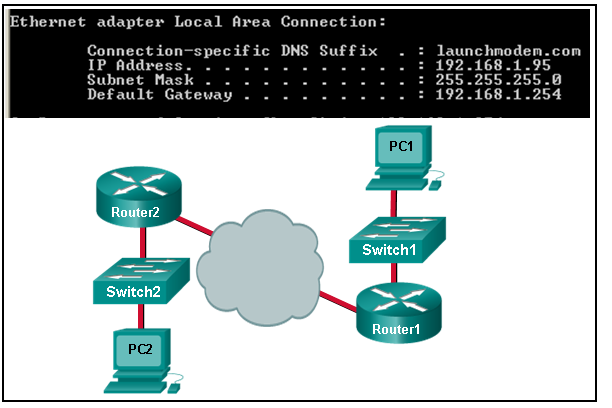
- It is the IP address of the Router1 interface that connects the company to the Internet.
- It is the IP address of the Router1 interface that connects the PC1 LAN to Router1.*
- It is the IP address of Switch1 that connects PC1 to other devices on the same LAN.
- It is the IP address of the ISP network device located in the cloud.
156. Which of the following are primary functions of a router? (Choose two.)
- packet switching*
- microsegmentation
- domain name resolution
- path selection*
- flow control
157. Which two statements correctly describe a router memory type and its contents? (Choose two.)
- ROM is nonvolatile and contains basic diagnostic software.*
- FLASH is nonvolatile and contains a limited portion of the IOS.
- ROM is nonvolatile and stores the running IOS.
- RAM is volatile and stores the IP routing table.*
- NVRAM is nonvolatile and stores other system files.
158. In which default order will a router search for startup configuration information?
- NVRAM, RAM, TFTP
- NVRAM, TFTP, setup mode*
- setup mode, NVRAM, TFTP
- TFTP, ROM, NVRAM
- flash, ROM, setup mode
159. What happens when part of an Internet VoIP transmission is not delivered to the destination?
- A delivery failure message is sent to the source host.
- The part of the VoIP transmission that was lost is re-sent.
- The entire transmission is re-sent.
- The transmission continues without the missing portion.*
160. Which three IP addresses are private ? (Choose three.)
- 10.172.168.1*
- 172.32.5.2
- 192.167.10.10
- 172.20.4.4 *
- 192.168.5.254*
- 224.6.6.6
161. How many bits make up the single IPv6 hextet :10CD:?
162. What is the effect of configuring the ipv6 unicast-routing command on a router?
- to assign the router to the all-nodes multicast group
- to enable the router as an IPv6 router*
- to permit only unicast packets on the router
- to prevent the router from joining the all-routers multicast group
163. Which group of IPv6 addresses cannot be allocated as a host source address?
- FEC0::/10?
- FDFF::/7?
- FEBF::/10?
- FF00::/8*
164. What is the purpose of ICMP messages?
- to inform routers about network topology changes
- to ensure the delivery of an IP packet
- to provide feedback of IP packet transmissions*
- to monitor the process of a domain name to IP address resolution
165. Refer to the exhibit. A technician has configured a user
workstation with the IP address and default subnet masks that are
shown. Although the user can access all local LAN resources, the user
cannot access any Internet sites by using either FQDN or IP addresses.
Based upon the exhibit, what could account for this failure?
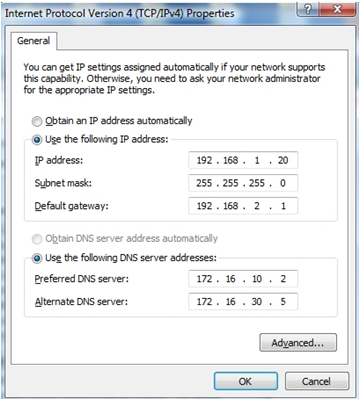
- The DNS server addresses are incorrect.
- The default gateway address in incorrect.*
- The wrong subnet mask was assigned to the workstation.
- The workstation is not in the same network as the DNS servers.
166. A network administrator needs to monitor network traffic
to and from servers in a data center. Which features of an IP
addressing scheme should be applied to these devices?
- random static addresses to improve security
- addresses from different subnets for redundancy
- predictable static IP addresses for easier identification*
- dynamic addresses to reduce the probability of duplicate addresses
167. Refer to the exhibit. Which IP addressing scheme should be changed?
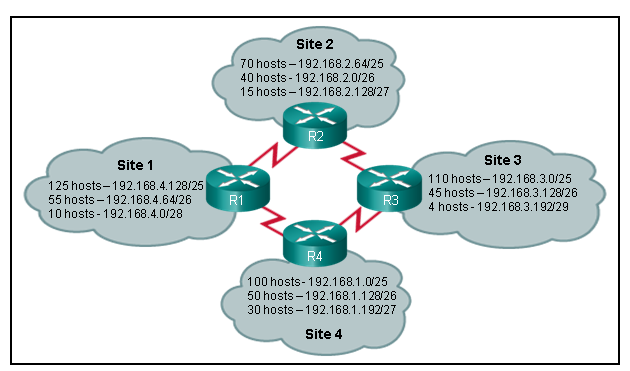
- Site 1
- Site 2*
- Site 3
- Site 4
168. Which two notations are useable nibble boundaries when subnetting in IPv6? (Choose two.)
169. A host PC has just booted and is attempting to lease an
address through DHCP. Which two messages will the client typically
broadcast on the network? (Choose two.)
- DHCPDISCOVER*
- DHCPOFFER
- DHCPREQUEST*
- DHCPACK
- DHCPNACK
170. What is the purpose of the network security accounting function?
- to require users to prove who they are
- to determine which resources a user can access
- to keep track of the actions of a user*
- to provide challenge and response questions
171. Refer to the exhibit. The network administrator enters these commands into the R1 router:
R1# copy running-config tftp
Address or name of remote host [ ]?
When the router prompts for an address or remote host name, what IP address should the administrator enter at the prompt?
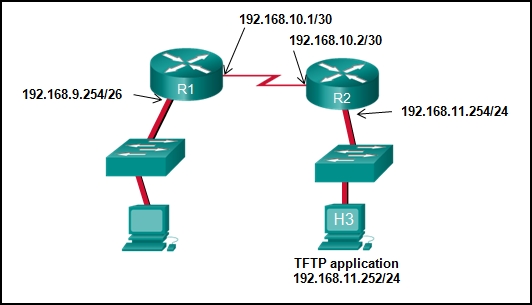
- 192.168.9.254
- 192.168.10.1
- 192.168.10.2
- 192.168.11.252*
- 192.168.11.254
172. Match the IPv6 address to the IPv6 address type. (Not all options are used.)
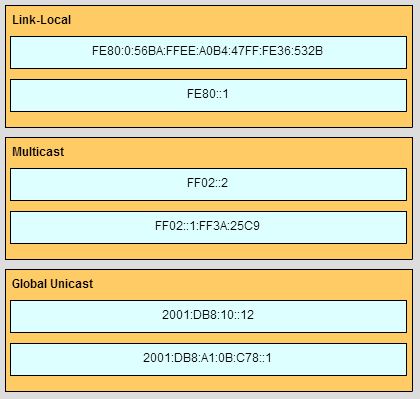 173. What two preconfigured settings that affect security are found on most new wireless routers? (Choose two.)
173. What two preconfigured settings that affect security are found on most new wireless routers? (Choose two.)
- broadcast SSID*
- MAC filtering enabled
- WEP encryption enabled
- PSK authentication required
- default administrator password*
174. Which type of wireless security generates dynamic encryption keys each time a client associates with an AP?
175. Fill in the blank.
TFTP* is a best-effort, connectionless application layer protocol that is used to transfer files.
176. Which two components are necessary for a wireless client to be installed on a WLAN? (Choose two.)
- media
- wireless NIC*
- custom adapter
- crossover cable
- wireless bridge
- wireless client software*
177. Consider the following range of addresses:
2001:0DB8:BC15:00A0:0000::
2001:0DB8:BC15:00A1:0000::
2001:0DB8:BC15:00A2:0000::
…
2001:0DB8:BC15:00AF:0000::
The prefix-length for the range of addresses is
/60*
178. Match the phases to their correct stage in the router bootup process. (Not all options are used.)
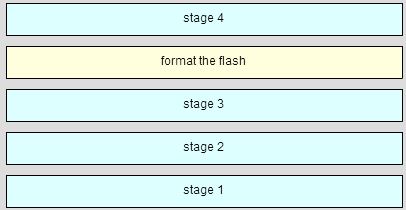 179. A host is accessing an FTP server on a remote network.
Which three functions are performed by intermediary network devices
during this conversation? (Choose three.)
179. A host is accessing an FTP server on a remote network.
Which three functions are performed by intermediary network devices
during this conversation? (Choose three.)
- regenerating data signals*
- acting as a client or a server
- providing a channel over which messages travel
- applying security settings to control the flow of data*
- notifying other devices when errors occur*
- serving as the source or destination of the messages
180. When is a dial-up connection used to connect to an ISP?
- when a cellular telephone provides the service
- when a high-speed connection is provided over a cable TV network
- when a satellite dish is used
- when a regular telephone line is used*
181. On a school network, students are surfing the web,
searching the library database, and attending an audio conference with
their sister school in Japan. If network traffic is prioritized with
QoS, how will the traffic be classified from highest priority to lowest
priority?
- audio conference, database, HTTP*
- database, HTTP, audio conference
- audio conference, HTTP, database
- database, audio conference, HTTP
182. During normal operation, from which location do most Cisco routers run the IOS?
- RAM*
- flash
- NVRAM
- disk drive
183. Which keys act as a hot key combination that is used to interrupt an IOS process?
- Ctrl-Shift-X
- Ctrl-Shift-6*
- Ctrl-Z
- Ctrl-C
184. Refer to the exhibit. An administrator wants to change
the name of a brand new switch, using the hostname command as shown.
What prompt will display after the command is issued??

- HR Switch(config)#?
- Switch(config)#?*
- HRSwitch(config)#?
- HR(config)#?
- Switch#
185. A technician uses the ping 127.0.0.1 command. What is the technician testing?
- the TCP/IP stack on a network host*
- connectivity between two adjacent Cisco devices
- connectivity between a PC and the default gateway
- connectivity between two PCs on the same network
- physical connectivity of a particular PC and the network
186. What is the correct order for PDU encapsulation?
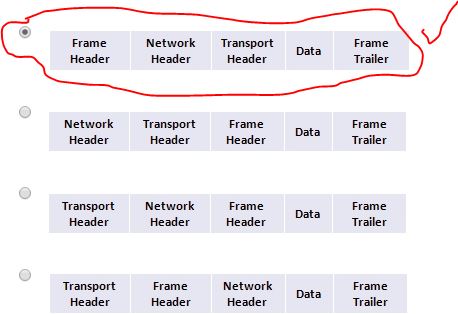 187. Which device should be used for enabling a host to communicate with another host on a different network?
188. A network technician is measuring the transfer of bits
across the company backbone for a mission critical application. The
technician notices that the network throughput appears lower than the
bandwidth expected. Which three factors could influence the differences
in throughput? (Choose three.)
187. Which device should be used for enabling a host to communicate with another host on a different network?
188. A network technician is measuring the transfer of bits
across the company backbone for a mission critical application. The
technician notices that the network throughput appears lower than the
bandwidth expected. Which three factors could influence the differences
in throughput? (Choose three.)
- the amount of traffic that is currently crossing the network*
- the sophistication of the encapsulation method applied to the data
- the type of traffic that is crossing the network*
- the latency that is created by the number of network devices that the data is crossing*
- the bandwidth of the WAN connection to the Internet
- the reliability of the gigabit Ethernet infrastructure of the backbone
189. Which characteristics describe fiber optic cable? (Choose two.)
- It is not affected by EMI or RFI.*
- Each pair of cables is wrapped in metallic foil.
- It combines the technique of cancellation, shielding and twisting to protect data.
- It has a maximum speed of 100 Mbps.
- It is the most expensive type of LAN cabling*
190. What are two features of a physical, star network topology? (Choose two.)
- It is straightforward to troubleshoot.*
- End devices are connected together by a bus.
- It is easy to add and remove end devices.*
- All end devices are connected in a chain to each other.
- Each end system is connected to its respective neighbor.
191. A frame is transmitted from one networking device to
another. Why does the receiving device check the FCS field in the frame?
- to determine the physical address of the sending device
- to verify the network layer protocol information
- to compare the interface media type between the sending and receiving ends
- to check the frame for possible transmission errors*
- to verify that the frame destination matches the MAC address of the receiving device
192. What will a Layer 2 switch do when the destination MAC address of a received frame is not in the MAC table?
- It initiates an ARP request.
- It broadcasts the frame out of all ports on the switch.
- It notifies the sending host that the frame cannot be delivered.
- It forwards the frame out of all ports except for the port at which the frame was received.*
193. Which parameter does the router use to choose the path to the destination when there are multiple routes available?
- the lower metric value that is associated with the destination network*
- the lower gateway IP address to get to the destination network
- the higher metric value that is associated with the destination network
- the higher gateway IP address to get to the destination network
194. Which two statements describe the functions or characteristics of ROM in a router? (Choose two.)
- stores routing tables
- allows software to be updated without replacing pluggable chips on the motherboard
- maintains instructions for POST diagnostics*
- holds ARP cache
- stores bootstrap program*
195. Which statement describes a characteristic of the Cisco router management ports?
- A console port is used for remote management of the router.
- A console port is not used for packet forwarding.*
- Serial and DSL interfaces are types of management ports.
- Each Cisco router has a LED indicator to provide information about the status of the management ports.
196. What happens when part of an Internet radio transmission is not delivered to the destination?
- A delivery failure message is sent to the source host.
- The part of the radio transmission that was lost is re-sent.
- The entire transmission is re-sent.
- The transmission continues without the missing portion.*
197. What types of addresses make up the majority of addresses within the /8 block IPv4 bit space?
- private addresses
- public addresses*
- multicast addresses
- experimental addresses
198. Refer to the exhibit. What is the maximum TTL value that is used to reach the destination www.cisco.com??
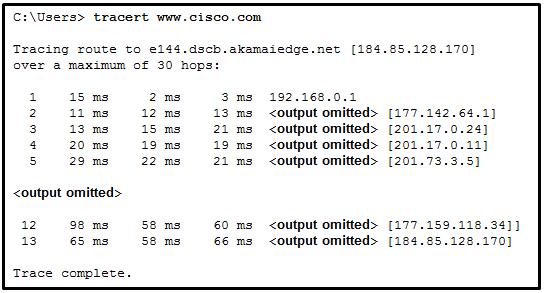 199. A company has a network address of 192.168.1.64 with a
subnet mask of 255.255.255.192. The company wants to create two
subnetworks that would contain 10 hosts and 18 hosts respectively. Which
two networks would achieve that? (Choose two.)
199. A company has a network address of 192.168.1.64 with a
subnet mask of 255.255.255.192. The company wants to create two
subnetworks that would contain 10 hosts and 18 hosts respectively. Which
two networks would achieve that? (Choose two.)
- 192.168.1.16/28
- 192.168.1.64/27*
- 192.168.1.128/27
- 192.168.1.96/28*
- 192.168.1.192/28
200. In a network that uses IPv4, what prefix would best fit a subnet containing 100 hosts?
201. Which protocol supports rapid delivery of streaming media?
- Transmission Control Protocol
- Real-Time Transport Protocol*
- Secure File Transfer Protocol
- Video over Internet Protocol
202. Why would a network administrator use the tracert utility?
- to determine the active TCP connections on a PC
- to check information about a DNS name in the DNS server
- to identify where a packet was lost or delayed on a network*
- to display the IP address, default gateway, and DNS server address for a PC
203. Refer to the exhibit. What is the significance of the asterisk (*) in the exhibited output?

- The asterisk shows which file system was used to boot the system.
- The asterisk designates which file system is the default file system.*
- An asterisk indicates that the file system is bootable.
- An asterisk designates that the file system has at least one file that uses that file system.
204. Which WLAN security protocol generates a new dynamic key each time a client establishes a connection with the AP?
205. Fill in the blank.
Point-to-point communications where both devices can transmit and receive on the medium at the same time are known as
full-duplex
206. Match each characteristic to the appropriate email protocol. (Not all options are used.)
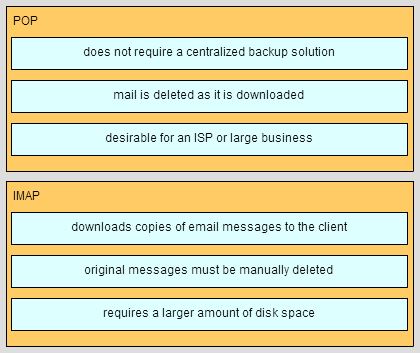 207. A host is accessing a Telnet server on a remote network.
Which three functions are performed by intermediary network devices
during this conversation? (Choose three.)
207. A host is accessing a Telnet server on a remote network.
Which three functions are performed by intermediary network devices
during this conversation? (Choose three.)
- regenerating data signals*
- acting as a client or a server
- providing a channel over which messages travel
- applying security settings to control the flow of data*
- notifying other devices when errors occur*
- serving as the source or destination of the messages
208. Refer to the exhibit. Which area would most likely be an extranet for the company network that is shown?
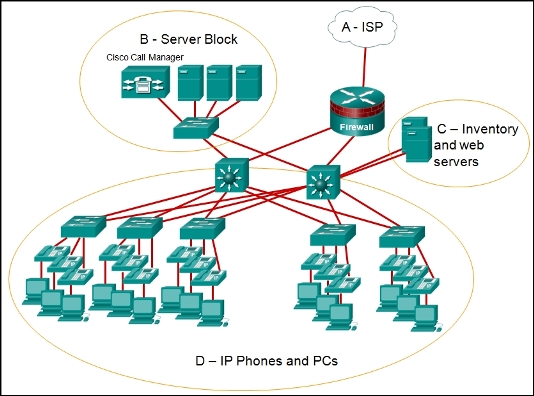
- area A
- area B
- area C*
- area D
209. Three office workers are using the corporate network.
The first employee uses a web browser to view a company web page in
order to read some announcements. The second employee accesses the
corporate database to perform some financial transactions. The third
employee participates in an important live audio conference with other
office workers in branch offices. If QoS is implemented on this network,
what will be the priorities from highest to lowest of the different
data types?
- audio conference, financial transactions, web page*
- financial transactions, web page, audio conference
- audio conference, web page, financial transactions
- financial transactions, audio conference, web page
Explain:
QoS mechanisms enable the establishment of queue management strategies
that enforce priorities for different categories of application data.
Thus, this queuing enables voice data to have priority over transaction
data, which has priority over web data.
210. During normal operation, from which location do most Cisco switches and routers run the IOS?
- RAM*
- flash
- NVRAM
- disk drive
211. A network administrator is making changes to the
configuration of a router. After making the changes and verifying the
results, the administrator issues the copy running-config startup-config
command. What will happen after this command executes?
- The configuration will be copied to flash.
- The configuration will load when the router is restarted.*
- The new configuration file will replace the IOS file.
- The changes will be lost when the router restarts.
212. What information does the loopback test provide?
- The TCP/IP stack on the device is working correctly.*
- The device has end-to-end connectivity.
- DHCP is working correctly.
- The Ethernet cable is working correctly.
- The device has the correct IP address on the network.
213. What happens when a switch receives a frame and the
calculated CRC value is different than the value that is in the FCS
field?
- The switch places the new CRC value in the FCS field and forwards the frame.
- The switch notifies the source of the bad frame.
- The switch drops the frame.*
- The switch floods the frame to all ports except the port through which the frame arrived to notify the hosts of the error.
214. Which destination address is used in an ARP request frame?
- 0.0.0.0
- 255.255.255.255
- FFFF.FFFF.FFFF*
- 127.0.0.1
- 01-00-5E-00-AA-23
215. What is the auto-MDIX feature on a switch?
- the automatic configuration of an interface for 10/100/1000 Mb/s operation
- the automatic configuration of an interface for a straight-through or a crossover Ethernet cable connection*
- the automatic configuration of full-duplex operation over a single Ethernet copper or optical cable
- the ability to turn a switch interface on or off accordingly if an active connection is detected
216. What are the two main components of Cisco Express Forwarding (CEF)? (Choose two.)
- adjacency tables*
- MAC-address tables
- routing tables
- ARP tables
- forwarding information base (FIB)*
217. Which statement describes the sequence of processes
executed by a router when it receives a packet from a host to be
delivered to a host on another network?
- It receives the packet and forwards it directly to the destination host.
- It de-encapsulates the packet,
selects the appropriate path, and encapsulates the packet to forward it
toward the destination host*
- It de-encapsulates the packet and forwards it toward the destination host.
- It selects the path and forwards it toward the destination host.
218. Refer to the exhibit. Router R1 has two interfaces that
were configured with correct IP addresses and subnet masks. Why does the
show ip route command output not display any information about the
directly connected networks??
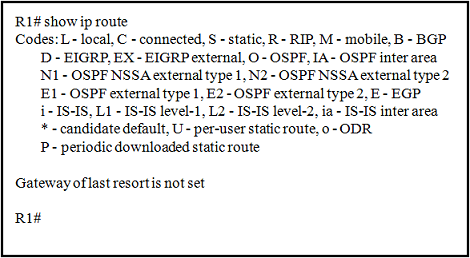
- The directly connected networks have to be created manually to be displayed in the routing table.
- The routing table will only display information about these networks when the router receives a packet.
- The no shutdown command was not issued on these interfaces.*
- The gateway of last resort was not configured.
219. What happens when part of an Internet television transmission is not delivered to the destination?
- A delivery failure message is sent to the source host.
- The part of the television transmission that was lost is re-sent.
- The entire transmission is re-sent.
- The transmission continues without the missing portion.*
220. Which three statements characterize the transport layer protocols? (Choose three.)
- TCP and UDP port numbers are used by application layer protocols.*
- TCP uses port numbers to provide reliable transportation of IP packets.
- UDP uses windowing and acknowledgments for reliable transfer of data.
- TCP uses windowing and sequencing to provide reliable transfer of data.*
- TCP is a connection-oriented protocol. UDP is a connectionless protocol.*
221. Which statement is true regarding the UDP client process during a session with a server?
- Datagrams that arrive in a different order than that in which they were sent are not placed in order.*
- A session must be established before datagrams can be exchanged.
- A three-way handshake takes place before the transmission of data begins.
- Application servers have to use port numbers above 1024 in order to be UDP capable.
222. Which two components are configured via software in order for a PC to participate in a network environment? (Choose two.)
- MAC address
- IP address*
- kernel
- shell
- subnet mask*
223. Which two reasons generally make DHCP the preferred
method of assigning IP addresses to hosts on large networks? (Choose
two.)
- It eliminates most address configuration errors.*
- It ensures that addresses are only applied to devices that require a permanent address.
- It guarantees that every device that needs an address will get one.
- It provides an address only to devices that are authorized to be connected to the network.
- It reduces the burden on network support staff.*
224. What is the subnet address for the address 2001:DB8:BC15:A:12AB::1/64?
- 2001:DB8:BC15::0
- 2001:DB8:BC15:A::0*
- 2001:DB8:BC15:A:1::1
- 2001:DB8:BC15:A:12::0
225. What is the purpose of the network security authentication function?
- to require users to prove who they are*
- to determine which resources a user can access
- to keep track of the actions of a user
- to provide challenge and response questions
226. Which type of wireless security makes use of dynamic encryption keys each time a client associates with an AP?
227. Launch PT – Hide and Save PT.
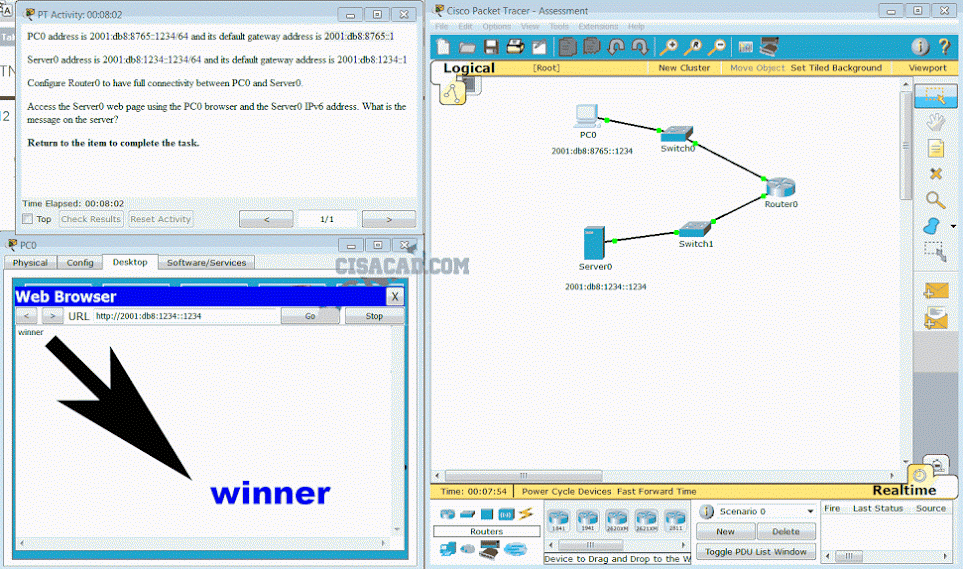
Open the PT activity. Perform the tasks in the activity instructions and then fill in the blank.
The Server0 message isb ”
winner”
228. Which field in an IPv4 packet header will typically stay the same during its transmission?
- Packet Length
- Destination Address*
- Flag
- Time-to-Live
229. Launch PT – Hide and Save PT
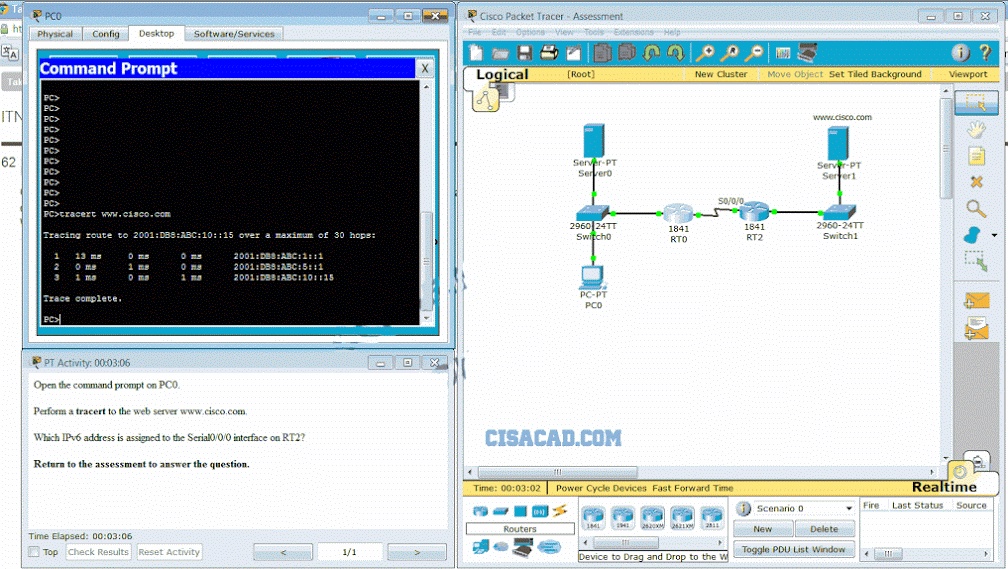 Open the PT Activity. Perform the tasks in the activity
instructions and then answer the question. Which IPv6 address is
assigned to the Serial0/0/0 interface on RT2?
Open the PT Activity. Perform the tasks in the activity
instructions and then answer the question. Which IPv6 address is
assigned to the Serial0/0/0 interface on RT2?
- 2001:db8:abc:1::1
- 2001:db8:abc:5::1*
- 2001:db8:abc:5::2
- 2001:db8:abc:10::15
230. What must be configured to enable Cisco Express Forwarding (CEF) on most Cisco devices that perform Layer 3 switching?
- Manually configure next-hop Layer 2 addresses.
- Issue the no shutdown command on routed ports.
- CEF is enabled by default, so no configuration is necessary.*
- Manually map Layer 2 addresses to Layer 3 addresses to populate the forwarding information base (FIB).
231. What is the purpose of adjacency tables as used in Cisco Express Forwarding (CEF)?
- to populate the forwarding information base (FIB)
- to maintain Layer 2 next-hop addresses*
- to allow the separation of Layer 2 and Layer 3 decision making
- to update the forwarding information base (FIB)
232. Which statement describes a characteristic of the network layer in the OSI model?
- It manages the data transport between the processes running on each host.
- In the encapsulation process, it adds source and destination port numbers to the IP header.
- When a packet arrives at the destination host, its IP header is
checked by the network layer to determine where the packet has to be
routed.
- Its protocols specify the packet structure and processing used to carry the data from one host to another.*
233. A user gets an IP address of 192.168.0.1 from the
company network administrator. A friend of the user at a different
company gets the same IP address on another PC. How can two PCs use the
same IP address and still reach the Internet, send and receive email,
and search the web?
- Both users must be using the same Internet Service Provider.
- ISPs use Network Address Translation to change a user IP address into an address that can be used on the Internet.*
- ISPs use Domain Name Service to change a user IP address into a public IP address that can be used on the Internet.
- Both users must be on the same network.
234. Why does HTTP use TCP as the transport layer protocol?
- to ensure the fastest possible download speed
- because HTTP is a best-effort protocol
- because transmission errors can be tolerated easily
- because HTTP requires reliable delivery*
235. What is the valid most compressed format possible of the IPv6 address 2001:0DB8:0000:AB00:0000:0000:0000:1234?
- 2001:DB8:0:AB00::1234*
- 2001:DB8:0:AB::1234
- 2001:DB8::AB00::1234
- 2001:DB8:0:AB:0:1234
236. What field content is used by ICMPv6 to determine that a packet has expired?
- TTL field
- CRC field
- Hop Limit field*
- Time Exceeded field
237. Which firewall technique blocks incoming packets unless they are responses to internal requests?
- port filtering
- stateful packet inspection*
- URL filtering
- application filtering
238. A network technician is investigating network
connectivity from a PC to a remote host with the address 10.1.1.5. Which
command issued on the PC will return to the technician the complete
path to the remote host?
- trace 10.1.1.5
- traceroute 10.1.1.5
- tracert 10.1.1.5*
- ping 10.1.1.5
239. Fill in the blank.
To prevent faulty network devices from carrying dangerous voltage levels, equipment must be grounded *correctly
240. What is a possible hazard that can be caused by network cables in a fire?
- The cable insulation could be flammable.*
- Users could be exposed to excessive voltage.
- Network cables could be exposed to water.
- The network cable could explode.
241. What device is commonly used to verify a UTP cable?
- a multimeter
- an Optical Time Domain Reflectometer
- a cable tester*
- an ohmmeter
242. What needs to be checked when testing a UTP network cable?
- capacitance
- wire map*
- inductance
- flexibility
243. Refer to the exhibit. A ping to PC2 is issued from PC0,
PC1, and PC3 in this exact order. Which MAC addresses will be contained
in the S1 MAC address table that is associated with the Fa0/1 port?
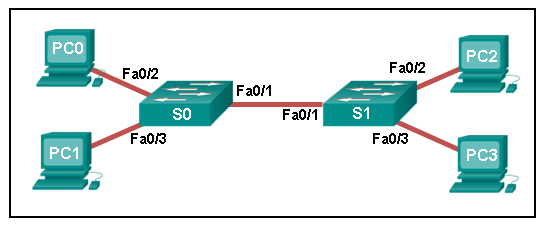
- just PC0 and PC1 MAC addresses*
- just the PC0 MAC address
- PC0, PC1, and PC2 MAC addresses
- just the PC1 MAC address
- just the PC2 MAC address
244. Which function is provided by TCP?
- data encapsulation
- detection of missing packets*
- communication session control
- path determination for data packets
245. What does a router use to determine where to send data it receives from the network?
- an ARP table
- a routing table*
- the destination PC physical address
- a switching table
246. Which router interface should be used for direct remote access to the router via a modem?
- an inband router interface
- a console port
- a serial WAN interface
- an AUX port*
247. A technician is configuring a router to allow for all
forms of management access. As part of each different type of access,
the technician is trying to type the command login. Which configuration
mode should be entered to do this task?
- user executive mode
- global configuration mode
- any line configuration mode*
- privileged EXEC mode
248. Which three statements characterize the transport layer protocols? (Choose three.)
- TCP and UDP port numbers are used by application layer protocols.*
- TCP uses port numbers to provide reliable transportation of IP packets.
- UDP uses windowing and acknowledgments for reliable transfer of data.
- TCP uses windowing and sequencing to provide reliable transfer of data.*
- TCP is a connection-oriented protocol. UDP is a connectionless protocol.*
249. Refer to the exhibit. A TCP segment from a server has
been captured by Wireshark, which is running on a host. What
acknowledgement number will the host return for the TCP segment that has
been received?
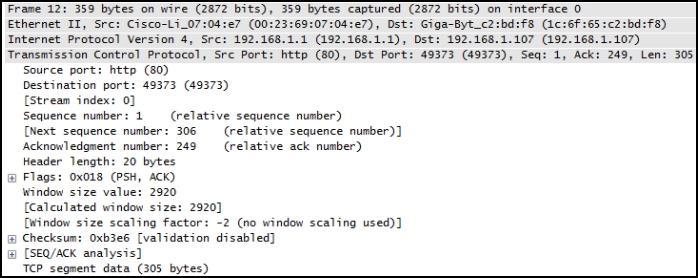 250. Which statement is true about an interface that is configured with the IPv6 address command?
250. Which statement is true about an interface that is configured with the IPv6 address command?
- IPv6 traffic-forwarding is enabled on the interface.
- A link-local IPv6 address is automatically configured on the interface.*
- A global unicast IPv6 address is dynamically configured on the interface.
- Any IPv4 addresses that are assigned to the interface are replaced with an IPv6 address.
251. Refer to the exhibit. An administrator must send a
message to everyone on the router A network. What is the broadcast
address for network 172.16.16.0/22?

- 172.16.16.255
- 172.16.20.255
- 172.16.19.255*
- 172.16.23.255
- 172.16.255.255
252. A network administrator is variably subnetting a given
block of IPv4 addresses. Which combination of network addresses and
prefix lengths will make the most efficient use of addresses when the
need is for 2 subnets capable of supporting 10 hosts and 1 subnet that
can support 6 hosts?
- 10.1.1.128/28
10.1.1.144/28
10.1.1.160/29*
- 10.1.1.128/28
10.1.1.144/28
10.1.1.160/28
- 10.1.1.128/28
10.1.1.140/28
10.1.1.158/26
- 10.1.1.128/26
10.1.1.144/26
10.1.1.160/26
- 10.1.1.128/26
10.1.1.140/26
10.1.1.158/28
253. How many additional bits should be borrowed from a /26
subnet mask in order to create subnets for WAN links that need only 2
useable addresses?
254. A network administrator requires access to manage
routers and switches locally and remotely. Match the description to the
access method. (Not all options are used.)
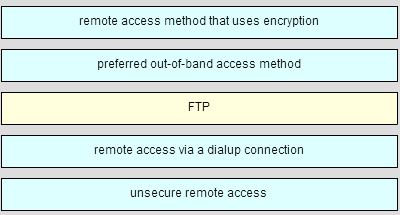 255. Refer to the exhibit. The administrator configured the
access to the console and the vty lines of a router. Which conclusion
can be drawn from this configuration?
255. Refer to the exhibit. The administrator configured the
access to the console and the vty lines of a router. Which conclusion
can be drawn from this configuration?
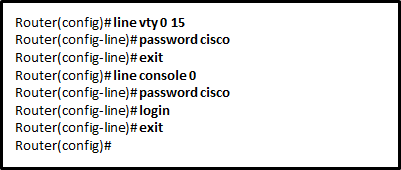
- Unauthorized individuals can connect to the router via Telnet without entering a password.
- Because the IOS includes the
login command on the vty lines by default, access to the device via
Telnet will require authentication.*
- Access to the vty lines will not be allowed via Telnet by anyone.
- Because the login command was omitted, the password cisco command is not applied to the vty lines.
256. An administrator issued the service password-encryption
command to apply encryption to the passwords configured for enable
password, vty, and console lines. What will be the consequences if the
administrator later issues the no service password-encryption command?
- It will remove encryption from all passwords.
- It will reverse only the vty and console password encryptions.
- It will not reverse any encryption.*
- It will reverse only the enable password encryption.
257. After making configuration changes, a network
administrator issues a copy running-config startup-config command in a
Cisco switch. What is the result of issuing this command?
- The new configuration will be stored in flash memory.
- The new configuration will be loaded if the switch is restarted.*
- The current IOS file will be replaced with the newly configured file.
- The configuration changes will be removed and the original configuration will be restored.
258. What are two features of ARP? (Choose two.)
- If a host is ready to send a
packet to a local destination device and it has the IP address but not
the MAC address of the destination, it generates an ARP broadcast.*
- An ARP request is sent to all devices on the Ethernet LAN and
contains the IP address of the destination host and its multicast MAC
address.
- When a host is encapsulating a packet into a frame, it refers to the
MAC address table to determine the mapping of IP addresses to MAC
addresses.
- If no device responds to the ARP request, then the originating node
will broadcast the data packet to all devices on the network segment.
- If a device receiving an ARP request has the destination IPv4 address, it responds with an ARP reply.*
259. A network administrator is enabling services on a newly
installed server. Which two statements describe how services are used on
a server? (Choose two.)
- Data sent with a service that uses TCP is received in the order the data was sent.
- A port is considered to be open when it has an active server application that is assigned to it.*
- An individual server can have two services that are assigned to the same port number.
- An individual server cannot have multiple services running at the same time.
- Server security can be improved by closing ports that are associated with unused services.*
260. Given the binary address of 11101100 00010001 00001100
00001010, which address does this represent in dotted decimal format?
- 234.17.10.9
- 234.16.12.10
- 236.17.12.6
- 236.17.12.10*
261. A particular telnet site does not appear to be
responding on a Windows 7 computer. What command could the technician
use to show any cached DNS entries for this web page?
- ipconfig /all
- arp -a
- ipconfig /displaydns*
- nslookup
262. Fill in the blank.
Network devices come in two physical configurations. Devices
that have expansion slots that provide the flexibility to add new
modules have a Modular * configuration.
263. Refer to the exhibit. What is the maximum TIL value that is used to reach the destination www.cisco.com?
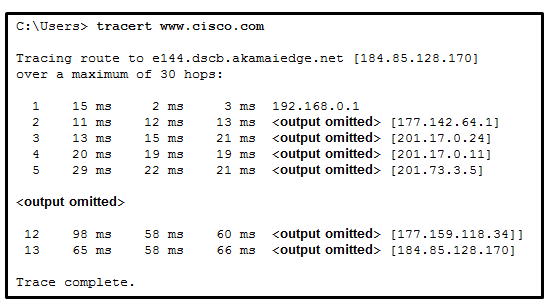 264. Which statement is true about DHCP operation?
264. Which statement is true about DHCP operation?
- When a device that is
configured to use DHCP boots, the client broadcasts a DHCPDISCOVER
message to identify any available DHCP servers on the network.*
- A client must wait for lease expiration before it sends another DHCPREOUEST message.
- The DHCPDISCOVER message contains the IP address and sub net masK to
be assigned, the IP address of the DNS server, and the IP address of
the default gateway.
- If the client receives several DHCPOFFER messages from different
servers, it sends a unicast DHCPREOUEST message to the server from which
it chooses to obtain the IP information.
265. Which type of wireless security is easily compromised?
266. A network administrator notices that the throughput on
the network appears lower than expected when compared to the end-to-end
network bandwidth. Which three factors can explain this difference?
(Choose three.)
- the amount of traffic*
- the type of data encapsulation in use
- the type of traffic*
- the number and type of network devices that the data is crossing*
- the bandwidth of the connection to the ISP
- the reliability of the network backbone
267. A host PC is attempting to lease an address through
DHCP. What message is sent by the server to the client know it is able
to use the provided IP information?
- DHCPDISCOVER
- DHCPOFFER*
- DHCPPREQUEST
- DHCPACK
- DHCPNACK
268. A network administrator is configuring access control to
switch SW1. If the administrator uses console line to connect to the
switch, which password is needed to access user EXEC mode?
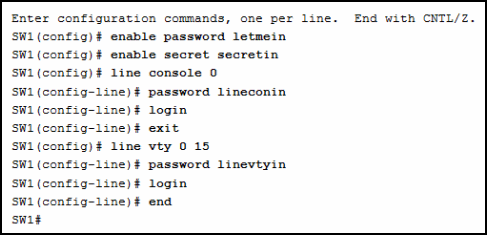
- letmein
- secretin
- lineconin*
- linevtyin
Explain:
Telnet accesses a network device through the virtual interface
configured with the line VTY command. The password configured under this
is required to access the user EXEC mode. The password configured under
the line console 0 command is required to gain entry through the
console port, and the enable and enable secret passwords are used to
allow entry into the privileged EXEC mode.
269. How many bits would need to be borrowed if a network admin
were given the IP addressing scheme of 172.16.0.0/16 and needed no more
than 16 subnet with equal number of hosts?
270. Question:
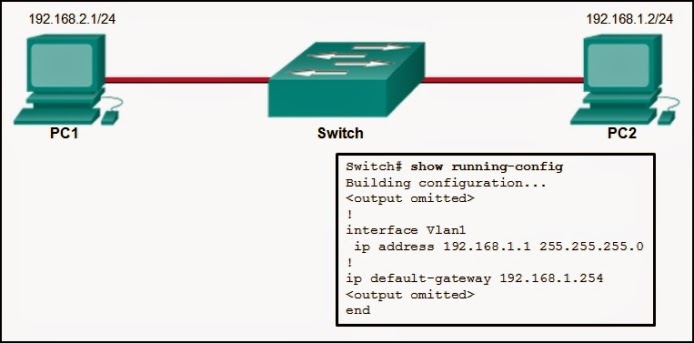
It will give 4 options about ping, the correct one is:
The PC2 will be able to ping 192.168.1.1*
271. Which statement best describes the operation of the File Transfer Protocol?
- An FTP client uses a source port number of 21 and a randomly
generated destination port number during the establishment of control
traffic with an FTP Server.
- An FTP client uses a source port number of 20 and a randomly
generated destination port number during the establishment of data
traffic with an FTP Server.
- An FTP server uses a source
port number of 20 and a randomly generated destination port number
during the establishment of control traffic with an FTP client.*
- An FTP server uses a source port number of 21 and a randomly
generated destination port number during the establishment of control
traffic with an FTP client.
272. A client is establishing a TCP session with a server.
How is the acknowledgment number in the response segment to the client
determined?
- The acknowledgment number
field is modified by adding 1 to the randomly chosen initial sequence
number in response to the client.*
- The acknowledgment number is set to 11 to signify an acknowledgment packet and synchronization packet back to the client.
- The acknowledgment number field uses a random source port number in response to the client.
- The acknowledgment number is set to 1 to signify an acknowledgment packet back to the client.
273. Why does layer 3 device perform the ANDing process on a destination IP and subnet Mask?
- to identify host address and destination host;
- to identify network address of destination host;*
- to identify faulty frames;
- to identify broadcast address of destination network;
274. There was also a question about if you activated service
password encryption in the past and you prompt “no service password
encryption” what password are modified ?
- no password at all;*
- password of the lines are in clear;
- login password;
- ?
275. What type of communication rule would best describe CSMA/CD?
- message encapsulation
- flow control
- message encoding
- access method*
276. What is the primary reason to subnet IPv6 prefixes?
- to conserve IPv6 addresses
- to avoid wasting IPv6 addresses
- to conserve IPv6 prefixes
- to create a hierarchical Layer 3 network design*
277. Which statement describes data throughput?
- It is the measure of the bits transferred across the media under perfect conditions.
- It is the measure of the bits transferred across the media over a given period of time.*
- It indicates the capacity of a particular medium to carry data.
- It is the guaranteed data transfer rate offered by an ISP.
278. Fill in the blank. Use a number.
IPv4 multicast addresses are directly mapped to IEEE 802 (Ethernet) MAC addresses using the last ___
4___ of the 28 available bits in the IPv4 multicast group address.
279. How could a faulty network device create a source of hazard for a user? (Choose two.)
- It could stop functioning.*
- It could apply dangerous voltage to other pieces of equipment.
- It could explode.*
- It could produce an unsafe electromagnetic field.
- It could apply dangerous voltage to itself.
280. What are three important considerations when planning the structure of an IP addressing scheme? (Choose three.)
- preventing duplication of addresses*
- providing and controlling access*
- documenting the network
- monitoring security and performance
- conserving addresses*
- implementing new services
281. What is the metric value that is used to reach the
10.1.1.0 network in the following routing table entry? D 10.1.1.0/24
[90/2170112] via 209.165.200.226, 00:00:05, Serial0/0/0
282. Which two services or protocols use the preferred UDP protocol for fast transmission and low overhead? (Choose two)
New Questions (v6.0):
283. What action does a DHCPv4 client take if it receives more than one DHCPOFFER from multiple DHCP servers?
- It sends a DHCPREQUEST that identifies which lease offer the client is accepting.*
- It sends a DHCPNAK and begins the DHCP process over again.
- It discards both offers and sends a new DHCPDISCOVER.
- It accepts both DHCPOFFER messages and sends a DHCPACK.
284. To what legacy address class does the address 10.0.0.0 belong?
- Class B
- Class D
- Class A*
- Class C
- Class E
285. How many IPv4 addresses are available to be assigned to hosts on a network that has a mask of 255.255.255.248?
286. What type of communication medium is used with a wireless LAN connection?
- radio waves*
- fiber
- microwave
- UTP
287. Which method of IPv6 prefix assignment relies on the prefix contained in RA messages?
- EUI-64
- static
- SLAAC*
- stateful DHCPv6
288. What is a characteristic of DNS?
- DNS servers can cache recent queries to reduce DNS query traffic.*
- DNS servers are programmed to drop requests for name translations that are not within their zone.
- All DNS servers must maintain mappings for the entire DNS structure.
- DNS relies on a hub-and-spoke topology with centralized servers.
289. What is the prefix for the host address 2001:DB8:BC15:A:12AB::1/64?
- 2001:DB8:BC15
- 2001:DB8:BC15:A*
- 2001:DB8:BC15:A:1
- 2001:DB8:BC15:A:12
290. What information is maintained in the CEF adjacency table?
- Layer 2 next hops
- MAC address to IPv4 address mappings*
- IP address to interface mappings
- the IP addresses of all neighboring routers
291. Which command can an administrator issue on a Cisco router to send debug messages to the vty lines?
- terminal monitor*
- logging console
- logging buffered
- logging synchronous
Explain:
Debug messages, like other IOS log messages, are sent to the console
line by default. Sending these messages to the terminal lines requires
the terminal monitor command.
292. What is an example of a top-level domain?
- root.cisco.com
- http://www.cisco.com
- .com*
- cisco.com
Explain:
Top-level domains represent a country or type of organization, such as .com or .edu.
293. Which protocol requires the establishment of a session between sender and receiver hosts prior to transmitting data?
294. Which two protocols operate at the top layer of the TCP/IP protocol suite? (Choose two.)
- TCP
- IP
- UDP
- POP
- DNS
- Ethernet
295. What does a client do when it has UDP datagrams to send?
- It sends to the server a segment with the SYN flag set to synchronize the conversation.
- It just sends the datagrams.*
- It queries the server to see if it is ready to receive data.
- It sends a simplified three-way handshake to the server.
296. What is a characteristic of multicast messages?
- They are sent to all hosts on a network.
- They must be acknowledged.
- They are sent to a select group of hosts.*
- They are sent to a single destination.
297. Which protocol or service uses UDP for a client-to-server communication and TCP for server-to-server communication?
298. In what networking model would eDonkey, eMule, BitTorrent, Bitcoin, and LionShare be used?
- master-slave
- client-based
- peer-to-peer *
- point-to-point
Introduction to Networks (Version 7.00) – Final Exam Answers Full
1. An employee of a large corporation remotely logs into the
company using the appropriate username and password. The employee is
attending an important video conference with a customer concerning a
large sale. It is important for the video quality to be excellent during
the meeting. The employee is unaware that after a successful login, the
connection to the company ISP failed. The secondary connection,
however, activated within seconds. The disruption was not noticed by the
employee or other employees.
What three network characteristics are described in this scenario? (Choose three.)
- security
- quality of service
- scalability
- powerline networking
- integrity
- fault tolerance
2. What are two characteristics of IP? (Choose two.)
- does not require a dedicated end-to-end connection *
- operates independently of the network media*
- retransmits packets if errors occur
- re-assembles out of order packets into the correct order at the receiver end
- guarantees delivery of packets
Explain:
The Internet Protocol (IP) is a connectionless, best effort protocol.
This means that IP requires no end-to-end connection nor does it
guarantee delivery of packets. IP is also media independent, which means
it operates independently of the network media carrying the packets.
3. A company has a file server that shares a folder named
Public. The network security policy specifies that the Public folder is
assigned Read-Only rights to anyone who can log into the server while
the Edit rights are assigned only to the network admin group. Which
component is addressed in the AAA network service framework?
- automation
- accounting
- authentication
- authorization





















































































































